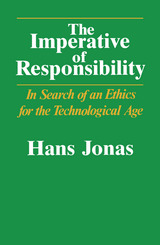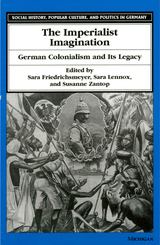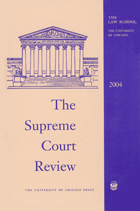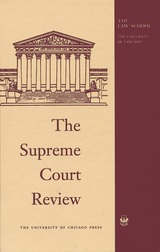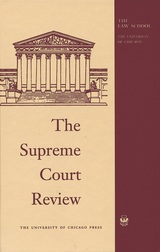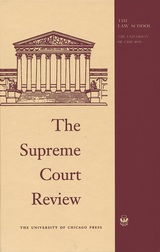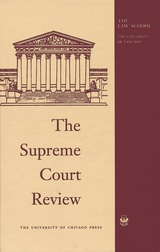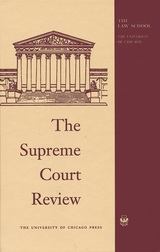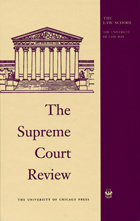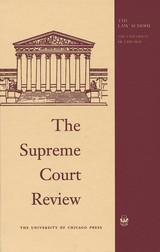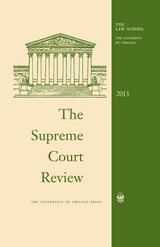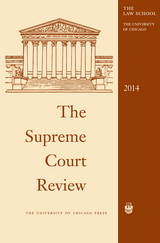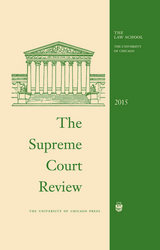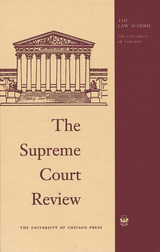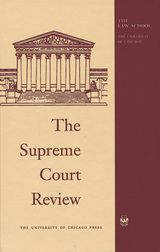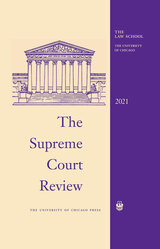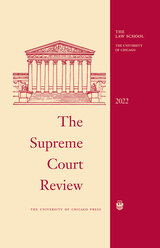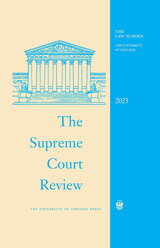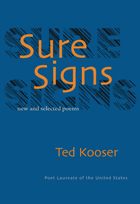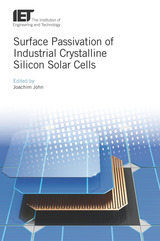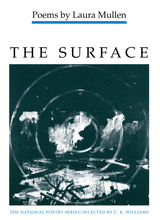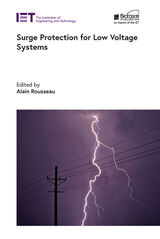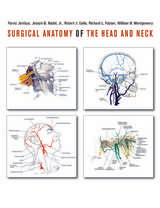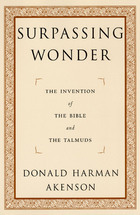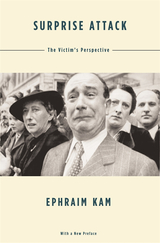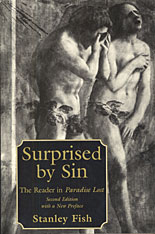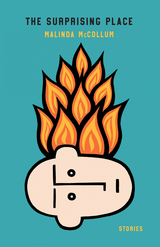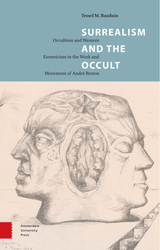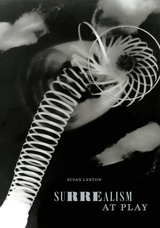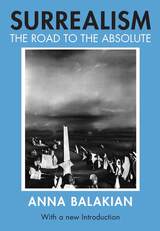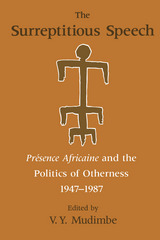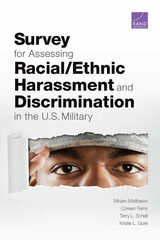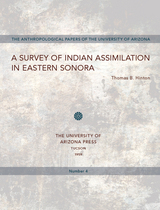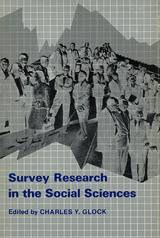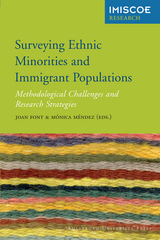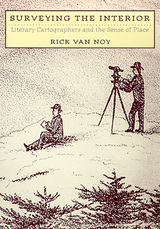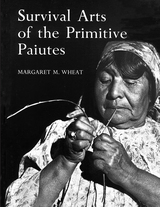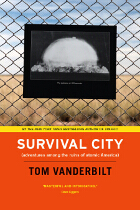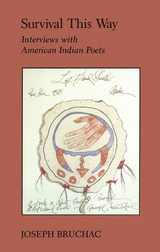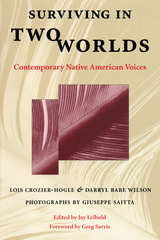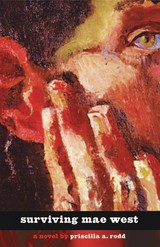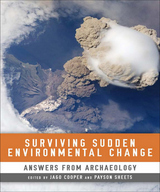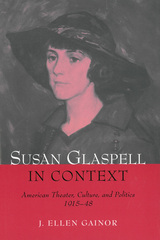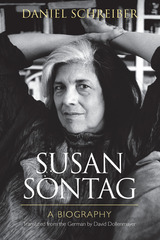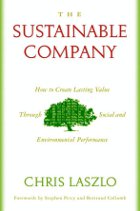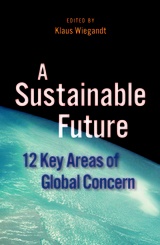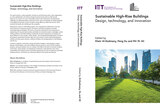The Supreme Court Review, 2004
Edited by Dennis J. Hutchinson, David A. Strauss, and Geoffrey R. Stone
University of Chicago Press Journals, 2005 Since its inception in 1960, The Supreme Court Review has been lauded for providing authoritative discussions of the Court's most significant decisions. Distinguished participants hereanalyze current and previous public issues and sentiments and discuss the implications of court decisions.
The Supreme Court Review, 2005
Edited by Dennis J. Hutchinson, David A. Strauss, and Geoffrey R. Stone
University of Chicago Press Journals, 2006 For forty-five years The Supreme Court Review has been lauded for providing authoritative discussion of the Court’s most significant decisions. Recent volumes have considered issues such as the 2000 presidential election, cross-burning, federalism and state sovereignty, the United States v. American Library Association case, and numerous First and Fourth amendment cases. Distinguished participants analyze current and previous concerns and attitudes and discuss the implications of court decisions.
The Supreme Court Review, 2006
Edited by Dennis J. Hutchinson, David A. Strauss, and Geoffrey R. Stone
University of Chicago Press Journals, 2007 For forty-five years The Supreme Court Review has been lauded for providing authoritative discussion of the Court’s most significant decisions. Recent volumes have considered issues such as the 2000 presidential election, cross-burning, federalism and state sovereignty, the United States v. American Library Association case, and numerous First and Fourth amendment cases.
The Supreme Court Review, 2007
Edited by Dennis J. Hutchinson, David A. Strauss, and Geoffrey R. Stone
University of Chicago Press Journals, 2008 For forty-five years, The Supreme Court Review has been lauded for providing authoritative discussion of the Court’s most significant decisions. Recent volumes have considered such issues as the 2000 presidential election, cross burning, federalism and state sovereignty, the United States v. American Library Association case, failed Supreme Court nominations, and numerous First and Fourth amendment cases.
The Supreme Court Review, 2008
Edited by Dennis J. Hutchinson, David A. Strauss, and Geoffrey R. Stone
University of Chicago Press Journals, 2009 For forty-eight years, The Supreme Court Review has been lauded for providing authoritative discussion of the Court’s most significant decisions. The Review is an in-depth annual critique of the Supreme Court and its work, at the forefront of studies of the origins, reforms, and interpretations of American law. Recent volumes have considered such issues as the 2000 presidential election, cross burning, federalism and state sovereignty, the United States v. American Library Association case, failed Supreme Court nominations, and numerous First and Fourth amendment cases.
The Supreme Court Review, 2009
Edited by Dennis J. Hutchinson, David A. Strauss, and Geoffrey R. Stone
University of Chicago Press Journals, 2010 For forty-nine years, the Supreme Court Review has been lauded for providing authoritative discussion of the Court’s most significant decisions. The Review is an in-depth annual critique of the Supreme Court and its work, one that strives to keep on the forefront of the origins, reforms, and interpretations of American law. Recent volumes have considered such issues as the 2000 presidential election, cross burning, federalism and state sovereignty, the United States v. American Library Association case, failed Supreme Court nominations, and numerous First and Fourth amendment cases.
The Supreme Court Review, 2011
Edited by Dennis J. Hutchinson, David A. Strauss, and Geoffrey R. Stone
University of Chicago Press Journals, 2012 For fifty years, The Supreme Court Review has been lauded for providing authoritative discussion of the Court’s most significant decisions. The Review is an in-depth annual critique of the Supreme Court and its work, keeping up on the forefront of the origins, reforms, and interpretations of American law. Recent volumes have considered such issues as post-9/11 security, the 2000 presidential election, cross burning, federalism and state sovereignty, failed Supreme Court nominations, and numerous First and Fourth amendment cases.
The Supreme Court Review, 2012
Edited by Dennis J. Hutchinson, David A. Strauss, and Geoffrey R. Stone
University of Chicago Press Journals, 2013 For fifty years, The Supreme Court Review has been lauded for providing authoritative discussion of the court's most significant decisions. The Review is an in-depth annual critique of the Supreme Court and its work, keeping up on the forefront of the origins, reforms, and interpretations of American law. Recent volumes have considered such issues as post-9/11 security, the 2000 presidential election, cross-burning, federalism and state sovereignty, failed Supreme Court nominations, and numerous First- and Fourth-Amendment cases.
The Supreme Court Review, 2013
Edited by Dennis J. Hutchinson, David A. Strauss, and Geoffrey R. Stone
University of Chicago Press Journals, 2014 For fifty years, The Supreme Court Review has been lauded for providing authoritative discussion of the Court's most significant decisions. The Review is an in-depth annual critique of the Supreme Court and its work, keeping up on the forefront of the origins, reforms, and interpretations of American law. Recent volumes have considered such issues as post-9/11 security, the 2000 presidential election, cross burning, federalism and state sovereignty, failed Supreme Court nominations, the battles concerning same-sex marriage, and numerous First and Fourth amendment cases.
The Supreme Court Review, 2014
Edited by Dennis J. Hutchinson, David A. Strauss, and Geoffrey R. Stone
University of Chicago Press Journals, 2015 For more than fifty years, The Supreme Court Review has been lauded for providing authoritative discussion of the Court's most significant decisions. An in-depth annual critique of the Supreme Court and its work, The Supreme Court Review keeps at the forefront of the reforms and interpretations of American law. Recent volumes have considered such issues as post-9/11 security, the 2000 presidential election, cross burning, federalism and state sovereignty, failed Supreme Court nominations, the battles concerning same-sex marriage, and numerous First and Fourth Amendment cases.
The Supreme Court Review, 2015
Edited by Dennis J. Hutchinson, David A. Strauss, and Geoffrey R. Stone
University of Chicago Press Journals, 2016 For more than fifty years, The Supreme Court Review has won acclaim for providing a sustained and authoritative survey of the implications of the Court's most significant decisions. The Supreme Court Review is an in-depth annual critique of the Supreme Court and its work, keeping up on the forefront of the origins, reforms, and interpretations of American law. It is written by and for legal academics, judges, political scientists, journalists, historians, economists, policy planners, and sociologists.
The Supreme Court Review, 2016
Edited by Dennis J. Hutchinson, David A. Strauss, and Geoffrey R. Stone
University of Chicago Press Journals, 2017 For more than fifty years, The Supreme Court Review has won acclaim for providing a sustained and authoritative survey of the implications of the Court’s most significant decisions. The Supreme Court Review is an in-depth annual critique of the Supreme Court and its work, keeping up on the forefront of the origins, reforms, and interpretations of American law. It is written by and for legal academics, judges, political scientists, journalists, historians, economists, policy planners, and sociologists.
The Supreme Court Review, 2017
Edited by Dennis J. Hutchinson, David A. Strauss, and Geoffrey R. Stone
University of Chicago Press Journals, 2018 Since it first appeared in 1960, The Supreme Court Review (SCR) has won acclaim for providing a sustained and authoritative survey of the implications of the Court's most significant decisions. SCR is an in-depth annual critique of the Supreme Court and its work, keeping up on the forefront of the origins, reforms, and interpretations of American law. SCR is written by and for legal academics, judges, political scientists, journalists, historians, economists, policy planners, and sociologists.
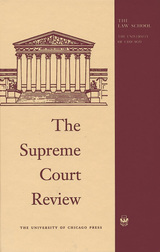 The Supreme Court Review, 2018
Edited by David A. Strauss, Geoffrey R. Stone, and Justin Driver
University of Chicago Press Journals, 2019 Since it first appeared in 1960, The Supreme Court Review (SCR) has won acclaim for providing a sustained and authoritative survey of the implications of the Court's most significant decisions. SCR is an in-depth annual critique of the Supreme Court and its work, keeping up on the forefront of the origins, reforms, and interpretations of American law. SCR is written by and for legal academics, judges, political scientists, journalists, historians, economists, policy planners, and sociologists.
This year’s volume features prominent scholars assessing major legal events, including:
Mark Tushnet on President Trump’s “Muslim Ban”
Kate Andrias on Union Fees in the Public Sector
Cass R. Sunstein on Chevron without Chevron
Tracey Maclin on the Fourth Amendment and Unauthorized Drivers
Frederick Schauer on Precedent
Pamela Karlan on Gay Equality and Racial Equality
Randall Kennedy on Palmer v. Thompson
Lisa Marshall Manheim and Elizabeth G. Porter on Voter Suppression
Melissa Murray on Masterpiece Cakeshop
Vikram David Amar on Commandeering
Laura K. Donohue on Carpenter, Precedent, and Originalism
Evan Caminker on Carpenter and Stability
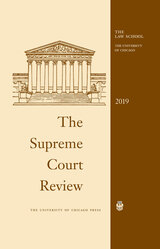 The Supreme Court Review, 2019
Edited by David A. Strauss, Geoffrey R. Stone, and Justin Driver
University of Chicago Press Journals, 2020 Since it first appeared in 1960, The Supreme Court Review (SCR) has won acclaim for providing a sustained and authoritative survey of the implications of the Court's most significant decisions. SCR is an in-depth annual critique of the Supreme Court and its work, keeping up on the forefront of the origins, reforms, and interpretations of American law. SCR is written by and for legal academics, judges, political scientists, journalists, historians, economists, policy planners, and sociologists.
This year’s volume features incisive assessments of major legal events, including:
Gillian E. Metzger on The Roberts Court's Administrative Law
Paul Butler on Peremptory Strikes in Mississippi v. Flowers
Nicholas O. Stephanopoulos on Partisan Gerrymandering
Kent Greenfield on Hate Speech
Jennifer M. Chacon on Department of Commerce v. New York
Micah Schwartzman & Nelson Tebbe on Establishment Clause Appeasement
William Baude on Precedent and Originalism
Linda Greenhouse on The Supreme Court’s Challenge to Civil Society
James T. Kloppenberg on James Madison
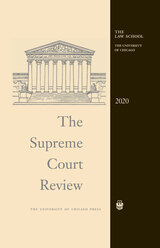 The Supreme Court Review, 2020
Edited by David A. Strauss, Geoffrey R. Stone, and Justin Driver
University of Chicago Press Journals, 2021 Since it first appeared in 1960, The Supreme Court Review (SCR) has won acclaim for providing a sustained and authoritative survey of the implications of the Court's most significant decisions. SCR is an in-depth annual critique of the Supreme Court and its work, keeping up on the forefront of the origins, reforms, and interpretations of American law. SCR is written by and for legal academics, judges, political scientists, journalists, historians, economists, policy planners, and sociologists.
This year’s volume features incisive assessments of major legal events, including:
Cristina M. Rodríguez on the Political Significance of Law
Martha Minow on Little Sisters of the Poor
Cass R. Sunstein and Adrian Vermeule on the Unitary Executive
Cary Franklin on Living Textualism
David A. Strauss on Sexual Orientation and the Dynamics of Discrimination
Saikrishna Bangalore Prakash on the Executive’s Privileges and Immunities
Reva B. Siegel on Abortion Restrictions
Maggie Blackhawk on McGirt v. Oklahoma
Richard J. Lazarus on Advocacy History
The Supreme Court Review, 2021
Edited by David A. Strauss, Geoffrey R. Stone, Justin Driver, and William Baude
University of Chicago Press Journals, 2022 The latest volume in the Supreme Court Review series.
Since it first appeared in 1960, the Supreme Court Review has won acclaim for providing a sustained and authoritative survey of the implications of the Court's most significant decisions. SCR is an in-depth annual critique of the Supreme Court and its work, analyzing the origins, reforms, and modern interpretations of American law. SCR is written by and for legal academics, judges, political scientists, journalists, historians, economists, policy planners, and sociologists.
The Supreme Court Review, 2022
Edited by David A. Strauss, Geoffrey R. Stone, Justin Driver, and William Baude
University of Chicago Press Journals, 2023 An annual peer-reviewed law journal covering the legal implications of decisions by the Supreme Court of the United States.
Since it first appeared in 1960, the Supreme Court Review has won acclaim for providing a sustained and authoritative survey of the implications of the Court's most significant decisions. SCR is an in-depth annual critique of the Supreme Court and its work, analyzing the origins, reforms, and modern interpretations of American law. SCR is written by and for legal academics, judges, political scientists, journalists, historians, economists, policy planners, and sociologists.
The Supreme Court Review, 2023
Edited by David A. Strauss, Geoffrey R. Stone, Justin Driver, and William Baude
University of Chicago Press Journals, 2024 An annual peer-reviewed law journal covering the legal implications of decisions by the Supreme Court of the United States.
Since it first appeared in 1960, the Supreme Court Review (SCR) has won acclaim for providing a sustained and authoritative survey of the implications of the Court’s most significant decisions. SCR is an in-depth annual critique of the Supreme Court and its work, analyzing the origins, reforms, and modern interpretations of American law. SCR is written by and for legal academics, judges, political scientists, journalists, historians, economists, policy planners, and sociologists.
The Supreme Court Review, 2024
Edited by David A. Strauss, Geoffrey R. Stone, Justin Driver, and William Baude
University of Chicago Press Journals, 2025 An annual peer-reviewed law journal covering the legal implications of decisions by the Supreme Court of the United States.
Since it first appeared in 1960, The Supreme Court Review (SCR) has won acclaim for providing a sustained and authoritative survey of the implications of the Court’s most significant decisions. SCR is an in-depth annual critique of the Supreme Court and its work, analyzing the origins, reforms, and modern interpretations of American law. SCR is written by and for legal academics, judges, political scientists, journalists, historians, economists, policy planners, and sociologists.
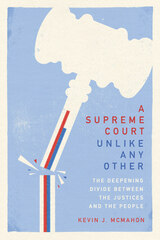 A Supreme Court Unlike Any Other: The Deepening Divide Between the Justices and the People
Kevin J. McMahon
University of Chicago Press, 2024 A data-rich examination of the US Supreme Court's unprecedented detachment from the democratic processes that buttress its legitimacy. Today’s Supreme Court is unlike any other in American history. This is not just because of its jurisprudence but also because the current Court has a tenuous relationship with the democratic processes that help establish its authority. Historically, this “democracy gap” was not nearly as severe as it is today. Simply put, past Supreme Courts were constructed in a fashion far more in line with the promise of democracy—that the people decide and the majority rules. Drawing on historical and contemporary data alongside a deep knowledge of court battles during presidencies ranging from FDR to Donald Trump, Kevin J. McMahon charts the developments that brought us here. McMahon offers insight into the altered politics of nominating and confirming justices, the shifting pool of Supreme Court hopefuls, and the increased salience of the Court in elections. A Supreme Court Unlike Any Other is an eye-opening account of today’s Court within the context of US history and the broader structure of contemporary politics.
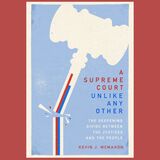 A Supreme Court Unlike Any Other: The Deepening Divide Between the Justices and the People
Kevin J. McMahon
University of Chicago Press, 2024 This is an auto-narrated audiobook version of this book.
A data-rich examination of the US Supreme Court's unprecedented detachment from the democratic processes that buttress its legitimacy. Today’s Supreme Court is unlike any other in American history. This is not just because of its jurisprudence but also because the current Court has a tenuous relationship with the democratic processes that help establish its authority. Historically, this “democracy gap” was not nearly as severe as it is today. Simply put, past Supreme Courts were constructed in a fashion far more in line with the promise of democracy—that the people decide and the majority rules. Drawing on historical and contemporary data alongside a deep knowledge of court battles during presidencies ranging from FDR to Donald Trump, Kevin J. McMahon charts the developments that brought us here. McMahon offers insight into the altered politics of nominating and confirming justices, the shifting pool of Supreme Court hopefuls, and the increased salience of the Court in elections. A Supreme Court Unlike Any Other is an eye-opening account of today’s Court within the context of US history and the broader structure of contemporary politics.
 Supreme Courts Under Nazi Occupation
Derk Venema
Amsterdam University Press, 2023 This is the first extensive treatment of leading judicial institutions under Nazi rule in WWII. It focusses on all democratic countries under German occupation, and provides the details for answering questions like: how can law serve as an instrument of defence against an oppressive regime? Are the courts always the guardians of democracy and rule of law? What role was there for international law? How did the courts deal with dismissals, new appointees, new courts, forced German ordinances versus national law? How did judges justify their actions, help citizens, appease the enemy, protest against injustice? Experts from all democracies that were occupied by the Nazis paint vivid pictures of oppression, collaboration, and resistance. The results are interpreted in a socio-legal framework introducing the concept of ‘moral hygiene’ to explain the clash between normative and descriptive approaches in public opinion and scholarship concerning officials’ behaviour in war-time.
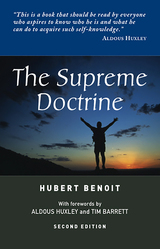 The Supreme Doctrine: Psychological Studies in Zen Thought (Second Edition)
Hubert Benoit
Sussex Academic Press, 2022 History and anthropology make it abundantly clear that societies composed of individuals who think, feel, believe and act according to the most preposterous conventions can survive for long periods of time. Statistical normality is perfectly compatible with a high degree of folly and wickedness. In so far as he is a psychotherapist, the Oriental philosopher tries to help statistically normal individuals to become normal in the other, more fundamental sense of the word. This process of intellectual and psycho-physical adjustment to the Nature of Things is the supreme doctrine of Zen Buddhism, which Dr Benoit discusses in the light of Western psychological theory and Western psychiatric practise. This is a book that should be read by everyone who aspires to know who he is and what he can do to acquire such self-knowledge. From the Foreword by Aldous Huxley The Supreme Doctrine is a cogent statement of what Zen thought had to offer the practising Western psychiatrist. This is a book which assuredly still speaks for itself. T. H. Barrett, SOAS, University of London
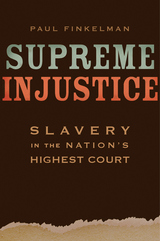 Supreme Injustice: Slavery in the Nation’s Highest Court
Paul Finkelman
Harvard University Press, 2018 The three most important Supreme Court Justices before the Civil War—Chief Justices John Marshall and Roger B. Taney and Associate Justice Joseph Story—upheld the institution of slavery in ruling after ruling. These opinions cast a shadow over the Court and the legacies of these men, but historians have rarely delved deeply into the personal and political ideas and motivations they held. In Supreme Injustice, the distinguished legal historian Paul Finkelman establishes an authoritative account of each justice’s proslavery position, the reasoning behind his opposition to black freedom, and the incentives created by circumstances in his private life.
Finkelman uses census data and other sources to reveal that Justice Marshall aggressively bought and sold slaves throughout his lifetime—a fact that biographers have ignored. Justice Story never owned slaves and condemned slavery while riding circuit, and yet on the high court he remained silent on slave trade cases and ruled against blacks who sued for freedom. Although Justice Taney freed many of his own slaves, he zealously and consistently opposed black freedom, arguing in Dred Scott that free blacks had no Constitutional rights and that slave owners could move slaves into the Western territories. Finkelman situates this infamous holding within a solid record of support for slavery and hostility to free blacks.
Supreme Injustice boldly documents the entanglements that alienated three major justices from America’s founding ideals and embedded racism ever deeper in American civic life.
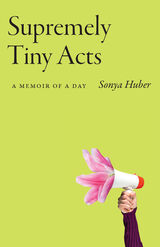 Supremely Tiny Acts: A Memoir of a Day
Sonya Huber
Ohio State University Press, 2021 Winner (Bronze, Autobiography & Memoir), 2021 Foreword Indies Awards
“I think we have to get to the real, to catch the facts we have, to hold on to what we see. . . .in this time where lies are currency,” Sonya Huber writes in her book-length essay Supremely Tiny Acts: A Memoir of a Day. On the theory that naming the truths of quotidian experience can counter the dangerous power of lies, she carefully recounts two anxiety-fueled days one fall. On the first, she is arrested as part of a climate protest in Times Square. On the other, she must make it to her court appearance while also finding time to take her son to get his learner's permit. Paying equal attention to minor details, passing thoughts, and larger political concerns around activism and parenting in the Trump-era United States, Huber asks: How can one simultaneously be a good mother, a good worker, and a good citizen? As she reflects on the meaning of protest and on whiteness and other forms of privilege within political activism, Huber offers a wry, self-aware, and stirring testament to the everyday as a seedbed for meaningful change.
 Suq: Geertz on the Market
Clifford Geertz
HAU, 2022 A formative ethnography of the relationship between markets and social life, back in print.
Originally published in 1979, Clifford Geertz’s essay on the Moroccan bazaar is a classic ethnographic account of the interplay of economic, social, and religious lives in the bustle of transaction. Drawing on years of fieldwork in the Middle Atlas town of Sefrou, Geertz explores how actors from diverse backgrounds assess the worth and meaning of other people’s wares, words, and ways of doing business. He shows how the search for market information, so central to the theorization of markets by economists, is here based on careful appraisals of social relations, embedded in understandings of the broader institutional environment of the market town and its hinterlands. With a richness of insights procured for generations of readers, Geertz’s essay on the sūq is a model of and for the craft of ethnographic theory. Long out of print, it is republished here in a stand-alone edition introduced by Lawrence Rosen.
SUR
David Koehn
Omnidawn, 2024 Poetry that explores wildness and composes a landscape of complex human emotions.
Drawing on a range of stylistic influences, the poetry of Sur takes on the essence of connection and the ways in which we continually develop meaning about others and to the natural world. With this collection, David Koehn paints a landscape where wilderness intertwines with human emotions and grows between ill-fitting interpersonal connections. Sur invites readers to step back and look critically at their world while remaining intimately intertwined with it. Throughout, imagery of nature—like a snake drinking from a stream, or a mountain god—blends with the emotional landscape of tumultuous relationships, exploring themes of wildness and an inevitable unraveling of secrets.
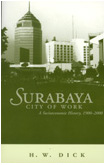 Surabaya, City of Work: A Socioeconomic History, 1900–2000
Howard Dick
Ohio University Press, 2002 Surabaya is Indonesia’s second largest city but is not well known to the outside world. Yet in 1900, Surabaya was a bigger city than Jakarta and one of the main commercial centers of Asia. Collapse of sugar exports during the 1930s depression, followed by the Japanese occupation, revolution, and independence, brought on a long period of stagnation and retreat from the international economy. Not until the export boom of the 1990s did Surabaya regain prominence as Southeast Asia’s leading non–capital–city industrial area. Previous thinking on Indonesia is being reassessed in light of recent political and economic upheaval. Surabaya, City of Work offers an alternative to the Jakarta-centric focus of most writing on the country. It is a multifaceted view of a fascinating and complex city in the dimensions of time and space, economy and society, and the current transition toward decentralization makes it highly topical. Exploration of this eventful economic history gives new insight into Indonesia’s modern economic development. Industrialization is recognized as being associated with rapid urbanization, but this is the first study of Indonesia from an explicitly urban perspective. Surabaya, City of Work takes a broad approach that links industrialization to socioeconomic trends, the increasing role of government, changing land use, and trade patterns. This well–illustrated local history encompassing national events and trends will be a central work on Indonesia for years to come.
Sure Signs: New and Selected Poems
Ted Kooser
University of Pittsburgh Press, 1980 Named U.S. Poet Laureate for 2004-2006, Ted Kooser is one of America's masters of the short metaphorical poem. Dana Gioia has remarked that Kooser has written more perfect poems than any poet of his generation. Long admired and praised by other poets, Kooser is also accesible to the reader not familiar with contemporary poetry.
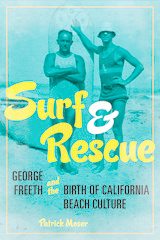 Surf and Rescue: George Freeth and the Birth of California Beach Culture
Patrick Moser
University of Illinois Press, 2022 The mixed-race Hawaiian athlete George Freeth brought surfing to Venice, California, in 1907. Over the next twelve years, Freeth taught Southern Californians to surf and swim while creating a modern lifeguard service that transformed the beach into a destination for fun, leisure, and excitement. Patrick Moser places Freeth’s inspiring life story against the rise of the Southern California beach culture he helped shape and define. Freeth made headlines with his rescue of seven fishermen, an act of heroism that highlighted his innovative lifeguarding techniques. But he also founded California's first surf club and coached both male and female athletes, including Olympic swimming champion and “father of modern surfing” Duke Kahanamoku. Often in financial straits, Freeth persevered as a teacher and lifeguarding pioneer--building a legacy that endured long after his death during the 1919 influenza pandemic. A compelling merger of biography and sports history, Surf and Rescue brings to light the forgotten figure whose novel way of seeing the beach sparked the imaginations of people around the world.
 Surf Texas
By Kenny Braun
University of Texas Press, 2014 The urge to ride a wave, the search for the next perfect swell, is an enduring preoccupation that draws people to coastlines around the world. In recent decades, surfing has grown into a multimillion-dollar industry with over three million surfers in the United States alone and an international competitive circuit that draws top surfers to legendary beaches in Hawaii, California, and Australia. But away from the crowds and the hype, dedicated surfers catch waves in places like the Texas Gulf Coast for the pure pleasure of being in harmony with life, their sport, and the ocean. Kenny Braun knows that primal pleasure, as both a longtime Texas surfer and a fine art photographer who has devoted years to capturing the surf culture on Texas beaches. In Surf Texas, he presents an eloquent photo essay that portrays the enduring fascination of surfing, as well as the singular and sometimes unexpected beauty of the coast. Texas is one of the top six surfing states in America, and Braun uses evocative black-and-white photography to reveal the essence of the surfers’ world from Galveston to South Padre. His images catch the drama of shooting the waves, those moments of skill and daring as riders rip across the breaking face, as well as the downtime of bobbing on swells like seabirds and hanging out on the beach with friends. Braun also photographs the place—beaches and dunes, skies and storms, surf shops, motels, and parking lots—with a native’s knowing eye for defining details. Elegant and timeless, this vision of the Texas Coast is redolent of sea breezes and salt air and the memories and dreams they evoke. Surfer or not, everyone who feels the primeval attraction of wind and waves will enjoy Surf Texas.
 Surface Encounters: Thinking with Animals and Art
Ron Broglio
University of Minnesota Press, 2011 What it is like to be an animal? Ron Broglio wants to know from the inside, from underneath the fur and feathers. In examining this question, he bypasses the perspectives of biology or natural history to explore how one can construct an animal phenomenology, to think and feel as an animal other—or any other. Until now phenomenology has grappled with how humans are embedded in their world. According to philosophical tradition, animals do not practice the self-reflexive thought that provides humans with depth of being. Without human interiority, philosophers have believed, animals live on the surface of things. But, Broglio argues, the surface can be a site of productive engagement with the world of animals, and as such he turns to humans who work with surfaces: contemporary artists. Taking on the negative claim of animals living only on the surface and turning the premise into a positive set of possibilities for human–animal engagement, Broglio considers artists—including Damien Hirst, Carolee Schneemann, Olly and Suzi, and Marcus Coates—who take seriously the world of the animal on its own terms. In doing so, these artists develop languages of interspecies expression that both challenge philosophy and fashion new concepts for animal studies.
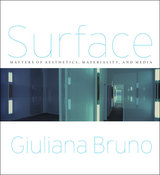 Surface: Matters of Aesthetics, Materiality, and Media
Giuliana Bruno
University of Chicago Press, 2014 What is the place of materiality—the expression or condition of physical substance—in our visual age of rapidly changing materials and media? How is it fashioned in the arts or manifested in virtual forms? In Surface, cultural critic and theorist Giuliana Bruno deftly explores these questions, seeking to understand materiality in the contemporary world.
Arguing that materiality is not a question of the materials themselves but rather the substance of material relations, Bruno investigates the space of those relations, examining how they appear on the surface of different media—on film and video screens, in gallery installations, or on the skins of buildings and people. The object of visual studies, she contends, goes well beyond the image and engages the surface as a place of contact between people and art objects. As Bruno threads through these surface encounters, she unveils the fabrics of the visual—the textural qualities of works of art, whether manifested on canvas, wall, or screen. Illuminating the modern surface condition, she notes how façades are becoming virtual screens and the art of projection is reinvented on gallery walls. She traverses the light spaces of artists Robert Irwin, James Turrell, Tacita Dean, and Anthony McCall; touches on the textured surfaces of Isaac Julien’s and Wong Kar-wai’s filmic screens; and travels across the surface materiality in the architectural practices of Diller Scofidio + Renfro and Herzog & de Meuron to the art of Doris Salcedo and Rachel Whiteread, where the surface tension of media becomes concrete. In performing these critical operations on the surface, she articulates it as a site in which different forms of mediation, memory, and transformation can take place.
Surveying object relations across art, architecture, fashion, design, film, and new media, Surface is a magisterial account of contemporary visual culture.
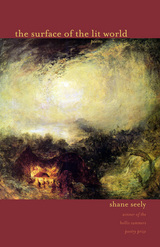 The Surface of the Lit World: Poems
Shane Seely
Ohio University Press, 2015 In The Surface of the Lit World, Shane Seely draws on a wide range of sources—from personal memory to biblical narrative—to explore the stories that we tell ourselves about ourselves, the ways in which we make meaning of our lives. Seely delves into the ways in which family and environment shape us. Poems ranging from terse, meditative lyrics to more direct narratives examine the relationship between what lies visible on the lit surface and what lies just beneath. In addition to first-person autobiographical narratives, there are ekphrastic poems; poems that explore narratives from mythology and religion; and poems based on news reports, radio stories, and audio recordings. Regardless of the approach, the central questions are the same: How do we sense the world we live in? What do the institutions to which we turn for meaning—family, religion, art, literature, science—offer us, and in what ways do they fail us? The answers may depend on where we dare to look.
Surface Passivation of Industrial Crystalline Silicon Solar Cells
Joachim John
The Institution of Engineering and Technology, 2019 Surface passivation of silicon solar cells describes a technology for preventing electrons and holes to recombine prematurely with one another on the wafer surface. It increases the cell's energy conversion efficiencies and thus reduces the cost per kWh generated by a PV system.
The Surface: POEMS
Laura Mullen
University of Illinois Press, 1991 Selected by C. K. Williams as one of the five volumes published in 1991 in the National Poetry Series, The Surface was the first collection in Laura Mullen's acclaimed career.
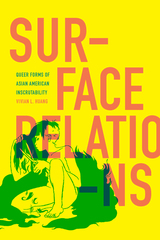 Surface Relations: Queer Forms of Asian American Inscrutability
Vivian L. Huang
Duke University Press, 2022 In Surface Relations Vivian L. Huang traces how Asian and Asian American artists have strategically reworked the pernicious stereotype of inscrutability as a dynamic antiracist, feminist, and queer form of resistance. Following inscrutability in literature, visual culture, and performance art since 1965, Huang articulates how Asian American artists take up the aesthetics of Asian inscrutability—such as invisibility, silence, unreliability, flatness, and withholding—to express Asian American life. Through analyses of diverse works by performance artists (Tehching Hsieh, Baseera Khan, Emma Sulkowicz, Tseng Kwong Chi), writers (Kim Fu, Kai Cheng Thom, Monique Truong), and video, multimedia, and conceptual artists (Laurel Nakadate, Yoko Ono, Mika Tajima), Huang challenges neoliberal narratives of assimilation that erase Asianness. By using sound, touch, and affect, these artists and writers create new frameworks for affirming Asianness as a source of political and social critique and innovative forms of life and creativity.
 Surface Structure: The Interface of Autonomous Components
Robert Fiengo
Harvard University Press, 1980 Surface Structure provides a complete and up-to-date exposition of a major variant of the Chomskian theory of language: the so-called Revised Extended Standard Theory. Robert Fiengo presents the theory in a clear and succinct way and shows how many of the leading ideas in the theory can be deepened and strengthened. It is Fiengo's central thesis that there is a syntactic level—surface structure—which constitutes the interface between syntactic, lexical, morphological and semantic components of the grammar. This thesis is defended across a broad range of problems in English grammar, resulting in a significant increase in the empirical coverage of the theory.
Although not a polemical work, Fiengo's book addresses many of the current controversies in linguistics and presents a rationale for guiding choices among competing theories. At a time when linguistic theories appear to be diverging in an explosive fashion, this lucid and current discussion is precisely what is needed.
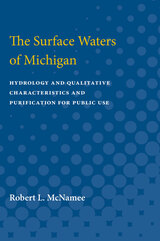 Surface Waters of Michigan: Hydrology and Qualitative Characteristics and Purification for Public Use
Robert L. McNamee
University of Michigan Press, 1930 There are 34 primary river systems in Michigan that have watersheds of 250 square miles or more, and 9 secondary river systems that have watersheds of 500 square miles or more. The mean annual discharge rates of the trunk rivers of these systems range from a minimum of about 0.60 to a maximum of about 1.35 cubic feet per second per square mile of watershed. The regimen of Michigan streams is remarkably uniform in comparison with that of streams in many other parts of the country. This characteristic is favorable to the utilization of stream flow for practically all purposes. The qualities of the waters of the Great Lakes are better than those of the average of the inland river systems of the State. Michigan is justly classed as a hardwater state even in consideration of its surface waters alone, for few streams have waters as soft as the average for the United States as a whole.The purification of Michigan surface waters involves functions and processes for the removal of bacteria, clarification, softening, the removal of iron and manganese, the destruction of algae, and the removal of disagreeable tastes and odors. The physical structures and equipment to accomplish these purposes include screening devices, aerators, chemical treatment devices, sedimentation equipment, filters, and sterilization equipment. A tabulation of descriptive data and functional characteristics of 27 gravity rapid-sand filtration plants in Michigan discloses a variety of designs, old and modern, for treatment ranging from simple bacterial removal for invariably clear lake waters to complicated softening for highly variable, turbid, mineralized, and waste-polluted river waters.
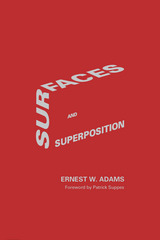 Surfaces and Superposition: Field Notes on some Geometrical Excavations
Ernest W. Adams
CSLI, 2001 Buildings appear to rest on top of the earth's surface, yet the surface is actually permeated by the buildings' foundations-out of view. If a foundation's blueprints are unavailable, as in archaeology, excavation would be needed to discover what actually supports a specific building. Analogously, the fields of geometry and topology have easily observable concepts resting on the surface of theoretical underpinnings that have not been completely discovered, unearthed or understood. Moreover, geometrical and topological principles of superposition provide insight into probing the connections between accessible superstructures and their hidden underpinnings. This book develops and applies these insights broadly, from physics to mathematics to philosophy. Even analogies and abstractions can now be seen as foundational superpositions.
This book examines the dimensionality of surfaces, how superpositions can make stable frameworks, and gives a quasi-Leibnizian account of the relative `spaces' that are defined by these frameworks. Concluding chapters deal with problems concerning the spatio-temporal frameworks of physical theories and implications for theories of visual geometry. The numerous illustrations, while surprisingly simple, are satisfyingly clear.
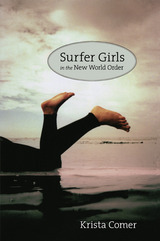 Surfer Girls in the New World Order
Krista Comer
Duke University Press, 2010 In Surfer Girls in the New World Order, Krista Comer explores surfing as a local and global subculture, looking at how the culture of surfing has affected and been affected by girls, from baby boomers to members of Generation Y. Her analysis encompasses the dynamics of international surf tourism in Sayulita, Mexico, where foreign women, mostly middle-class Americans, learn to ride the waves at a premier surf camp and local women work as manicurists, maids, waitresses, and store clerks in the burgeoning tourist economy. In recent years, surfistas, Mexican women and girl surfers, have been drawn to the Pacific coastal town’s clean reef-breaking waves. Comer discusses a write-in candidate for mayor of San Diego, whose political activism grew out of surfing and a desire to protect the threatened ecosystems of surf spots; the owners of the girl-focused Paradise Surf Shop in Santa Cruz and Surf Diva in San Diego; and the observant Muslim woman who started a business in her Huntington Beach home, selling swimsuits that fully cover the body and head. Comer also examines the Roxy Girl series of novels sponsored by the surfwear company Quiksilver, the biography of the champion surfer Lisa Andersen, the Gidget novels and films, the movie Blue Crush, and the book Surf Diva: A Girl’s Guide to Getting Good Waves. She develops the concept of “girl localism” to argue that the experience of fighting for waves and respect in male-majority surf breaks, along with advocating for the health and sustainable development of coastal towns and waterways, has politicized surfer girls around the world.
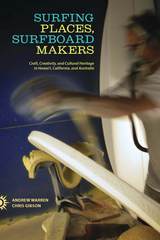 Surfing Places, Surfboard Makers: Craft, Creativity, and Cultural Heritage in Hawai'i, California, and Australia
Andrew Warren and Chris Gibson
University of Hawaii Press, 2014 Over the last forty years, surfing has emerged from its Pacific islands origins to become a global industry. Since its beginnings more than a thousand years ago, surfing’s icon has been the surfboard—its essential instrument, the point of physical connection between human and nature, body and wave. To a surfer, a board is more than a piece of equipment; it is a symbol, a physical emblem of cultural, social, and emotional meanings. Based on research in three important surfing locations—Hawai‘i, southern California, and southeastern Australia—this is the first book to trace the surfboard from regional craft tradition to its key role in the billion-dollar surfing business.
Hawai‘i, California, and Australia are much more than sites of surfboard manufacturing. Their surfboard workshops are hives of creativity where legacies of rich cultural heritage and the local environment combine to produce unique, bold board designs customized to suit prevailing waves. The globalization and corporatization of surfing have presented small, independent board makers with many challenges stemming from the wide availability of cheap, mass-produced boards and the influx of new surfers. The authors follow the story of board makers who have survived these challenges and stayed true to their calling by keeping the mythology and creativity of board making alive. In addition, they explore the heritage of the craft, the secrets of custom board production, the role of local geography in shaping board styles, and the survival of hand-crafting skills.
From the olo boards of ancient Hawaiian kahuna to the high-tech designs that represent the current state of the industry, Surfing Places, Surfboard Makers offers an entrée into the world of surfboard making that will find an eager audience among researchers and students of Pacific culture, history, geography, and economics, as well as surfing enthusiasts.
Surge Protection for Low Voltage Systems
Alain Rousseau
The Institution of Engineering and Technology, 2022 Low-voltage equipment is designed for handling low voltages at consumer-level. This includes computing and telecommunications systems, power distribution grids and PV systems, and EV charging facilities.
Surge to Freedom: The End of Communist Rule in Eastern Europe
J. F. Brown
Duke University Press, 1991 In praise of Surge to Freedom: The End of Communist Rule in Eastern Europe: "Nobody has yet produced a more perceptive and inclusive work on the events of what is arguably the most important year of our lifetimes. This book is essential for anyone with an interest in Eastern Europe, radical social change, or post-bipolar global politics."—Joel M. Jenswold, Social Science Quarterly
"Brown has been a close observer of the region for decades, and the breadth of his knowledge and the acuity of his judgments are evident throughout."—Michael Bernhard, Political Science Quarterly "There is no surer guide than Brown to an understanding of these events, and no one better qualified to describe the complex and daunting problems facing the new non-communist governments."—John C. Campbell, Foreign Affairs
 The Surgery Issue
Eric Plemons and Chris Straayer, special issue editors
Duke University Press, 2018 Trans* surgery has been an object of fantasy, derision, refusal, and triumph. Contributors to this issue explore the vital and contested place of surgical intervention in the making of trans* bodies, theories, and practices. For decades, clinicians considered a desire for reconstructive genital surgery to be the linchpin of the transsexual diagnosis. In the 1990s, new histories of trans* clinical practice challenged the institutional claim that transsexuals all wanted genital surgery, and trans* authors began to argue for their surgically altered bodies as sites of power rather than capitulation. Subsequent contestations of the medico-surgical framework helped mark the emergence of “transgender” as an alternative, more inclusive term for gender nonconforming subjects who were sometimes less concerned with surgical intervention. Contributors move beyond medical issue to engage “the surgical” in its many forms, exploring how trans* surgery has been construed and presented across different discursive forms and how these representations of trans* surgeries have helped and/or limited understanding of trans* identities and bodies and shaped the evolution of trans* politics.
Contributors. Paisley Currah, Joshua Franklin, Cressida J. Heyes, Julia Horncastle, Riki Lane, J.R. Latham, Sandra Mesics, Eric Plemons, Katherine Rachlin, Chris Straayer, Susan Stryker
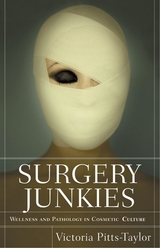 Surgery Junkies: Wellness and Pathology in Cosmetic Culture
Pitts-Taylor, Victoria
Rutgers University Press, 2007 Despite the increasing prevalence of cosmetic surgery, there are still those who identify individuals who opt for bodily modifications as dupes of beauty culture, as being in conflict with feminist ideals, or as having some form of psychological weakness. In this ground-breaking book, Victoria Pitts-Taylor examines why we consider some cosmetic surgeries to be acceptable or even beneficial and others to be unacceptable and possibly harmful. Drawing on years of research, in-depth interviews with surgeons and psychiatrists, analysis of newspaper articles, legal documents, and television shows, and her own personal experience with cosmetic surgery, Pitts-Taylor brings new perspectives to the promotion of "extreme" makeovers on television, the medicalization of "surgery addiction," the moral and political interrogation that many patients face, and feminist debates on the topic. Pitts-Taylor makes a compelling argument that the experience, meanings, and motivations for cosmetic surgery are highly social and, in doing so, provides a much needed "makeover" of our cultural understanding of cosmetic surgery.
Surgical Anatomy of the Head and Neck
Parviz Janfaza M.D.
Harvard University Press, 2001 Surgical Anatomy of the Head and Neck was immediately hailed as indispensable when it was first published in 2001. In demand ever since, this classic surgical atlas—packed with more than 700 exceptional drawings, 537 of them in full color, by an internationally noted medical illustrator—is now available again, with an extensive new index, after years of being out of print.
Here is a surgeon’s-eye view of all anatomic details, from the upper thorax to the crown. Ideal for both surgery and test preparation, this volume features special boxed sections that focus on the surgical significance of each anatomical structure. Every illustration is clearly labeled with key anatomic landmarks, and a user-friendly design allows quick reference. This volume is an invaluable resource for surgeons, residents, and medical students.
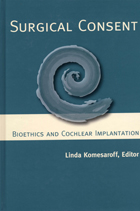 Surgical Consent: Bioethics and Cochlear Implantation
Linda Komesaroff
Gallaudet University Press, 2007 With the rate of cochlear implantation reaching 80% to 90% of all deaf children, some as young as five months old, Surgical Consent: Bioethics and Cochlear Implantation arrives at a critical juncture. This comprehensive collection features essays by Priscilla Alderson, Inger Lise Skog Hansen, Hilde Haualand, volume editor Linda Komesaroff, Paddy Ladd, Harlan Lane, Karen Lloyd, Eithne Mills, Paal Richard Peterson, Gunilla Preisler, Kristina Svartholm, and Michael Uniacke. These worldwide renowned ethicists, educators, and Deaf leaders express their diverse perspectives on the bioethics of childhood cochlear implantation according to their discipline and a number of themes of inquiry: human rights, medical and social ethics, psychology, education, globalization, identity, life pathways, democracy, media, law, and biotechnology.
Drawing on current research, this volume presents the varying reactions around the globe to the high rate of implantation. These views contrast sharply with the medical perspective of deafness overwhelmingly promoted through the media and by the cochlear implantation industry. At the same time, the contributors aim to disrupt the binaries that have long dominated the field of deafness — speech versus sign, instruction through speech and sign systems versus bilingual education, and medical intervention versus cultural membership in the Deaf community.
Surgical Consent begins and ends with the voices of Deaf people. Their articulate and, at times, raw insights clearly delineate the issues of power, positioning, and minority-majority group relations that are inherent in the dominant hearing culture’s understanding of diversity and globalization.
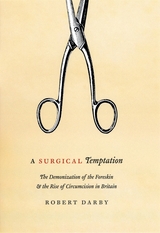 A Surgical Temptation: The Demonization of the Foreskin and the Rise of Circumcision in Britain
Robert Darby
University of Chicago Press, 2005 In the eighteenth century, the Western world viewed circumcision as an embarrassing disfigurement peculiar to Jews. A century later, British doctors urged parents to circumcise their sons as a routine precaution against every imaginable sexual dysfunction, from syphilis and phimosis to masturbation and bed-wetting. Thirty years later the procedure again came under hostile scrutiny, culminating in its disappearance during the 1960s.
Why Britain adopted a practice it had traditionally abhorred and then abandoned it after only two generations is the subject of A Surgical Temptation. Robert Darby reveals that circumcision has always been related to the question of how to control male sexuality. This study explores the process by which the male genitals, and the foreskin especially, were pathologized, while offering glimpses into the lives of such figures as James Boswell, John Maynard Keynes, and W. H. Auden. Examining the development of knowledge about genital anatomy, concepts of health, sexual morality, the rise of the medical profession, and the nature of disease, Darby shows how these factors transformed attitudes toward the male body and its management and played a vital role in the emergence of modern medicine.
Surpassing Wonder: The Invention of the Bible and the Talmuds
Donald Harman Akenson
University of Chicago Press, 2001 Elegant and inventive, Surpassing Wonder uncovers how the ancient Hebrew scriptures, the Christian New Testament, and the Talmuds of the Rabbis are related and how, collectively, they make up the core of Western consciousness. Donald Harman Akenson provides an incisive critique of how religious scholars have distorted the holy books and argues that it was actually the inventor of the Hebrew scriptures who shaped our concept of narrative history—thereby founding Western culture.
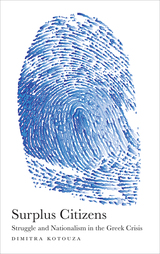 Surplus Citizens: Struggle and Nationalism in the Greek Crisis
Dimitra Kotouza
Pluto Press, 2018 The crisis in Greece has elicited the full spectrum of responses - from optimism for a left parliamentary politics inspired by Syriza's electoral victory, to pessimism about the intransigence of the EU and calls for the reinstatement of full national sovereignty in Europe. In Surplus Citizens, Dimitra Kotouza questions the terms of the debate by demonstrating how the national framing of social contestation posed obstacles to transformative collective action, but also how this framing has been challenged. Analysing the increasing superfluousness of subordinate classes in Greece as part of a global phenomenon with racialised and gendered dimensions, the book interrogates the strengths, contradictions and limits of collective action and identity in the crisis, from the movement of the squares and neighbourhood assemblies, to new forms of labour activism, environmental struggles, immigrant protests, anti-fascism and pro-refugee activism. Arguing against the strategic fixation on unified identities and pointing instead to the transformative potential of internal dispute within movements, Surplus Citizens highlights the relevance of a discussion of Greece to collective action beyond it, as we continue to traverse a global financial crisis that has provoked conflicts over nationalism, immigration and the rise of neo-fascism.
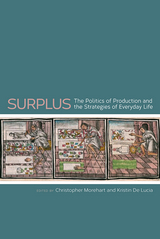 Surplus: The Politics of Production and the Strategies of Everyday Life
Christopher T. Morehart
University Press of Colorado, 2015 The concept of surplus captures the politics of production and also conveys the active material means by which people develop the strategies to navigate everyday life. Surplus: The Politics of Production and the Strategies of Everyday Life examines how surpluses affected ancient economies, governments, and households in civilizations across Mesoamerica, the Southwest United States, the Andes, Northern Europe, West Africa, Mesopotamia, and eastern Asia. A hallmark of archaeological research on sociopolitical complexity, surplus is central to theories of political inequality and institutional finance. This book investigates surplus as a macro-scalar process on which states or other complex political formations depend and considers how past people—differentially positioned based on age, class, gender, ethnicity, role, and goal—produced, modified, and mobilized their social and physical worlds. Placing the concept of surplus at the forefront of archaeological discussions on production, consumption, power, strategy, and change, this volume reaches beyond conventional ways of thinking about top-down or bottom-up models and offers a comparative framework to examine surplus, generating new questions and methodologies to elucidate the social and political economies of the past.
Contributors include Douglas J. Bolender, James A. Brown, Cathy L. Costin, Kristin De Lucia, Timothy Earle, John E. Kelly, Heather M. L. Miller, Christopher R. Moore, Christopher T. Morehart, Neil L. Norman, Ann B. Stahl, Victor D. Thompson, T. L. Thurston, and E. Christian Wells.
Surprise Attack: The Victim’s Perspective, With a New Preface
Ephraim Kam
Harvard University Press, 2004 Ephraim Kam observes surprise attack through the eyes of its victim in order to understand the causes of the victim’s failure to anticipate the coming of war. Emphasizing the psychological aspect of warfare, Kam traces the behavior of the victim at various functional levels and from several points of view in order to examine the difficulties and mistakes that permit a nation to be taken by surprise. He argues that anticipation and prediction of a coming war are more complicated than any other issue of strategic estimation, involving such interdependent factors as analytical contradictions, judgmental biases, organizational obstacles, and political as well as military constraints.
 Surprise, Security, and the American Experience
John Lewis Gaddis
Harvard University Press, 2005 September 11, 2001, distinguished Cold War historian John Lewis Gaddis argues, was not the first time a surprise attack shattered American assumptions about national security and reshaped American grand strategy. We've been there before, and have responded each time by dramatically expanding our security responsibilities.
The pattern began in 1814, when the British attacked Washington, burning the White House and the Capitol. This early violation of homeland security gave rise to a strategy of unilateralism and preemption, best articulated by John Quincy Adams, aimed at maintaining strength beyond challenge throughout the North American continent. It remained in place for over a century. Only when the Japanese attacked Pearl Harbor in 1941 did the inadequacies of this strategy become evident: as a consequence, the administration of Franklin D. Roosevelt devised a new grand strategy of cooperation with allies on an intercontinental scale to defeat authoritarianism. That strategy defined the American approach throughout World War II and the Cold War.
The terrorist attacks of 9/11, Gaddis writes, made it clear that this strategy was now insufficient to ensure American security. The Bush administration has, therefore, devised a new grand strategy whose foundations lie in the nineteenth-century tradition of unilateralism, preemption, and hegemony, projected this time on a global scale. How successful it will be in the face of twenty-first-century challenges is the question that confronts us. This provocative book, informed by the experiences of the past but focused on the present and the future, is one of the first attempts by a major scholar of grand strategy and international relations to provide an answer.
 Surprise, Uncertainty, and Mental Structures
Jerome Kagan
Harvard University Press, 2002 When we are startled by the new, confronted with discrepancies, our knowing gives way to uncertainty—and changes. In the distinctive manner that has made him one of the most influential forces in developmental psychology, Jerome Kagan challenges scientific commonplaces about mental processes, pointing in particular to the significant but undervalued role of surprise and uncertainty in shaping behavior, emotion, and thought.
Drawing on research in both animal and human subjects, Kagan presents a strong case for making qualitative distinctions among four different types of mental representation—perceptual schemata, visceral schemata, sensorimotor structures, and semantic networks—and describes how each is susceptible to the experience of discrepancy and the feeling of surprise or uncertainty. The implications of these findings are far-reaching, challenging current ideas about the cognitive understandings of infants and revealing the bankruptcy of contemporary questionnaire-based personality theory. More broadly, Kagan’s daring, thoroughly informed, and keenly reasoned book demonstrates the risks of making generalizations about human behavior, in which culture, context, and past experience play such paramount and unpredictable roles.
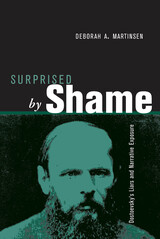 Surprised by Shame: Dostoevsky's Liars and Narrative Exposure
Deborah A. Martinsen
Ohio State University Press, 2003 In Surprised by Shame, Deborah A. Martinsen combines shame studies and literary criticism. She begins with a discussion of shame dynamics, including the tendency of those who witness shame to feel shame themselves. Because Dostoevsky identified shame as a fundamental source of lying, Martinsen focuses on scenes when liars are exposed. She argues that by making readers witness such scandal scenes, Dostoevsky surprises them with shame, thereby collapsing the distance between readers and characters and viscerally involving them in his message of human interconnection. Treating Dostoevsky’s liars as case studies, Surprised by Shame discusses varieties of shame and shamelessness; it also illustrates how Dostoevsky uses lying to indicate and expose subconscious processes. In addition, Martinsen demonstrates how Dostoevsky plucks shame from the realm of character trait and plot motive and embeds it in the narrative dynamics of The Idiot, Demons, and The Brothers Karamazov, thereby plunging readers into fictional experience and ethically transforming them. By focusing on shame, this book uncovers new perspectives on Dostoevsky as writer and psychologist. By exposing how shame dynamics implicate readers in texts’ ethical actions, it enriches understanding of his tremendous influence on twentieth-century thinkers and writers. Finally, reading Dostoevsky as a prophet of shame-begotten violence reveals his universal relevance in a twenty-first century already scarred by acts of violence.
Surprised by Sin: The Reader in Paradise Lost, Second Edition with a New Preface
Stanley Fish
Harvard University Press, 1998 In 1967 the world of Milton studies was divided into two armed camps: one proclaiming (in the tradition of Blake and Shelley) that Milton was of the devil's party with or without knowing it, the other proclaiming (in the tradition of Addison and C. S. Lewis) that the poet's sympathies are obviously with God and the angels loyal to him.
The achievement of Stanley Fish's Surprised by Sin was to reconcile the two camps by subsuming their claims in a single overarching thesis: Paradise Lost is a poem about how its readers came to be the way they are--that is, fallen--and the poem's lesson is proven on a reader's impulse every time he or she finds a devilish action attractive or a godly action dismaying.
Fish's argument reshaped the face of Milton studies; thirty years later the issues raised in Surprised by Sin continue to set the agenda and drive debate.
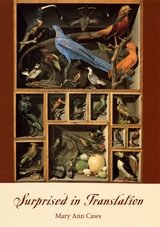 Surprised in Translation
Mary Ann Caws
University of Chicago Press, 2006 For Mary Ann Caws—noted translator of surrealist poetry—the most appealing translations are also the oddest; the unexpected, unpredictable, and unmimetic turns that translations take are an endless source of fascination and instruction. Surprised in Translation is a celebration of the occasional and fruitful peculiarity that results from some of the most flavorful translations of well-known authors. These translations, Caws avers, can energize and enliven the voice of the original.
In eight elegant chapters Caws reflects on translations that took her by surprise. Caws shows that the elimination of certain passages from the original—in the case of Stéphane Mallarmé translating Tennyson, Ezra Pound interpreting the troubadours, or Virginia Woolf rendered into French by Clara Malraux, Charles Mauron, and Marguerite Yourcenar—often produces a greater and more coherent art. Alternatively, some translations—such as Yves Bonnefoy’s translations of Shakespeare, Keats, and Yeats into French—require more lines in order to fully capture the many facets of the original. On other occasions, Caws argues, a swerve in meaning—as in Beckett translating himself into French or English—can produce a new text, just as true as the original.
Imbued with Caws’s personal observations on the relationship between translators and the authors they translate, Surprised in Translation will interest a wide range of readers, including students of translation, professional literary translators, and scholars of modern and comparative literature.
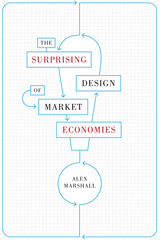 The Surprising Design of Market Economies
By Alex Marshall
University of Texas Press, 2012 The “free market” has been a hot topic of debate for decades. Proponents tout it as a cure-all for just about everything that ails modern society, while opponents blame it for the very same ills. But the heated rhetoric obscures one very important, indeed fundamental, fact—markets don’t just run themselves; we create them. Starting from this surprisingly simple, yet often ignored or misunderstood fact, Alex Marshall takes us on a fascinating tour of the fundamentals that shape markets and, through them, our daily economic lives. He debunks the myth of the “free market,” showing how markets could not exist without governments to create the structures through which we assert ownership of property, real and intellectual, and conduct business of all kinds. Marshall also takes a wide-ranging look at many other structures that make markets possible, including physical infrastructure ranging from roads and railroads to water systems and power lines; mental and cultural structures such as common languages and bodies of knowledge; and the international structures that allow goods, services, cash, bytes, and bits to flow freely around the globe. Sure to stimulate a lively public conversation about the design of markets, this broadly accessible overview of how a market economy is constructed will help us create markets that are fairer, more prosperous, more creative, and more beautiful.
 The Surprising Effects of Sympathy: Marivaux, Diderot, Rousseau, and Mary Shelley
David Marshall
University of Chicago Press, 1988 Through readings of works by Marivaux, Diderot, Rousseau, and Mary Shelley, David Marshall provides a new interpretation of the eighteenth-century preoccupation with theatricality and sympathy. Sympathy is seen not as an instance of sensibility or natural benevolence but rather as an aesthetic and epistemological problem that must be understood in relation to the problem of theatricality.
Placing novels in the context of eighteenth-century writing about theater, fiction, and painting, Marshall argues that an unusual variety of authors and texts were concerned with the possibility of entering into someone else's thoughts and feelings. He shows how key eighteenth-century works reflect on the problem of how to move, touch, and secure the sympathy of readers and beholders in the realm of both "art" and "life." Marshall discusses the demands placed upon novels to achieve certain effects, the ambivalence of writers and readers about those effects, and the ways in which these texts can be read as philosophical meditations on the differences and analogies between the experiences of reading a novel, watching a play, beholding a painting, and witnessing the spectacle of someone suffering. The Surprising Effects of Sympathy traces the interaction of sympathy and theater and the artistic and philosophical problems that these terms represent in dialogues about aesthetics, moral philosophy, epistemology, psychology, autobiography, the novel, and society.
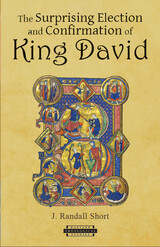 The Surprising Election and Confirmation of King David
J. Randall Short
Harvard University Press, 2010 Some of the best-known Biblical episodes are found in the story of David’s rise to kingship in First and Second Samuel. Why was this series of stories included in the Bible? An answer that has become increasingly popular is that this narrative should be interpreted as the “apology of David,” that is, the personal justification of King David against charges that he illegitimately usurped Saul’s throne. Comparisons between “the History of David’s Rise” and the Hittite “Apology of Hattušili,” in particular, appear to support this view that the Biblical account belongs to the genre of ancient Near Eastern royal apology.
Having presented this approach, Randall Short argues that the Biblical account has less in common with the Hittite apology than scholars have asserted, and he demonstrates how interpretive assumptions about the historical reality behind the text inform the meaning that these scholars discern in the text. His central contention is that this story should not be interpreted as the personal exoneration of David composed to win over suspicious readers. Rather, composed for faithful readers represented by David, the story depicts the dramatic confirmation of David’s surprising election through his gradual emergence as the beloved son of Jesse, Saul, all Israel, and yhwh Himself.
The Surprising Place: Stories
Malinda McCollum
University of Massachusetts Press, 2018 A synchronized swimming coach pops pills during practice, a bagpiper cold-cocks a hawk, and an orphan puts her fist through a window, discovering in the engine noise of a jet passing overhead, the perfect witness to her inner pain. In this debut collection from prizewinning short story writer Malinda McCollum, people adrift in the American Midwest struggle to find their way in the world, with few signposts for guidance. Set largely in Des Moines, Iowa, over the expanse of several decades, these twelve stories explore the surprising places where our outsized longings may lead us. In prose as lean and unflinching as an Iowa winter, these stories offer confrontation and consolation in equal measure.
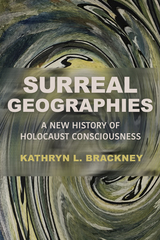 Surreal Geographies: A New History of Holocaust Consciousness
Kathryn L. Brackney
University of Wisconsin Press, 2024 Surreal Geographies recovers a forgotten archive of Holocaust representation. Examining art, literature, and film produced from the immediate postwar period up to the present moment, Kathryn L. Brackney investigates changing portrayals of Jewish victims and survivors. In so doing, she demonstrates that the Holocaust has been understood not only through the documentary realism and postmodern fragmentation familiar to scholars but also through a surreal mode of meaning making. From an otherworldly “Planet Auschwitz” to the spare, intimate spaces of documentary interviews, Brackney shows that the humanity of victims has been produced, undermined, and guaranteed through evolving scripts for acknowledging and mourning mass violence.
Brackney offers a new look at familiar works by authors and artists such as Claude Lanzmann, W. G. Sebald, and Paul Celan, while making surprising connections to contemporary scholars like Timothy Snyder and Donna Haraway, and events such as the Space Race. In the process, she maps out a decades-long process through which transnational conventions of mourning have emerged in Western Europe, North America, and Israel, functioning to constitute Jewish victimization as “grievable life.” Ultimately, she shows how the Holocaust has developed into a figure for the destabilization and reformulation of the category of humanity and the problem of mourning across difference.
Surrealism and the Occult: Occultism and Western Esotericism in the Work and Movement of André Breton
Tessel M. Bauduin
Amsterdam University Press, 2014 This book offers a new perspective on a long-debated issue: the role of the occult in surrealism, in particular under the leadership of French writer André Breton. Based on thorough source analysis, this study details how our understanding of occultism and esotericism, as well as of their function in Bretonian surrealism, changed significantly over time from the early 1920s to the late 1950s.
Surrealism at Play
Susan Laxton
Duke University Press, 2019 In Surrealism at Play Susan Laxton writes a new history of surrealism in which she traces the centrality of play to the movement and its ongoing legacy. For surrealist artists, play took a consistent role in their aesthetic as they worked in, with, and against a post-World War I world increasingly dominated by technology and functionalism. Whether through exquisite-corpse drawings, Man Ray’s rayographs, or Joan Miró’s visual puns, surrealists became adept at developing techniques and processes designed to guarantee aleatory outcomes. In embracing chance as the means to produce unforeseeable ends, they shifted emphasis from final product to process, challenging the disciplinary structures of industrial modernism. As Laxton demonstrates, play became a primary method through which surrealism refashioned artistic practice, everyday experience, and the nature of subjectivity.
Surrealism from Paris to Shanghai
Lauren Walden
Hong Kong University Press, 2024 Surrealism through the lens of China.
Surrealism from Paris to Shanghai is the first English language book dedicated to introducing Chinese Surrealism, enlarging the geographical authority of Surrealist studies beyond a Eurocentric prism of analysis. The book reveals the mutual cultural influence between China and the Western avant-garde, moving beyond notions of “copying from the West.” Utilizing primary source materials, particularly periodicals, Lauren Walden reveals the underexplored dissemination of Surrealism in Shanghai. Highlighting how Surrealism was applied across a broad political spectrum in Shanghai including anti-colonialism, communism, and nationalism, Walden also demonstrates why Shanghai’s former French concession became the birthplace of Surrealism in China.
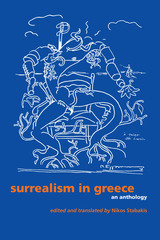 Surrealism in Greece: An Anthology
Edited and translated by Nikos Stabakis
University of Texas Press, 2008 In the decades between the two World Wars, Greek writers and artists adopted surrealism both as an avant-garde means of overturning the stifling traditions of their classical heritage and also as a way of responding to the extremely unstable political situation in their country. Despite producing much first-rate work throughout the rest of the twentieth century, Greek surrealists have not been widely read outside of Greece. This volume seeks to remedy that omission by offering authoritative translations of the major works of the most important Greek surrealist writers. Nikos Stabakis groups the Greek surrealists into three generations: the founders (such as Andreas Embirikos, Nikos Engonopoulos, and Nicolas Calas), the second generation, and the Pali Group, which formed around the magazine Pali. For each generation, he provides a very helpful introduction to the themes and concerns that animate their work, as well as concise biographies of each writer. Stabakis anthologizes translations of all the key surrealist works of each generation—poetry, prose, letters, and other documents—as well as a selection of rarer texts. His introduction to the volume places Greek surrealism within the context of the international movement, showing how Greek writers and artists used surrealism to express their own cultural and political realities.
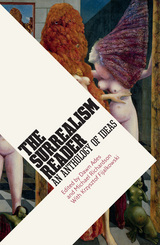 The Surrealism Reader: An Anthology of Ideas
Edited by Dawn Ades, Michael Richardson, and Krzysztof Fijalkowski
University of Chicago Press, 2016 One of the most influential cultural movements of the past century, surrealism has been extensively studied within the framework of its contributions to art and literature—but its pivotal role in the development of intellectual ideas, both political and philosophical, has yet to be fully explored. Featuring writings from the 1920s up to the late 1990s, this anthology—the first of its kind in English—finally reveals surrealism’s diverse scope, its deep contributions to the history of ideas, and its profound implications for contemporary thought.
Including essays by leading surrealists and other major writers on the movement, the volume addresses the key themes of identity, otherness, freedom and morality, and poetry. The texts uncover, among other things, the significance of surrealism for the antifascist and anticolonialist movements and the various manifestations of surrealism in the years after World War II. Giving space to the many different voices that made up the movement, and placing them for the first time within a clear and coherent historical framework, The Surrealism Reader radically revises the popular understanding of what, and when, surrealism was—making this book an essential reference for students, scholars, and all those interested in the central place of surrealism within twentieth-century thought and culture.
Surrealism: The Road to the Absolute
Anna Balakian
University of Chicago Press, 1987 First published in 1959, Surrealism remains the most readable introduction to the French surrealist poets Apollinaire, Breton, Aragon, Eluard, and Reverdy. Providing a much-needed overview of the movement, Balakian places the surrealists in the context of early twentieth-century Paris and describes their reactions to symbolist poetry, World War I, and developments in science and industry, psychology, philosophy, and painting. Her coherent history of the movement is enhanced by her firsthand knowledge of the intellectual climate in which some of these poets worked and her interviews with Reverdy and Breton. In a new introduction, Balakian discusses the influence of surrealism on contemporary poetry.
This volume includes photographs of the poets and reproductions of paintings by Ernst, Dali, Tanguy, and others.
 Surrealist Love Poems
Edited by Mary Ann Caws
University of Chicago Press, 2005 Love poetry includes, yes, descriptions of the beloved. And images of a fantastic idyll complete with falling stars, the sound of the sea, and beautiful countryside. In the hands of Surrealists, though, love poetry also includes gravediggers and murderers, dice and garbage, snakeskin purses and "the drunken kisses of cyclones." Surrealism, the movement founded in the 1920s on the ashes of Dada's nihilism, embraced absurdity, contradiction, and, to a supreme extent, passion and desire. From André Breton's battle cry of "Mad Love" to the quiet lyricism of Robert Desnos, Surrealist writers and artists obsessively expressed the permutations of that fundamental human state, love, and they did so with the vocabulary of natural and unnatural worlds, the explicit language of sex, and a great deal of humor.
Surrealist Love Poems brings together sixty poems by Surrealists who charged their work with all forms of eroticism. Expertly and energetically edited by Mary Ann Caws, this collection seeks to demonstrate the truth of Breton's words, that "the embrace of poetry like that of bodies / As long as it lasts / Shuts out all the woes of the world."
"Erotic, impassioned and necrophilic, the sixty works gathered in Surrealist Love Poems celebrate the idea of obsessive and transformative love. 'I want to sleep with you side by side. . . . Stretched out on your shadow / Hammered by your tongue / To die in a rabbit's rotting teeth / Happy' writes Joyce Mansour. . . . Caws places poems by major surrealist writers like André Breton and Paul Eluard, along with the poetry of Picasso, Dalí, and Frida Kahlo, side by side with fourteen lushly printed and alluring black-and-white photos by the likes of Man Ray, Lee Miller, and Claude Cahun."—Publishers Weekly
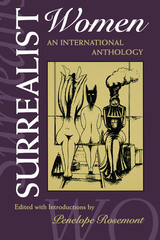 Surrealist Women: An International Anthology
Edited by Penelope Rosemont
University of Texas Press, 1998 Beginning in Paris in the 1920s, women poets, essayists, painters, and artists in other media have actively collaborated in defining and refining surrealism's basic project—achieving a higher, open, and dynamic consciousness, from which no aspect of the real or the imaginary is rejected. Indeed, few artistic or social movements can boast as many women forebears, founders, and participants—perhaps only feminism itself. Yet outside the movement, women's contributions to surrealism have been largely ignored or simply unknown. This anthology, the first of its kind in any language, displays the range and significance of women's contributions to surrealism. Letting surrealist women speak for themselves, Penelope Rosemont has assembled nearly three hundred texts by ninety-six women from twenty-eight countries. She opens the book with a succinct summary of surrealism's basic aims and principles, followed by a discussion of the place of gender in the movement's origins. She then organizes the book into historical periods ranging from the 1920s to the present, with introductions that describe trends in the movement during each period. Rosemont also prefaces each surrealist's work with a brief biographical statement.
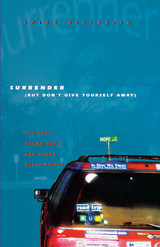 Surrender (But Don't Give Yourself Away): Old Cars, Found Hope, and Other Cheap Tricks
By Spike Gillespie
University of Texas Press, 2003 Spike Gillespie tells it like it is. Whether she's writing about men, mothering or money, she cuts to the chase, unabashedly recounting the exhilaration and uncertainty she is forever encountering along the odd path that is her life. Gillespie approaches her subjects with a keen eye for curious details and a readiness to ask hard questions and give honest, even brutal, answers. Her willingness to "put it all down—the painful, the funny, the mundane, the embarrassing" has won legions of readers for her print and online columns. Surrender (But Don't Give Yourself Away) collects forty-six essays, which initially appeared in such publications as the Washington Post, Austin Chronicle, Dallas Morning News, Bust, Gargoyle, and thecommonspace.org. As Gillespie describes them, "There are odes to my good days and bad, to trips I've taken—both real and metaphorical, to holiness found in unexpected places, to men I have not slept with, to learning to live sober. Too, there are miscellaneous ruminations on my alter-ego, my inner-teen, the floor mat in my car, a dead squirrel in the road." Binding these pieces is the thread of hope: there are moments the thread slips out of view only to resurface in some unexpected location. Sometimes it takes awhile, but Gillespie always relocates hope, discovering even in her darkest times that life is full of an embarrassment of riches.
 Surrender: Feminist Rhetoric and Ethics in Love and Illness
Jessica Restaino
Southern Illinois University Press, 2019 Winner, CCCC Outstanding Book Award, 2020
One of Library Journal's Top 20 Best-Selling Language Titles of 2019
In an ethnographic study spanning the last years of research collaborator and friend Susan Lundy Maute’s life with terminal breast cancer, author Jessica Restaino argues the interpretative challenges posed by research and writing amid illness and intimacy demand a methodological break from accepted genres and established practices of knowledge making. Restaino searches their experiences—recorded in interviews, informal writings, and correspondence—to discover a rhetoric of love and illness. She encourages a synthesis of methods and the acceptance of a reversal of roles—researcher and researched, writer and written-about—and emphasizes the relevancy of methodological diversity, the necessity of the personal, and the analytical richness of unpredictability and risk in being who we are in our scholarship at any given moment.
Bringing together critical analysis, qualitative-style research methods, close reading, Surrender: Feminist Rhetoric and Ethics inLove and Illness resists traditional ideas about academic writing and invites others to pursue collaborations that subvert accepted approaches to representation, textual production, and subjectivity. Restaino demonstrates a way of writing—the rendering of the academic text itself—that suggests how we do our work has resonance for what we produce. She offers framing questions for use by others interested in doing similar kinds of scholarship that may frighten, overwhelm, or confound. This book deepens our understanding of subjectivity and the gains made by feminist resistance to conventional concepts of objectivity in research collaborations.
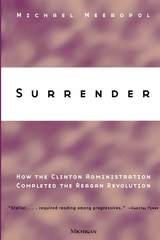 Surrender: How the Clinton Administration Completed the Reagan Revolution
Michael Meeropol
University of Michigan Press, 2000 Michael Meeropol argues that the ballooning of the federal budget deficit was not a serious problem in the 1980s, nor were the successful recent efforts to get it under control the basis for the prosperous economy of the mid-1990s. In this controversial book, the author provides a close look at what actually happened to the American economy during the years of the "Reagan Revolution" and reveals that the huge deficits had no negative effect on the economy. It was the other policies of the Reagan years--high interest rates to fight inflation, supply-side tax cuts, reductions in regulation, increased advantages for investors and the wealthy, the unraveling of the safety net for the poor--that were unsuccessful in generating more rapid growth and other economic improvements.
Meeropol provides compelling evidence of the failure of the U.S. economy between 1990 and 1994 to generate rising incomes for most of the population or improvements in productivity. This caused, first, the electoral repudiation of President Bush in 1992, followed by a repudiation of President Clinton in the 1994 Congressional elections. The Clinton administration made a half-hearted attempt to reverse the Reagan Revolution in economic policy, but ultimately surrendered to the Republican Congressional majority in 1996 when Clinton promised to balance the budget by 2000 and signed the welfare reform bill. The rapid growth of the economy in 1997 caused surprisingly high government revenues, a dramatic fall in the federal budget deficit, and a brief euphoria evident in an almost uncontrollable stock market boom. Finally, Meeropol argues powerfully that the next recession, certain to come before the end of 1999, will turn the predicted path to budget balance and millennial prosperity into a painful joke on the hubris of public policymakers.
Accessibly written as a work of recent history and public policy as much as economics, this book is intended for all Americans interested in issues of economic policy, especially the budget deficit and the Clinton versus Congress debates. No specialized training in economics is needed.
"A wonderfully accessible discussion of contemporary American economic policy. Meeropol demonstrates that the Reagan-era policies of tax cuts and shredded safety nets, coupled with strident talk of balanced budgets, have been continued and even brought to fruition by the neo-liberal Clinton regime." --Frances Fox Piven, Graduate School, City University of New York
Michael Meeropol is Chair and Professor of Economics, Western New England College.
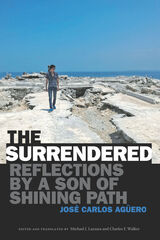 The Surrendered: Reflections by a Son of Shining Path
José Carlos Agüero. Edited and Translated by Michael J. Lazzara and Charles F. Walker
Duke University Press, 2021 When Peruvian public intellectual José Carlos Agüero was a child, the government imprisoned and executed his parents, who were members of Shining Path. In The Surrendered—originally published in Spanish in 2015 and appearing here in English for the first time—Agüero reflects on his parents' militancy and the violence and aftermath of Peru's internal armed conflict. He examines his parents' radicalization, their lives as guerrillas, and his tumultuous childhood, which was spent in fear of being captured or killed, while grappling with the complexities of public memory, ethics and responsibility, human rights, and reconciliation. Much more than a memoir, The Surrendered is a disarming and moving consideration of what forgiveness and justice might mean in the face of hate. This edition includes an editors' introduction, a timeline of the Peruvian conflict, and an extensive interview with the author.
The Surreptitious Speech: Presence Africaine and the Politics of Otherness 1947-1987
Edited by V. Y. Mudimbe
University of Chicago Press, 1992 Distinguished scholar V. Y. Mudimbe assembles a lively tribute to Presence Africaine, the landmark African studies journal begun in 1947 Paris. While it celebrates the project's forty-year history, The Surreptitious Speech does not naively canonize the journal but rather offers a vibrant discussion and critical reading of its context, characteristics, and significance.
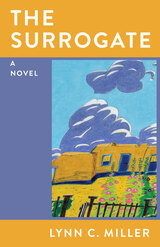 The Surrogate
Lynn C. Miller
University of Wisconsin Press, 2026 Alex Ross, a thirty-year-old psychologist, enjoys the benefits of a close-knit family: her mother and aunt are twins married to two close friends, and Alex and her cousins, Rolf and Stephen, grew up as if they were siblings. When Rolf is killed in a car accident, Alex’s entire family spins into grief and chaos.
Nathaniel, a mysterious art museum curator, soon enters their lives and seems to offer the family solace. Frannie, Rolf’s mother, becomes infatuated with the young man; Alex, who split with her long-term girlfriend in the aftermath of Rolf’s death, finds herself deeply attracted to him. Only Stephen mistrusts Nathaniel—but he soon becomes consumed with the nationwide financial crisis threatening the family’s stability. Will Alex choose Nathaniel over her loyalty to Stephen? Torn between competing desires, fueled by her lifelong but unexamined love of Rolf, she must turn her own training as a psychologist on herself in order to find peace amid the turmoil all around.
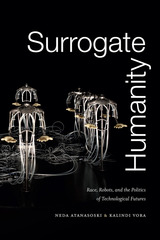 Surrogate Humanity: Race, Robots, and the Politics of Technological Futures
Neda Atanasoski and Kalindi Vora
Duke University Press, 2019 In Surrogate Humanity Neda Atanasoski and Kalindi Vora trace the ways in which robots, artificial intelligence, and other technologies serve as surrogates for human workers within a labor system entrenched in racial capitalism and patriarchy. Analyzing myriad technologies, from sex robots and military drones to sharing-economy platforms, Atanasoski and Vora show how liberal structures of antiblackness, settler colonialism, and patriarchy are fundamental to human---machine interactions, as well as the very definition of the human. While these new technologies and engineering projects promise a revolutionary new future, they replicate and reinforce racialized and gendered ideas about devalued work, exploitation, dispossession, and capitalist accumulation. Yet, even as engineers design robots to be more perfect versions of the human—more rational killers, more efficient workers, and tireless companions—the potential exists to develop alternative modes of engineering and technological development in ways that refuse the racial and colonial logics that maintain social hierarchies and inequality.
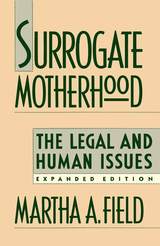 Surrogate Motherhood: The Legal and Human Issues, Expanded Edition
Martha A. Field
Harvard University Press, 1990 With an Expanded Appendix on the Current Legal Status of Surrogacy Arrangements
A practice known since Biblical times, surrogate motherhood has only recently leaped to prominence as a way of providing babies for childless couples—and leaped to notoriety through the dramatic case of Baby M. Contract surrogacy is officially little more than ten years old, but by 1986 five hundred babies had been born to mothers who gave them up to sperm donor fathers for a fee, and the practice is growing rapidly. Martha Field examines the myriad legal complexities that today enmesh surrogate motherhood, and also looks beyond existing legal rules to ask what society wants from surrogacy.
A man’s desire to be a “biological” parent even when his wife is infertile—the father’s wife usually adopts the child—has led to this new kind of family, and modern technology could further extend surrogacy’s appeal by making gestational surrogates available to couples who provide both egg and sperm. But is surrogacy a form of babyselling? Is the practice a private matter covered by contract law, or does adoption law govern? Is it good or bad social and public policy to leave surrogacy unregulated? Should the law allow, encourage, discourage, or prohibit surrogate motherhood? Ultimately the answers will depend on what the American public wants.
In the difficult process of sorting out such vexing questions, Martha Field has written a landmark book. Showing that the problem is rather too much applicable law than too little, she discusses contract law and constitutional law, custody and adoption law, and the rights of biological fathers as well as the laws governing sperm donation. Competing values are involved all along the legal and social spectrum. Field suggests that a federal prohibition would be most effective if banning surrogacy is the aim, but federal prohibition might not be chosen for a variety of reasons: a preference for regulating surrogacy instead of driving it underground; a preference for allowing regulation and variation by state; or a respect for the interests of people who want to enter surrogacy arrangements. Since the law can support a wide variety of positions, Field offers one that seems best to reconcile the competing values at stake. Whether or not paid surrogacy is made illegal, she suggests that a surrogate mother retain the option of abiding by or canceling the contract up to the time she freely gives the child to the adopting couple. And if she cancels the contract, she should be entitled to custody without having to prove in court that she would be a better parent than the father.
 Surrogate Warfare: The Transformation of War in the Twenty-First Century
Andreas Krieg and Jean-Marc Rickli
Georgetown University Press, 2019 Surrogate Warfare explores the emerging phenomenon of “surrogate warfare” in twenty-first century conflict. The popular notion of war is that it is fought en masse by the people of one side versus the other. But the reality today is that both state and non-state actors are increasingly looking to shift the burdens of war to surrogates. Surrogate warfare describes a patron's outsourcing of the strategic, operational, or tactical burdens of warfare, in whole or in part, to human and/or technological substitutes in order to minimize the costs of war. This phenomenon ranges from arming rebel groups, to the use of armed drones, to cyber propaganda. Krieg and Rickli bring old, related practices such as war by mercenary or proxy under this new overarching concept. Apart from analyzing the underlying sociopolitical drivers that trigger patrons to substitute or supplement military action, this book looks at the intrinsic trade-offs between substitutions and control that shapes the relationship between patron and surrogate. Surrogate Warfare will be essential reading for anyone studying contemporary conflict.
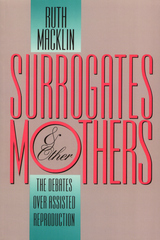 Surrogates and Other Mothers: The Debates over Assisted Reproduction
Ruth Macklin
Temple University Press, 1994 Developments in new reproductive technologies have confounded public policy and created legal and ethical quandaries for professionals and ordinary citizens alike. Drawing from the most current medical, psychiatric, legal, and bioethical literature, Ruth Macklin, noted author and philosopher, presents the arguments surrounding these advances through the voices of fictional characters. The episodes she narrates are based on real-life situations, both from her personal experience as a hospital ethicist and from the public arena, where such controversial court cases as that of Baby M have sparked a multitude of disparate opinions on surrogacy, in vitro fertilization, and egg and sperm donor program. Macklin's hypoethical tale centers on Bonnie and Larry, an infertile couple longing for a child. As the couple's quest to become parents begins, they discover that Bonnie is physically incapable of carrying a pregnancy to term. Desperate to explore their options, Bonnie and Larry attempt adoption but are rejected by the agency without explanation. Finally, they contemplate surrogacy as their last chance to have a child. Seeking advice and answers, they consult health professionals, lawyers, pastoral counselors, and a bioethicist. In the course of this complicated and often painful decision-making process, they attend meetings of a government task force on reproduction where they hear both radical and liberal feminist positions. Their experiences with friends, family members, two surrogates, hospital ethics committees, and special interest groups underscore the difficulty of coming to a consensus on such issues as AIDS, the right to privacy, premenstrual syndrome, the violation of surrogate contracts, and the responsibilities of therapists and physicians to their patients and to the community at large.
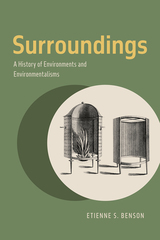 Surroundings: A History of Environments and Environmentalisms
Etienne S. Benson
University of Chicago Press, 2020 Given the ubiquity of environmental rhetoric in the modern world, it’s easy to think that the meaning of the terms environment and environmentalism are and always have been self-evident. But in Surroundings, we learn that the environmental past is much more complex than it seems at first glance. In this wide-ranging history of the concept, Etienne S. Benson uncovers the diversity of forms that environmentalism has taken over the last two centuries and opens our eyes to the promising new varieties of environmentalism that are emerging today.
Through a series of richly contextualized case studies, Benson shows us how and why particular groups of people—from naturalists in Napoleonic France in the 1790s to global climate change activists today—adopted the concept of environment and adapted it to their specific needs and challenges. Bold and deeply researched, Surroundings challenges much of what we think we know about what an environment is, why we should care about it, and how we can protect it.
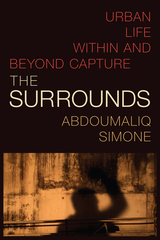 The Surrounds: Urban Life within and beyond Capture
AbdouMaliq Simone
Duke University Press, 2022 In The Surrounds renowned urbanist AbdouMaliq Simone offers a new theorization of the interface of the urban and the political. Working at the intersection of Black studies, urban theory, and decolonial and Islamic thought, Simone centers the surrounds—those urban spaces beyond control and capture that exist as a locus of rebellion and invention. He shows that even in clearly defined city environments, whether industrial, carceral, administrative, or domestic, residents use spaces for purposes they were not designed for: schools become housing, markets turn into classrooms, tax offices transform into repair shops. The surrounds, Simone contends, are where nothing fits according to design. They are where forgotten and marginalized populations invent new relations and ways of living and being, continuously reshaping what individuals and collectives can do. Focusing less on what new worlds may come to be and more on what people are creating now, Simone shows how the surrounds are an integral part of the expansiveness of urban imagination.
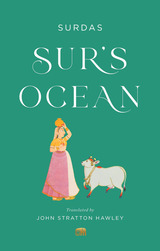 Sur’s Ocean: Classic Hindi Poetry in Translation
Surdas
Harvard University Press, 2015 “John Stratton Hawley miraculously manages to braid the charged erotic and divine qualities of Krishna, the many-named god, while introducing us—with subtle occasional rhyme—to a vividly particularized world of prayers and crocodile earrings, spiritual longing and love-struck bees.”
—Forrest Gander, winner of the Pulitzer Prize for Poetry
An award-winning translation of Hindi verses composed by one of India’s treasured poets.
The blind poet Surdas has been regarded as the epitome of artistry in Hindi verse from the end of the sixteenth century, when he lived, to the present day. His fame rests upon his remarkable refashioning of the widely known narrative of the Hindu deity Krishna and his lover Radha into lyrics that are at once elegant and approachable. Surdas’s popularity led to the proliferation, through an energetic oral tradition, of poems ascribed to him, known collectively as the Sūrsāgar.
This award-winning translation reconstructs the early tradition of Surdas’s verse—the poems that were known to the singers of Surdas’s own time as his. Here Surdas stands out with a clarity never before achieved.
 Sur’s Ocean: Poems from the Early Tradition
Surdas
Harvard University Press, 2015 Surdas has been regarded as the epitome of artistry in Old Hindi religious poetry from the end of the sixteenth century, when he lived, to the present day. His fame rests upon his remarkable refashioning of the widely known narrative of the cowherd deity Krishna and his lover Radha into lyrics that are at once elegant and approachable. Surdas’s popularity led to the proliferation, through an energetic oral tradition, of poems ascribed to him, known as the Sūrsāgar.
Sur’s Ocean: Poems from the Early Tradition presents a dramatically new edition in Devanagari script and a lyrical English translation. This remarkable volume reconstructs the early tradition of Surdas’s verse—the 433 poems that were known to the singers of Surdas’s own time as his. Here Surdas stands out with a clarity never before achieved.
The Murty Classical Library of India makes available original texts and modern English translations of the masterpieces of literature and thought from across the whole spectrum of Indic languages over the past two millennia in the most authoritative and accessible formats on offer anywhere.
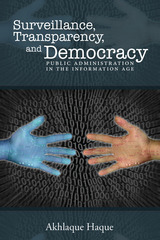 Surveillance, Transparency, and Democracy: Public Administration in the Information Age
Akhlaque Haque
University of Alabama Press, 2015 Investigates public administration’s increasing dependence on technology and how its pervasive use in complex and interrelated socioeconomic and political affairs has outstripped the ability of many public administrators and the public to grasp the consequences of their choices
In this well-informed yet anxious age, public administrators have constructed vast cisterns that collect and interpret a meteoric shower of facts. Akhlaque Haque demonstrates that this pervasive use and increasing dependence on information technology (IT) enables sophisticated and well-intentioned public services that nevertheless risk deforming public policy decision-making and sees a contradiction inherent in a public that seeks services that require a level of data collection that in turn triggers fears of a tyrannical police state.
The author posits that IT’s potential as a tool for human development depends on how civil servants and citizens actively engage in identifying desired outcomes, map IT solutions to those outcomes, and routinize the applications of those solutions. This leads to his call for the development of entrepreneurs who generate innovative solutions to critical human needs and problems. In his powerful summary, he recaps possible answers to the question: What is the best way a public institution can apply technology to improving the human condition?
Engrossing, challenging, and timely, Surveillance, Transparency, and Democracy is essential reading for both policy makers as well as the great majority of readers and citizens engaged in contemporary arguments about the role of government, public health and security, individual privacy, data collection, and surveillance.
Surveillance and Diagnostics of Next Generation Nuclear Reactors
Imre Pázsit
The Institution of Engineering and Technology, 2025 Next generation nuclear reactors are expected to contribute to the future energy mix, forming part of the transition to an emission-free energy system. Diagnostics and monitoring are a necessary part of the design, development and operation of the new generation of nuclear power plants.
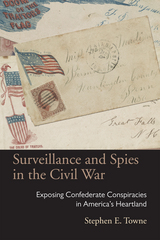 Surveillance and Spies in the Civil War: Exposing Confederate Conspiracies in America’s Heartland
Stephen E. Towne
Ohio University Press, 2015 Surveillance and Spies in the Civil War represents pathbreaking research on the rise of U.S. Army intelligence operations in the Midwest during the American Civil War and counters long-standing assumptions about Northern politics and society. At the beginning of the rebellion, state governors in Ohio, Indiana, and Illinois cooperated with federal law enforcement officials in various attempts—all failed—to investigate reports of secret groups and individuals who opposed the Union war effort. Starting in 1862, army commanders took it upon themselves to initiate investigations of antiwar sentiment in those states. By 1863, several of them had established intelligence operations staffed by hired civilian detectives and by soldiers detailed from their units to chase down deserters and draft dodgers, to maintain surveillance on suspected persons and groups, and to investigate organized resistance to the draft. By 1864, these spies had infiltrated secret organizations that, sometimes in collaboration with Confederate rebels, aimed to subvert the war effort. Stephen E. Towne is the first to thoroughly explore the role and impact of Union spies against Confederate plots in the North. This new analysis invites historians to delve more deeply into the fabric of the Northern wartime experience and reinterpret the period based on broader archival evidence.
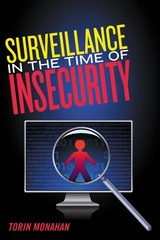 Surveillance in the Time of Insecurity
Monahan, Torin
Rutgers University Press, 2010 Threats of terrorism, natural disaster, identity theft, job loss, illegal immigration, and even biblical apocalypse—all are perils that trigger alarm in people today. Although there may be a factual basis for many of these fears, they do not simply represent objective conditions. Feelings of insecurity are instilled by politicians and the media, and sustained by urban fortification, technological surveillance, and economic vulnerability.
Surveillance in the Time of Insecurity fuses advanced theoretical accounts of state power and neoliberalism with original research from the social settings in which insecurity dynamics play out in the new century. Torin Monahan explores the counterterrorism-themed show 24, Rapture fiction, traffic control centers, security conferences, public housing, and gated communities, and examines how each manifests complex relationships of inequality, insecurity, and surveillance. Alleviating insecurity requires that we confront its mythic dimensions, the politics inherent in new configurations of security provision, and the structural obstacles to achieving equality in societies.
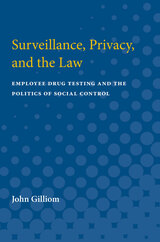 Surveillance, Privacy, and the Law: Employee Drug Testing and the Politics of Social Control
John Gilliom
University of Michigan Press, 1996 Employee drug testing is an invasive and controversial new social control policy that burst into the American work place during the war on drugs of the 1980s. Workers, judges, and politicians divided over whether it was an unnecessary and unconstitutional program of surveillance or an effective and appropriate new weapon in the anti-drug arsenal. When the dust had settled, the new technique was widely used and had been strongly approved by the United States Supreme Court. This raises the fundamental question: Why was the momentum behind testing so strong and the opposition to testing so ineffective? Drawing on theories of ideological hegemony and legal mobilization, John Gilliom begins the search for answers with an examination of how the imagery of a national drug crisis served as the legitimating context for the introduction of testing. Surveillance, Privacy, and the Law then moves beyond the specific history of testing and frames the new policy within a broader transformation of social control policy seen by students of political economy, society, and culture. The book cites survey research among skilled workers and analyzes court opinions to highlight the sharply polarized opinions in the workplaces and courthouses of America. Although federal court decisions show massive and impassioned disagreement among judges, the new conservative Supreme Court comes down squarely behind testing. Its ruling embraces surveillance technology, rejects arguments against testing, and undermines future opposition to policies of general surveillance. Surveillance, Privacy, and the Law portrays the apparent triumph of testing policies as a victory for the conservative law-and-order movement and a stark loss for the values of privacy and autonomy. As one episode in a broader move toward a surveillance society, the battle over employee drug testing raises disturbing questions about future struggles over revolutionary new means of surveillance and control. John Gilliom is Professor of Political Science, Ohio University.
 Surveillance, Volume 23
Richard Maxwell
Duke University Press Since the 1960s, and increasingly since September 11, 2001, “surveillance studies” has become a rapidly expanding field, devised to examine the ways in which information about people’s personal lives is obtained, stored, and shared and how these details are used to influence and manage populations. This special issue of Social Text takes on surveillance in its domestic and international forms, exploring the impact that it has on labor, technology, and privacy. One article looks at the emergence of the biometrics industries and its effect on surveillance systems and businesses. Another addresses the labor of surveillance and how surveillance work and policy affect the homeland security workforce. Various geographic areas are highlighted in several essays, including those on sex workers in Bengal, local surveillance in Turkey, and welfare surveillance and resistance in Appalachian Ohio. Additional themes include historical modes of surveillance, processes of legitimation for intensifying surveillance, and cultural representations of surveillance. Contributors. Kelly A. Gates, Swati Ghosh, John Gilliom, Margaret Morganroth Gullette, Richard Maxwell, Laikwan Pang, David J. Phillips, Michael J. Shapiro, Çagatay Topal
Surveille
Caitlin Roach
University of Wisconsin Press, 2024 Surveille’s queer speaker is on the cusp of motherhood, vacillating between attentiveness and paranoia. Exploring drone strikes, scorpion eradication, bird behavior, mating deer, ICE detainees, and family relationships, Caitlin Roach’s poems stare into and through the truth with a blazing intensity. This is a book about control (self-inflicted and external), about watching and being watched (by oneself, by others, by the state), and about the desperate search for meaning in a world that feels increasingly violent and filled with despair.
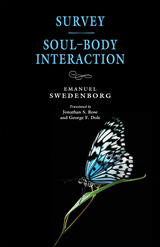 Survey / Soul-Body Interaction
Emanuel Swedenborg
Swedenborg Foundation Publishers, 2022 These two shorter works by Swedish theologian Emanuel Swedenborg (1688–1772), originally published separately and very different in content, both represent Swedenborg’s own effort to summarize complex areas of his thought.
Published toward the end of Swedenborg’s life, Survey of Teachings of the New Church was a forerunner to his final theological work, True Christianity. In Survey, Swedenborg discusses some key tenets of Christian doctrine, both Catholic and Protestant, and describes how his own theology differs from it. He focuses on key concepts such as the Trinity, the nature of faith and charity, and the spiritual nature of the Last Judgment described in the book of Revelation. Taken as a whole, the piece is a brief summation of the doctrines that Swedenborg felt were critical for the coming spiritual age.
Soul-Body Interaction addresses a crucial area of Swedenborg’s thought: the way that life flows from the transcendent God into all living things. Swedenborg describes the nature and structure of the spiritual world, including heaven, hell, and the intermediate world of spirits, and describes how the higher levels of being reflect a more perfect conjunction with God. He also traces the flow of the Lord’s love and wisdom into the soul of all living people, showing how it gives life regardless of their current spiritual state.
Survey for Assessing Racial/Ethnic Harassment and Discrimination in the U.S. Military
Miriam Matthews
RAND Corporation, 2021 To help the U.S. Department of Defense (DoD) estimate the percentage of service members who experienced racial or ethnic harassment or discrimination in the past year, RAND Corporation researchers, with feedback from external experts and DoD representatives, developed a survey instrument. The authors of this report describe the instrument-development process, the instrument itself, and recommendations to support its use.
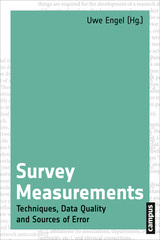 Survey Measurements: Techniques, Data Quality and Sources of Error
Edited by Uwe Engel
Campus Verlag, 2015 The accuracy of a survey is directly affected by how the survey is presented, how the questions are worded, and what the format is for responses. In addition, survey methods continue to develop at an accelerating rate to keep step with technological demands. Consequently, research on survey methods themselves is essential to ensuring accurate data. Survey Measurements presents the most up to date findings in this field. Exploring the effects of survey question format and survey type on data quality as well as developments in the treatment of missing data, an international collection of contributors addresses such key topics as motivated misreporting; audio-recording of open-ended questions; framing effects; multitrait-multimethod matrix modeling; web, mobile web, and mixed-mode research; experience sampling; estimates of change; and multiple imputation. This book will be a vital resource for teachers and students of survey methodology, advanced data analysis, applied survey research, and a variety of disciplines including the social sciences, public health research, epidemiology, and psychology.
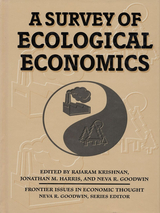 A Survey of Ecological Economics
Edited by Rajaram Krishnan, Jonathan M. Harris, and Neva R. Goodwin
Island Press, 1995 The emergent discipline of ecological economics is based on the idea that the world's economies are a function of the earth's ecosystems -- an idea that radically reverses the world view of neoclassical economics. A Survey of Ecological Economics provides the first overview of this new field, and a comprehensive and systematic survey of its critical literature. The editors of the volume summarize ninety-five seminal articles, selected through an exhaustive survey, that advance the field of ecological economics and represent the best thinking to date in the area. Each two- to three-page summary is far more comprehensive than a typical abstract, and presents both the topics covered in each paper and the most important arguments made about each topic. Sections cover: - historical perspective
- definition, scope, and interdisciplinary issues
- theoretical frameworks and techniques
- energy and resource flow analysis
- accounting and evaluation
- North-South/international issues
- ethical/social/institutional issues
Each section is preceded by an introductory essay that outlines the current state of knowledge in the field and proposes a research agenda for the future. A Survey of Ecological Economics is the first volume in the Frontier Issues in Economic Thought series produced by the Global Development And Environment Institute at Tufts University.
A Survey of Indian Assimilation in Eastern Sonora
Thomas B. Hinton
University of Arizona Press, 1959 The Anthropological Papers of the University of Arizona is a peer-reviewed monograph series sponsored by the School of Anthropology. Established in 1959, the series publishes archaeological and ethnographic papers that use contemporary method and theory to investigate problems of anthropological importance in the southwestern United States, Mexico, and related areas.
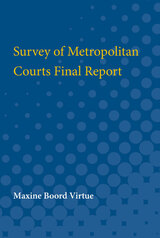 Survey of Metropolitan Courts Final Report
Maxine Boord Virtue
University of Michigan Press, 1962 Survey of Metropolitan Courts: Final Report is the culmination of a twelve-year study on the function of the metropolitan trial court as a facility of the metropolitan community. It was started in 1947 when the Section of Judicial Administration of the American Bar Association initiated a research project into the special problems of metropolitan courts.The book represents a major step toward identifying, characterizing, and classifying the special problems of metropolitan courts and analyzing the effectiveness of methods brought to bear on those problems. It contains a wealth of useful material on personnel, caseload in various courts, and relationships between courts and other law-enforcement and community welfare agencies. Its survey of past studies on the problems of metropolitan courts, tables, and appendices make it an important reference source book.Survey of Metropolitan Courts: Final Report makes use of material from an earlier study published in 1950, also by Maxine Boord Virtue, under the auspices of the University of Michigan Law School as part of an American Bar Association project. In addition, it draws on Virtue's recent investigations of courts in New York City, Chicago, San Francisco, and London, as well as James C. Holbrook's study of Los Angeles courts published in 1957, and other recent research around the country.Survey of Metropolitan Courts: Final Report is a scholarly work that is vitally concerned with the practical possibilities of improved law administration. It shows what can be done by competent leadership and cooperation in this complex field of court organization.
 A Survey of Sardis and the Major Monuments Outside the City Walls
George M. A. Hanfmann and J. C. Waldbaum
Harvard University Press, 1975 The great metropolis of Asia Minor, Sardis was the place where legendary Croesus ruled, where coinage was invented. Since 1958 a Harvard-Cornell archaeological team has worked at the site to retrieve evidence of the greatness of Lydian culture as well as of the prehistoric, Hellenistic, Roman, Byzantine, and Turkish civilizations that preceded and followed the Lydian kingdom. Here is the first of the richly illustrated volumes that will report their work.
Eight authors, experts from a variety of disciplines, put Sardis into its setting—physical, economic, and cultural. They offer a topographic survey of the city; a study of the vast defensive circuit of the Roman City Wall; and the first detailed examination of the sacred Precinct of Artemis, which housed one of the grandest temples of antiquity. The precinct's changing fortunes from archaic to Turkish times and the nature of the earliest temple on the site are discussed on the basis of new soundings, and reasons for the change to a temple dedicated jointly to Zeus and Artemis are outlined.
Also included is evidence for an archaic Lydian and a larger Hellenistic altar and for Lydian dwellings at the northeast boundary of the precinct. Located outside the City Walls, a Roman bath having fragments of Early Byzantine paintings illustrates experiments in combining Hellenistic masonry and Roman concrete structural systems.
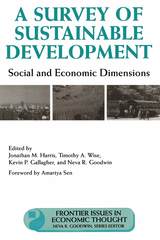 A Survey of Sustainable Development: Social And Economic Dimensions
Edited by Jonathan M. Harris, Timothy Wise, Kevin Gallagher, and Neva R. Goodwin; Foreword by Amartya Sen
Island Press, 2001 Perpetual economic growth is physically impossible on a planet with finite resources. Many concerned with humanity's future have focused on the concept of "sustainable development" as an alternative, as they seek means of achieving current economic and social goals without compromising the ability of future generations to meet their own goals. Sustainable development brings together elements of economics, public policy, sociology, ecology, resource management, and other related areas, and while the term has become quite popular, it is rarely defined, and even less often is it understood. A Survey of Sustainable Development addresses that problem by bringing together in a single volume the most important works on sustainable human and economic development. It offers a broad overview of the subject, and gives the reader a quick and thorough guide to this highly diffuse topic. The volume offers ten sections on topics including: - economic and social dimensions of sustainable development
- the North/South balance
- population and the demographic transition
- agriculture and renewable resources
- energy and materials use
- globalization and corporate responsibility
- local and national strategies
Each section is introduced with an essay by one of the volume editors that provides an overview of the subject and a summary of the mainstream literature, followed by two- to three-page abstracts of the most important articles or book chapters on the topic. A Survey of Sustainable Development is the sixth and final volume in the Frontier Issues of Economic Thought series produced by the Global Development And Environment Institute at Tufts University. Each book brings together the most important articles and book chapters in a "frontier" area of economics where important new work is being done but has not yet been incorporated into the mainstream of economic study. The book is an essential reference for students and scholars concerned with economics, environmental studies, public policy and administration, international development, and a broad range of related fields.
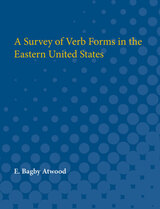 Survey of Verb Forms in the Eastern United States
E. Bagby Atwood
University of Michigan Press, 1953 A Survey of Verb Forms in the Eastern United States, like the recent Word Geography of the Eastern United States by Hans Kurath, is an outgrowth of the Linguistic Atlas of the United States and Canada—an undertaking that can truly be called the first large-scale attempt to determine the facts of American linguistic usage by means of direct investigation. Atlas field records covering the entire Eastern United States and representing persons of varying degrees of sophistication have been made available to the writer, and have enabled him to trace not only the geographical spread but also the social distribution of the linguistic features that are treated.This study, which confines itself to verb inflection, does more than differentiate "standard" from "vulgar" usages. It also demonstrates how the early culture centers and the principal migration areas are reflected in the dissemination of grammatical forms. Thus it makes clear that our "Vulgate" grammar, often thought to be uniform throughout the country, is in reality highly varied and regional in its character.
Survey Research in the Social Sciences
Charles Y. Glock
Russell Sage Foundation, 1967 Survey research was for a long time thought of primarily as a sociological tool. It is relatively recently that this research method has been adopted by other social sciences and related professional disciplines. The amount and quality of its use, however, vary considerably from field to field. This volume describes the elementary logic of survey design and analysis and provides, for each discipline, an evaluation of how survey research has been used and conceivably may be used to deal with the central problems of each field.
Surveying Ethnic Minorities and Immigrant Populations: Methodological Challenges and Research Strategies
Edited by Joan Font and Mónica Méndez
Amsterdam University Press, 2013 What challenges do researchers face when surveying immigrant populations and ethnic minorities? What are the best ways to ensure that general population surveys adequately represent minority groups? The first book to systematically address these questions, this volume analyzes more than a dozen surveys conducted in eight Western countries on topics ranging from politics to health. These case studies—which include local and national surveys with various levels of funding—offer valuable lessons about dealing with a range of methodological challenges.
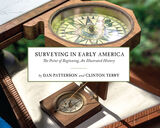 Surveying in Early America: The Point of Beginning, An Illustrated History
Dan Patterson; Clinton Terry
Ohio University Press, 2020 Published by the University of Cincinnati Press In Surveying in Early America: The Point of Beginning, An Illustrated History, award-winning photographer Dan Patterson and American historian Clinton Terry vividly examine the profession of surveying in the eighteenth century. Retracing the steps Washington and other surveyors took to map the Ohio River Valley, readers are immersed in historically accurate details of early surveying techniques and practices. Terry's narrative describes the practice of land and survey measurement—methods that did not substantially change until the invention of GPS technology 200 years later. Over 100 full color photographs exclusively shot for the book depict authentic and historically accurate reproductions of tools along with early American reenactors to provide an interpretive look at surveying as a primary means to building the American nation. Working with the Department of the Geographer, Patterson restages actual expeditions, brilliantly displaying the techniques and instruments Washington would have employed 260 years ago. Through the lens of Patterson's camera and Terry's accompanying narrative, readers see what Washington saw as he learned his trade, explored the vast American wilderness, and occasionally laid personal claim to great expanses of land along the way.
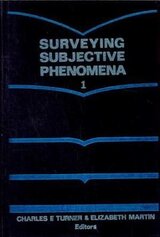 Surveying Subjective Phenomena
Charles Turner
Russell Sage Foundation, 1984 In January 1980 a panel of distinguished social scientists and statisticians assembled at the National Academy of Sciences to begin a thorough review of the uses, reliability, and validity of surveys purporting to measure such subjective phenomena as attitudes, opinions, beliefs, and preferences. This review was prompted not only by the widespread use of survey results in both academic and non-academic settings, but also by a proliferation of apparent discrepancies in allegedly equivalent measurements and by growing public concern over the value of such measurements. This two-volume report of the panel's findings is certain to become one of the standard works in the field of survey measurement. Volume I summarizes the state of the art of surveying subjective phenomena, evaluates contemporary measurement programs, examines the uses and abuses of such surveys, and candidly assesses the problems affecting them. The panel also offers strategies for improving the quality and usefulness of subjective survey data. In volume II, individual panel members and other experts explore in greater depth particular theoretical and empirical topics relevant to the panel's conclusions. For social scientists and policymakers who conduct, analyze, and rely on surveys of the national state of mind, this comprehensive and current review will be an invaluable resource.
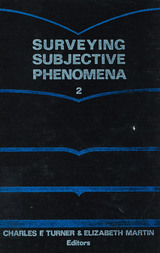 Surveying Subjective Phenomena
Charles Turner
Russell Sage Foundation, 1984 In January 1980 a panel of distinguished social scientists and statisticians assembled at the National Academy of Sciences to begin a thorough review of the uses, reliability, and validity of surveys purporting to measure such subjective phenomena as attitudes, opinions, beliefs, and preferences. This review was prompted not only by the widespread use of survey results in both academic and non-academic settings, but also by a proliferation of apparent discrepancies in allegedly equivalent measurements and by growing public concern over the value of such measurements. This two-volume report of the panel's findings is certain to become one of the standard works in the field of survey measurement. Volume I summarizes the state of the art of surveying subjective phenomena, evaluates contemporary measurement programs, examines the uses and abuses of such surveys, and candidly assesses the problems affecting them. The panel also offers strategies for improving the quality and usefulness of subjective survey data. In volume II, individual panel members and other experts explore in greater depth particular theoretical and empirical topics relevant to the panel's conclusions. For social scientists and policymakers who conduct, analyze, and rely on surveys of the national state of mind, this comprehensive and current review will be an invaluable resource.
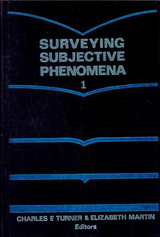 Surveying Subjective Phenomena
Charles Turner
Russell Sage Foundation, 1984 In January 1980 a panel of distinguished social scientists and statisticians assembled at the National Academy of Sciences to begin a thorough review of the uses, reliability, and validity of surveys purporting to measure such subjective phenomena as attitudes, opinions, beliefs, and preferences. This review was prompted not only by the widespread use of survey results in both academic and non-academic settings, but also by a proliferation of apparent discrepancies in allegedly equivalent measurements and by growing public concern over the value of such measurements. This two-volume report of the panel's findings is certain to become one of the standard works in the field of survey measurement. Volume I summarizes the state of the art of surveying subjective phenomena, evaluates contemporary measurement programs, examines the uses and abuses of such surveys, and candidly assesses the problems affecting them. The panel also offers strategies for improving the quality and usefulness of subjective survey data. In volume II, individual panel members and other experts explore in greater depth particular theoretical and empirical topics relevant to the panel's conclusions. For social scientists and policymakers who conduct, analyze, and rely on surveys of the national state of mind, this comprehensive and current review will be an invaluable resource.
Surveying The Archaeology Of Northwest Mexico
Gilliam E Newell
University of Utah Press, 2003
Archaeology in the Southwest is increasingly directing its attention south of the international border as it becomes clear that a picture of the pre-hispanic Southwest is incomplete without taking the Mexican Northwest into account.
Surveying the Archaeology of Northwest Mexico presents an overview of recent work in Sonora and Chihuahua, comprising a sort of professional tour of the area. The chapters offer fresh insights into the formation of centers such as Paquimé, Cerro de Trincheras, and the Rio Sonora cabaceras. Contributors explore relations between these centers, individual internal organization of the various identifiable polities, and the relation of the whole northwest Mexican region to better-known adjacent ones. The volume underscores that northwest Mexico was not a dependent hinterland but was inhabited by many independent groups throughout prehistory.
Surveying The Interior: Literary Cartographers And The Sense Of Place
Rick Van Noy
University of Nevada Press, 2003 From a cartographer who wrote to a writer who mapped, the literary significance of surveying is revealed in this study of human relationships to the landscape. From the very beginning, American literature was closely intertwined with surveying. In Surveying the Interior, Rick Van Noy explores the ways that four American literary cartographers—Henry David Thoreau, Clarence King, John Wesley Powell, and Wallace Stegner—concerned themselves with what it means to map or survey a place and what it means to write about it. In the process, he helps define the ways by which space enters the human psyche as definable place, as well as the ways by which physical landscape is transmuted into a sense of place as an intimate, personal manifestation of both physical and existential realities.
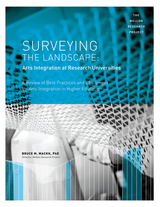 Surveying the Landscape: Arts Integration at Research Universities: A Review of Best Practices and Challenges for Arts Integration in Higher Education
Bruce M. Mackh, PhD
Michigan Publishing, 2015 Under the auspices of ArtsEngine at the University of Michigan, the Mellon Research Project examines the increasingly prevalent integration of arts practice and study at research universities. ArtsEngine National’s initial mission to “transform the research university through the infusion of arts practice” in response to growing recognition of the value of arts integration practices across the landscape of higher education led to a $500,000 grant from The Andrew W. Mellon Foundation. This grant supported an initial investigation of present practices in arts integration at researchuniversities, encompassing a national network of faculty and administrators who embrace innovative methods in teaching, research, and co-curricular programming linking the arts to other disciplinary domains.
This study presents “best practices in the integration of arts practice in U.S. research universities . . . , fulfill[ing] the need for a document that articulates models, obstacles, implementation strategies, costs, and impact on students and faculty as well as on research, practice, and teaching in other knowledge areas” (ArtsEngine). Rather than providing a detailed set of instructions, this document maps the landscape of arts integration at 30 partner institutions in the Alliance for the Arts in Research Universities (a2ru) and at 16 other institutions. It highlights aspirational models and presents an overall guide to current practices linking the arts to other learning areas.
Survival Arts Of The Primitive Paiutes
Margaret M. Wheat
University of Nevada Press, 1977 With over 24,000 copies in print, this bestselling book tells how the Paiutes survived in the harsh Nevada climate. Chronicling food-gathering methods, basket weaving, hunting, skinning, and working with rabbit skins, this book serves as an invaluable reference on early Paiute culture. Any inquiring person who has worked with the Native Americans of the West will testify to the difficulties of obtaining the information he seeks. They are an old and proud and reserved race, and acceptance of outsiders is not freely given. In her twenty years of painstaking work with the Northern Paiutes, Margaret Wheat earned that full measure of acceptance. She tells the story of the generation of Native Americans whose lives were changed forever by the arrival of pioneers and prospectors in 1849.
 Survival as Victory: Ukrainian Women in the Gulag
Oksana Kis
Harvard University Press, 2021 Of the hundreds of thousands of Ukrainian women were sentenced to the Gulag in the 1940s and 1950s, only half survived. In Survival as Victory, Oksana Kis has produced the first anthropological study of daily life in the Soviet forced labor camps as experienced by Ukrainian women prisoners.
Based on the written memoirs, autobiographies, and oral histories of over 150 survivors, this book fills a lacuna in the scholarship regarding Ukrainian experience. Kis details the women’s resistance to the brutality of camp conditions not only through the preservation of customs and traditions from everyday home life, but also through the frequent elision of regional and confessional differences. Following the groundbreaking work of Anne Applebaum’s Gulag: A History (2003), this book is a must-read for anyone interested in gendered strategies of survival, accommodation, and resistance to the dehumanizing effects of the Gulag.
Survival City: Adventures among the Ruins of Atomic America
Tom Vanderbilt
University of Chicago Press, 2002 On the road to Survival City, Tom Vanderbilt maps the visible and invisible legacies of the cold war, exhuming the blueprints for the apocalypse we once envisioned and chronicling a time when we all lived at ground zero. In this road trip among ruined missile silos, atomic storage bunkers, and secret test sites, a lost battleground emerges amid the architecture of the 1950s, accompanied by Walter Cotten’s stunning photographs. Survival City looks deep into the national soul, unearthing the dreams and fears that drove us during the latter half of the twentieth century.
“A crucial and dazzling book, masterful, and for me at least, intoxicating.”—Dave Eggers
“A genuinely engaging book, perhaps because [Vanderbilt] is skillful at conveying his own sense of engagement to the reader.”—Los Angeles Times
“A retracing of Dr. Strangelove as ordinary life.”—Greil Marcus, Bookforum
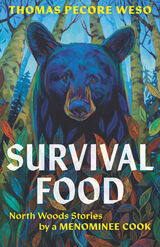 Survival Food: North Woods Stories by a Menominee Cook
Thomas Pecore Weso
Wisconsin Historical Society Press, 2023 An intimate and engaging Native food memoir
In these coming-of-age tales set on the Menominee Indian Reservation of the 1980s and 1990s, Thomas Pecore Weso explores the interrelated nature of meals and memories. As he puts it, “I cannot separate foods from the moments in my life when I first tasted them.” Weso’s stories recall the foods that influenced his youth in northern Wisconsin: subsistence meals from hunted, fished, and gathered sources; the culinary traditions of the German, Polish, and Swedish settler descendants in the area; and the commodity foods distributed by the government—like canned pork, dried beans, and powdered eggs—that made up the bulk of his family’s pantry. His mom called this “survival food.”
These stories from the author’s teen and tween years—some serious, some laugh-out-loud funny—will take readers from Catholic schoolyards to Native foot trails to North Woods bowling alleys, while providing Weso’s perspective on the political currents of the era. The book also contains dozens of recipes, from turtle soup and gray squirrel stew to twice-baked cheesy potatoes. This follow-up to Weso’s Good Seeds: A Menominee Indian Food Memoir is a hybrid of modern foodways, Indigenous history, and creative nonfiction from a singular storyteller.
2024 Wisconsin Library Association Outstanding Achievement Award
2024 PEN Oakland Josephine Miles Award for Excellence
Silver winner of the 2023 Midwest Book Award for Cookbooks/Crafts/Hobbies
Thomas Pecore Weso’s Survival Food was selected by the Wisconsin Center for the Book as the Wisconsin entry in the “Great Reads from Great Places” program of the Library of Congress.
“This book is not only about survival food, but about the singular beauty, creativity, and fortitude that comes out of that survival.”
—Chef Sean Sherman, author, The Sioux Chef’s Indigenous Kitchen
“Survival Food is interesting because it’s one part cookbook, three parts memoir, one part history, and one part multidisciplinary exploration of its setting, northern Wisconsin."
—James Norton, The Cookbook Test
“Nothing brings people together like good food and good stories. There’s an abundance of both in Thomas Pecore Weso’s latest memoir. As Weso attests, food can bring back happy, loving memories of times that were far from happy. Even a tray of funeral sandwiches brings a kind of comfort. This is a wonderful, honest portrait of northeastern Wisconsin, enlightening even to those of us who call this area home.”
—Jared Santek, Founder & Artistic Director, Write On Door County
“Survival Food provides ample nourishment for the mind and body. . . . The stories, told with humor and affection, are complemented by recipes ranging from mouth-watering instructions for cooking wild asparagus to ever-so-interesting advice for preparing bear stew.”
—Lucille Lang Day, author of Birds of San Pancho and Other Poems of Place and coeditor of Red Indian Road West: Native American Poetry from California
“His grandmother cooked according to Native traditions; his mother, ‘a nontraditional college student during my teens,’ resorted to instant meals. His grandfather was town constable and days spent with him brought Weso to the meatloaf, sausage and sauerkraut of German and Polish neighbors. Uncle Buddy’s flash car brings buckwheat pancakes to Weso’s mind, and he lived for a time near Cheese Box Curve—so called after a truck hauling dairy products overturned. Weso includes a few recipes, but mostly, Survival Food is an entertaining look back at life in Wisconsin’s rural north.”
—David Luhrssen, Shepherd Express
“Survival Food: North Woods Stories by a Menominee Cook by Thomas Pecore Weso is a posthumous sequel to his celebrated collection of family stories, Good Seeds: A Menominee Food Memoir. . . . Rich with captivating tales that include driving a convertible on logging roads, agreeing on terms before throwing eggs at passing cars, and his grandmother’s brief stay in a jailhouse she’d later purchase, Weso’s entries offer readers catharsis—demonstrating how to laugh, boast, debate, eat, mourn, and heal.”
—Ryan Winn, College of Menominee Nation, Tribal College Journal
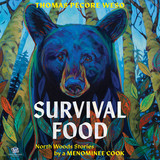 Survival Food: North Woods Stories by a Menominee Cook
Thomas Pecore Weso
Wisconsin Historical Society Press, 2025 An intimate and engaging Native food memoir
In these coming-of-age tales set on the Menominee Indian Reservation of the 1980s and 1990s, Thomas Pecore Weso explores the interrelated nature of meals and memories. As he puts it, “I cannot separate foods from the moments in my life when I first tasted them.” Weso’s stories recall the foods that influenced his youth in northern Wisconsin: subsistence meals from hunted, fished, and gathered sources; the culinary traditions of the German, Polish, and Swedish settler descendants in the area; and the commodity foods distributed by the government—like canned pork, dried beans, and powdered eggs—that made up the bulk of his family’s pantry. His mom called this “survival food.”
These stories from the author’s teen and tween years—some serious, some laugh-out-loud funny—will take readers from Catholic schoolyards to Native foot trails to North Woods bowling alleys, while providing Weso’s perspective on the political currents of the era. The book also contains dozens of recipes, from turtle soup and gray squirrel stew to twice-baked cheesy potatoes. This follow-up to Weso’s Good Seeds: A Menominee Indian Food Memoir is a hybrid of modern foodways, Indigenous history, and creative nonfiction from a singular storyteller.
2024 Wisconsin Library Association Outstanding Achievement Award
2024 PEN Oakland Josephine Miles Award for Excellence
Silver winner of the 2023 Midwest Book Award for Cookbooks/Crafts/Hobbies
Thomas Pecore Weso’s Survival Food was selected by the Wisconsin Center for the Book as the Wisconsin entry in the “Great Reads from Great Places” program of the Library of Congress.
“This book is not only about survival food, but about the singular beauty, creativity, and fortitude that comes out of that survival.”
—Chef Sean Sherman, author, The Sioux Chef’s Indigenous Kitchen
“Survival Food is interesting because it’s one part cookbook, three parts memoir, one part history, and one part multidisciplinary exploration of its setting, northern Wisconsin."
—James Norton, The Cookbook Test
“Nothing brings people together like good food and good stories. There’s an abundance of both in Thomas Pecore Weso’s latest memoir. As Weso attests, food can bring back happy, loving memories of times that were far from happy. Even a tray of funeral sandwiches brings a kind of comfort. This is a wonderful, honest portrait of northeastern Wisconsin, enlightening even to those of us who call this area home.”
—Jared Santek, Founder & Artistic Director, Write On Door County
“Survival Food provides ample nourishment for the mind and body. . . . The stories, told with humor and affection, are complemented by recipes ranging from mouth-watering instructions for cooking wild asparagus to ever-so-interesting advice for preparing bear stew.”
—Lucille Lang Day, author of Birds of San Pancho and Other Poems of Place and coeditor of Red Indian Road West: Native American Poetry from California
“His grandmother cooked according to Native traditions; his mother, ‘a nontraditional college student during my teens,’ resorted to instant meals. His grandfather was town constable and days spent with him brought Weso to the meatloaf, sausage and sauerkraut of German and Polish neighbors. Uncle Buddy’s flash car brings buckwheat pancakes to Weso’s mind, and he lived for a time near Cheese Box Curve—so called after a truck hauling dairy products overturned. Weso includes a few recipes, but mostly, Survival Food is an entertaining look back at life in Wisconsin’s rural north.”
—David Luhrssen, Shepherd Express
“Survival Food: North Woods Stories by a Menominee Cook by Thomas Pecore Weso is a posthumous sequel to his celebrated collection of family stories, Good Seeds: A Menominee Food Memoir. . . . Rich with captivating tales that include driving a convertible on logging roads, agreeing on terms before throwing eggs at passing cars, and his grandmother’s brief stay in a jailhouse she’d later purchase, Weso’s entries offer readers catharsis—demonstrating how to laugh, boast, debate, eat, mourn, and heal.”
—Ryan Winn, College of Menominee Nation, Tribal College Journal
 Survival Guide for Scientists: Writing - Presentation - Email
Ad Lagendijk
Amsterdam University Press, 2009 During the course of Dutch physicist and Spinoza Prize-winner Ad Lagendijk’s long and influential career, he has published more than 300 articles, supervised over thirty doctoral dissertations, and given countless presentations and conference addresses. Over the years, his incisive consultations, tips, and rules for scientific study have proven themselves so beneficial to the emerging scientists under his watch that he has been inundated with requests for a written version. Aimed primarily at undergraduate, graduate, and postdoctoral students, this essential guide presents Lagendijk’s practical how-to advice on topics such as writing scientific texts, presenting data and research information, and the writing and reading of collegial emails. Each section is organised by a collection of short rules, outlined and numbered in a logical order as selfexplanatory pieces of information – allowing the reader the freedom to study any number of them in any desired order. But it doesn’t stop there: many of the hints, in particular those referring to presentations, are of invaluable use for a much broader audience of professionals, up to consultants and (public) managers. Survival Guide for Scientists is complimented by www.sciencesurvivalblog.com where Lagendijk and others explore ways of making scientific writing more effective.
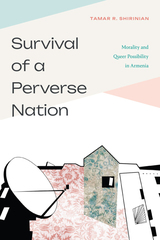 Survival of a Perverse Nation: Morality and Queer Possibility in Armenia
Tamar R. Shirinian
Duke University Press, 2024 In Survival of a Perverse Nation, Tamar R. Shirinian traces two widespread rhetorics of perversion—sexual and moral—in postsocialist Armenia, showing how they are tied to anxieties about the nation’s survival. In her fieldwork with Armenians, Shirinian found that right-wing nationalists’ focus on sexual perversion centers the figure of the homosexual, while questions of moral perversion surround oligarchs and other members of the political-economic elite. While the homosexual is seen as non- or improperly reproductive, the oligarch’s moral deviations from the caring and paternalistic expectations associated with national leadership also endanger Armenia’s survival. Shirinian shows how both figures threaten the nation’s proper social reproduction, a source of great anxiety for a nation whose primary point of identity is surviving genocide. In the existential threat posed by these forms of perversion Shirinian finds paths where nonsurvival might mean the creation of futures that are queerer and more just. Detailing how the language of perversion offers trenchant critiques of capitalism as a perversion of life, Shirinian presents a new queer theory of political economy.
 Survival on the Margins: Polish Jewish Refugees in the Wartime Soviet Union
Eliyana R. Adler
Harvard University Press, 2020 Co-winner of the Yad Vashem International Book Prize for Holocaust Research
The forgotten story of 200,000 Polish Jews who escaped the Holocaust as refugees stranded in remote corners of the USSR.
Between 1940 and 1946, about 200,000 Jewish refugees from Poland lived and toiled in the harsh Soviet interior. They endured hard labor, bitter cold, and extreme deprivation. But out of reach of the Nazis, they escaped the fate of millions of their coreligionists in the Holocaust.
Survival on the Margins is the first comprehensive account in English of their experiences. The refugees fled Poland after the German invasion in 1939 and settled in the Soviet territories newly annexed under the Molotov-Ribbentrop Pact. Facing hardship, and trusting little in Stalin, most spurned the offer of Soviet citizenship and were deported to labor camps in unoccupied areas of the east. They were on their own, in a forbidding wilderness thousands of miles from home. But they inadvertently escaped Hitler’s 1941 advance into the Soviet Union. While war raged and Europe’s Jews faced genocide, the refugees were permitted to leave their settlements after the Soviet government agreed to an amnesty. Most spent the remainder of the war coping with hunger and disease in Soviet Central Asia. When they were finally allowed to return to Poland in 1946, they encountered the devastation of the Holocaust, and many stopped talking about their own ordeals, their stories eventually subsumed within the central Holocaust narrative.
Drawing on untapped memoirs and testimonies of the survivors, Eliyana Adler rescues these important stories of determination and suffering on behalf of new generations.
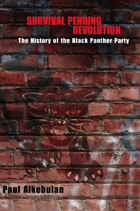 Survival Pending Revolution: The History of the Black Panther Party
Paul Alkebulan
University of Alabama Press, 2007 The Black Panther Party (BPP) seized the attention of America in the frenetic days of the late 1960s when a series of assassinations, discontent with the Vietnam War, and impatience with lingering racial discrimination roiled the United States, particularly its cities. The BPP inspired dread among the American body politic while receiving support from many urban black youths. The images of angry and armed young black radicals in the streets of U.S. cities seemed a stunning reversal and repudiation of the accommodationist and assimilationist black goals associated with Martin Luther King’s movement, as well as an unprecedented defiance of the civil power. Although many have written about the BPP in memoirs and polemics, Survival Pending Revolution contributes to a new generation of objective, analytical BPP studies that are sorely needed. Alkebulan displays the entire movement’s history: its lofty and even idealistic goals and its in-your-face rhetoric, its strategies, tactics, and the internal divisions and ego clashes, drawing upon public records as well as the memories of both leaders and foot soldiers, to attempt a description that both understands the inner workings of the BPP and its role in the greater society.
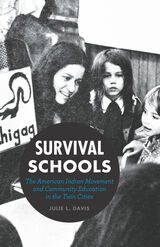 Survival Schools: The American Indian Movement and Community Education in the Twin Cities
Julie L. Davis
University of Minnesota Press, 2013
In the late 1960s, Indian families in Minneapolis and St. Paul were under siege. Clyde Bellecourt remembers, “We were losing our children during this time; juvenile courts were sweeping our children up, and they were fostering them out, and sometimes whole families were being broken up.” In 1972, motivated by prejudice in the child welfare system and hostility in the public schools, American Indian Movement (AIM) organizers and local Native parents came together to start their own community school. For Pat Bellanger, it was about cultural survival. Though established in a moment of crisis, the school fulfilled a goal that she had worked toward for years: to create an educational system that would enable Native children “never to forget who they were.”
While AIM is best known for its national protests and political demands, the survival schools foreground the movement’s local and regional engagement with issues of language, culture, spirituality, and identity. In telling of the evolution and impact of the Heart of the Earth school in Minneapolis and the Red School House in St. Paul, Julie L. Davis explains how the survival schools emerged out of AIM’s local activism in education, child welfare, and juvenile justice and its efforts to achieve self-determination over urban Indian institutions. The schools provided informal, supportive, culturally relevant learning environments for students who had struggled in the public schools. Survival school classes, for example, were often conducted with students and instructors seated together in a circle, which signified the concept of mutual human respect. Davis reveals how the survival schools contributed to the global movement for Indigenous decolonization as they helped Indian youth and their families to reclaim their cultural identities and build a distinctive Native community. The story of these schools, unfolding here through the voices of activists, teachers, parents, and students, is also an in-depth history of AIM’s founding and early community organizing in the Twin Cities—and evidence of its long-term effect on Indian people’s lives.
 Survival Strategies: Cooperation and Conflict in Animal Societies
Raghavendra Gadagkar
Harvard University Press, 2001 Did you know that Tasmanian hens have two husbands? That cellular slime molds commit suicide? That vampire bats will share food with hungry fellow bats and that hanuman langurs commit infanticide? Why creatures great and small behave in such fascinating and seemingly perplexing ways is explained in this delightful account of the evolutionary foundations of animal social behavior.
Only in recent years have biologists and ethologists begun to apply careful evolutionary thinking to the study of animal societies--and with spectacular results. This book presents the choicest of these findings, with a remarkable wealth of insights into the myriad strategies that animals have developed to perpetuate their kind. In an irresistible style, Raghavendra Gadagkar explores the strategies of cooperation and conflict adopted by animals--from the lordly lion to the primitive wasp worker--as they choose mates, raise their young, communicate with others, and establish the division of labor necessary to feed and protect the group and safeguard their territory.
Whether focusing on the birds or the bees, this book offers both superb descriptions and lucid explanations of many different behaviors encountered in the animal world: why a ground squirrel will sound an alarm--even risk its own safety--to warn fellow squirrels of impending danger; why weaver ant larvae donate silk for nest building; why house mice raise their offspring in a communal nursery; and how animals can recognize the relatives they want to favor--or avoid.
Illustrated with both photographs and explanatory diagrams, this expert and inviting tour of the social world of animals will inform and charm anyone curious about the motivations behind the amazing range of activity in the animal kingdom.
Survival This Way: Interviews with American Indian Poets
Joseph Bruchac
University of Arizona Press, 1987 Twenty-one leading American Indian poets discuss the role of Native American culture in their work, the forces that shape contemporary Native American poetry, and the prospects of that poetry's surviving as a form apart from the poetry of the dominant culture.
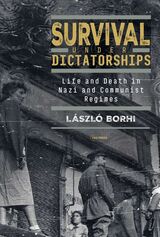 Survival under Dictatorships: Life and Death in Nazi and Communist Regimes
László Borhi
Central European University Press, 2024 A complex array of individual responses to the abuse of power by the state is represented in this book in three horrific episodes in the history of East-Central Europe. The three events followed each other within a span of about ten years: the deportation and murder of Hungarian Jews in Nazi death and labor camps; the Arrow Cross terrorist rule in Budapest; and finally the Stalinist terror in Hungary and East-Central Europe. Through the prism of survival, László Borhi explores the relationship between the individual and power, attempting to understand the mechanism of oppression and terror produced by arbitrary, unbridled power through the experience of normal people. Despite the obvious peculiarities of time and place, the Hungarian cases convey universal lessons about the Holocaust, Nazism, and Stalinism. In the author's conception, the National Socialist and Stalinist experiences are linked on several levels. Both regimes defended their visions of the future against social groups whom they saw as implacable enemies of those visions, and who therefore had to be destroyed for sake of social perfection. Furthermore, the social practices of National Socialism were passed on. And although Stalinism was imposed by a foreign power, some of the survival skills for coping with it were rehearsed under the previous hellish experience.
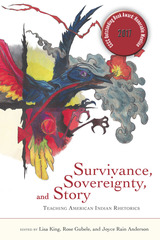 Survivance, Sovereignty, and Story: Teaching American Indian Rhetorics
Lisa King
Utah State University Press, 2015 Focusing on the importance of discussions about sovereignty and of the diversity of Native American communities, Survivance, Sovereignty, and Story offers a variety of ways to teach and write about indigenous North American rhetorics. These essays introduce indigenous rhetorics, framing both how and why they should be taught in US university writing classrooms. Contributors promote understanding of American Indian rhetorical and literary texts and the cultures and contexts within which those texts are produced. Chapters also supply resources for instructors, promote cultural awareness, offer suggestions for further research, and provide examples of methods to incorporate American Indian texts into the classroom curriculum. Survivance, Sovereignty, and Story provides a decolonized vision of what teaching rhetoric and writing can be and offers a foundation to talk about what rhetoric and pedagogical practice can mean when examined through American Indian and indigenous epistemologies and contemporary rhetorics.
Contributors include Joyce Rain Anderson, Resa Crane Bizzaro, Qwo-Li Driskill, Janice Gould, Rose Gubele, Angela Haas, Jessica Safran Hoover, Lisa King, Kimberli Lee, Malea D. Powell, Andrea Riley-Mukavetz, Gabriela Raquel Ríos, and Sundy Watanabe.
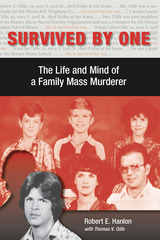 Survived by One: The Life and Mind of a Family Mass Murderer
Robert E. Hanlon, PhD with Thomas V. Odle
Southern Illinois University Press, 2013 On November 8, 1985, 18-year-old Tom Odle brutally murdered his parents and three siblings in the small southern Illinois town of Mount Vernon, sending shockwaves throughout the nation. The murder of the Odle family remains one of the most horrific family mass murders in U.S. history. Odle was sentenced to death and, after seventeen years on death row, expected a lethal injection to end his life. However, Illinois governor George Ryan’s moratorium on the death penalty in 2000, and later commutation of all death sentences in 2003, changed Odle’s sentence to natural life. The commutation of his death sentence was an epiphany for Odle. Prior to the commutation of his death sentence, Odle lived in denial, repressing any feelings about his family and his horrible crime. Following the commutation and the removal of the weight of eventual execution associated with his death sentence, he was confronted with an unfamiliar reality. A future. As a result, he realized that he needed to understand why he murdered his family. He reached out to Dr. Robert Hanlon, a neuropsychologist who had examined him in the past. Dr. Hanlon engaged Odle in a therapeutic process of introspection and self-reflection, which became the basis of their collaboration on this book. Hanlon tells a gripping story of Odle’s life as an abused child, the life experiences that formed his personality, and his tragic homicidal escalation to mass murder, seamlessly weaving into the narrative Odle’s unadorned reflections of his childhood, finding a new family on death row, and his belief in the powers of redemption. As our nation attempts to understand the continual mass murders occurring in the U.S., Survived by One sheds some light on the psychological aspects of why and how such acts of extreme carnage may occur. However, Survived by One offers a never-been-told perspective from the mass murderer himself, as he searches for the answers concurrently being asked by the nation and the world.
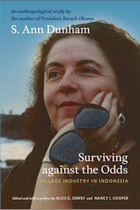 Surviving against the Odds: Village Industry in Indonesia
S. Ann Dunham
Duke University Press, 2009 President Barack Obama’s mother, S. Ann Dunham, was an economic anthropologist and rural development consultant who worked in several countries including Indonesia. Dunham received her doctorate in 1992. She died in 1995, at the age of 52, before having the opportunity to revise her dissertation for publication, as she had planned. Dunham’s dissertation adviser Alice G. Dewey and her fellow graduate student Nancy I. Cooper undertook the revisions at the request of Dunham’s daughter, Maya Soetoro-Ng. The result is Surviving against the Odds, a book based on Dunham’s research over a period of fourteen years among the rural metalworkers of Java, the island home to nearly half Indonesia’s population. Surviving against the Odds reflects Dunham’s commitment to helping small-scale village industries survive; her pragmatic, non-ideological approach to research and problem solving; and her impressive command of history, economic data, and development policy. Along with photographs of Dunham, the book includes many pictures taken by her in Indonesia. After Dunham married Lolo Soetoro in 1967, she and her six-year-old son, Barack Obama, moved from Hawai‘i to Soetoro’s home in Jakarta, where Maya Soetoro was born three years later. Barack returned to Hawai‘i to attend school in 1971. Dedicated to Dunham’s mother Madelyn, her adviser Alice, and “Barack and Maya, who seldom complained when their mother was in the field,” Surviving against the Odds centers on the metalworking industries in the Javanese village of Kajar. Focusing attention on the small rural industries overlooked by many scholars, Dunham argued that wet-rice cultivation was not the only viable economic activity in rural Southeast Asia. Surviving against the Odds includes a preface by the editors, Alice G. Dewey and Nancy I. Cooper, and a foreword by her daughter Maya Soetoro-Ng, each of which discusses Dunham and her career. In his afterword, the anthropologist and Indonesianist Robert W. Hefner explores the content of Surviving against the Odds, its relation to anthropology when it was researched and written, and its continuing relevance today.
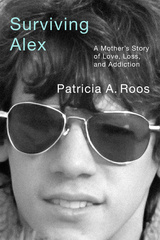 Surviving Alex: A Mother’s Story of Love, Loss, and Addiction
Patricia A. Roos
Rutgers University Press, 2024 In 2015, Patricia Roos’s twenty-five-year-old son Alex died of a heroin overdose. Turning her grief into action, Roos, a professor of sociology at Rutgers University, began to research the social factors and institutional failures that contributed to his death. Surviving Alex tells her moving story—and outlines the possibilities of a more compassionate and effective approach to addiction treatment. Weaving together a personal narrative and a sociological perspective, Surviving Alex movingly describes how even children from “good families” fall prey to addiction, and recounts the hellish toll it takes on families. Drawing from interviews with Alex’s friends, family members, therapists, teachers, and police officers—as well as files from his stays in hospitals, rehab facilities, and jails—Roos paints a compelling portrait of a young man whose life veered between happiness, anxiety, success, and despair. And as she explores how a punitive system failed her son, she calls for a community of action that would improve care for substance users and reduce addiction, realigning public health policy to address the overdose crisis.
 Surviving Climate Change: The Struggle to Avert Global Catastrophe
Edited by David Cromwell and Mark Levene
Pluto Press, 2007 Climate change is a pressing reality. Hurricane Katrina, melting polar ice and increased threats to food and water security show that planetary blowback is becoming all too evident.
Governments and business keep reassuring the public they are going to fix the problem. This book brings together some leading activists who disagree. They expose the inertia, denial, deception -- even threats to our civil liberties -- which comprise mainstream responses from civil and military policy makers, and from opinion formers in the media, corporations and academia.
An epochal change is called for in the way we all engage with the climate crisis. Key to that change is Aubrey Meyer's proposed Contraction and Convergence framework for limiting global carbon emissions. This book, which also includes contributions by Mayer Hillman and George Marshall, is a powerful and vital guide to how mass mobilisation can avert the looming catastrophe.
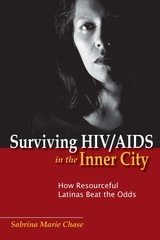 Surviving HIV/AIDS in the Inner City: How Resourceful Latinas Beat the Odds
Chase, Sabrina
Rutgers University Press, 2011 Surviving HIV/AIDS in the Inner City explores the survival strategies of poor, HIV-positive Puerto Rican women by asking four key questions: Given their limited resources, how did they manage an illness as serious as HIV/AIDS? Did they look for alternatives to conventional medical treatment? Did the challenges they faced deprive them of self-determination, or could they help themselves and each other? What can we learn from these resourceful women?
Based on her work with minority women living in Newark, New Jersey, Sabrina Marie Chase illuminates the hidden traps and land mines burdening our current health care system as a whole. For the women she studied, alliances with doctors, nurses, and social workers could literally mean the difference between life and death. By applying the theories of sociologist Pierre Bourdieu to the day-to-day experiences of HIV-positive Latinas, Chase explains why some struggled and even died while others flourished and thrived under difficult conditions. These gripping, true-life stories advocate for those living with chronic illness who depend on the health care "safety net." Through her exploration of life and death among Newark's resourceful women, Chase provides the groundwork for inciting positive change in the U.S. health care system.
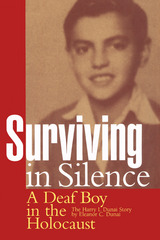 Surviving in Silence: A Deaf Boy in the Holocaust, The Harry I. Dunai Story
Eleanor C. Dunai
Gallaudet University Press, 2002 Izrael Zachariah Deutsch was born on March 15, 1934, in Komjata, Czechoslovakia. The second youngest child, Izrael lived a bucolic existence with nine brothers and sisters on a farm, differing from them only in that he was deaf. When he was six, his mother took him to Budapest, Hungary, and enrolled him in a Jewish school for deaf children, where he thrived. Soon, however, the Nazi regime in Germany and the Arrow Cross fascists in Hungary destroyed Izrael’s world forever.
Izrael realized that by being both Jewish and deaf, he faced a double threat of being exported to the gas chambers in Poland. But at every lethal junction, he found a way to survive, first by buying and reselling pastries for extra money that later saved his life in the Budapest ghetto. Still, Izrael was close to death from starvation when he was liberated by Russian soldiers on January 18, 1945.
Izrael survived the war only to learn that his parents and two brothers had been murdered by the Nazis. The rest of his brothers and sisters scattered to distant parts of the world. Forced to remain in Budapest, Izrael finished school and became an accomplished machinist. He avoided any part in the Hungarian uprising in 1956 so that he could secure a visa to leave for Sweden. From Sweden he traveled throughout Europe and Israel, using an amazing network of Holocaust survivors, relatives, and deaf friends to ease his journey. He finally settled in Los Angeles, where he married a deaf Jewish woman he had met years before. Along the way, he changed his name from Izrael Deutsch to Harry Dunai.
Surviving in Two Worlds: Contemporary Native American Voices
By Lois Crozier-Hogle and Darryl Babe Wilson
University of Texas Press, 1997 Surviving in Two Worlds brings together the voices of twenty-six Native American leaders. The interviewees come from a variety of tribal backgrounds and include such national figures as Oren Lyons, Arvol Looking Horse, John Echohawk, William Demmert, Clifford Trafzer, Greg Sarris, and Roxanne Swentzell. Their interviews are divided into five sections, grouped around the themes of tradition, history and politics, healing, education, and culture. They take readers into their lives, their dreams and fears, their philosophies and experiences, and show what they are doing to assure the survival of their peoples and cultures, as well as the earth as a whole. Their analyses of the past and present, and especially their counsels for the future, are timely and urgent.
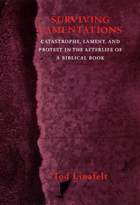 Surviving Lamentations: Catastrophe, Lament, and Protest in the Afterlife of a Biblical Book
Tod Linafelt
University of Chicago Press, 2000 Most contemporary interpretations of the biblical book of Lamentations focus on the figure of the "suffering man" as a role model for submission in the face of God's punishment for sin. Yet such a model offers small consolation to survivors of the Holocaust or other mass atrocities and also ignores chapters 1 and 2 of Lamentations, in which the personification of Zion laments her sufferings and demands a response on behalf of her dying children.
In Surviving Lamentations, Tod Linafelt offers an alternative reading of Lamentations in light of the "literature of survival" (works written by survivors of catastrophe) as well as literary and philosophical reflections on "the survival of literature." He refocuses attention on the figure of Zion as a manifestation of a basic need to give voice to suffering, and traces the afterlife of Lamentations in Jewish literature, in which text after text attempts to provide the response to Zion's lament that is lacking in Lamentations itself.
Seen through Linafelt's eyes, Lamentations emerges as uncannily relevant to contemporary discourse on survival.
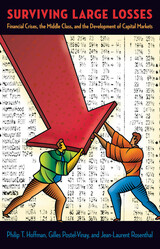 Surviving Large Losses: Financial Crises, the Middle Class, and the Development of Capital Markets
Philip T. Hoffman, Gilles Postel-Vinay, and Jean-Laurent Rosenthal
Harvard University Press, 2009 Listen to a short interview with Philip T. HoffmanHost: Chris Gondek | Producer: Heron & Crane
Financial disasters often have long-range institutional consequences. When financial institutions--banks, insurance companies, brokerage firms, stock exchanges--collapse, new ones take their place, and these changes shape markets for decades or even generations. Surviving Large Losses explains why such financial crises occur, why their effects last so long, and what political and economic conditions can help countries both rich and poor survive--and even prosper--in the aftermath.Looking at past and more recent financial disasters through the lens of political economy, the authors identify three factors critical to the development of financial institutions: the level of government debt, the size of the middle class, and the quality of information that is available to participants in financial transactions. They seek to find out when these factors promote financial development and mitigate the effects of financial crises and when they exacerbate them.Although there is no panacea for crises--no one set of institutions that will resolve them--it is possible, the authors argue, to strengthen existing financial institutions, to encourage economic growth, and to limit the harm that future catastrophes can do.
 Surviving Literary Suicide
Jeffrey Berman
University of Massachusetts Press, 1999 An exploration of the relationship between literature and life, this study examines the effect on readers of "suicidal literature"—novels and poems that depict, and sometimes glorify, the act of suicide. Beginning with a discussion of the growing incidence of suicide in American culture, Jeffrey Berman investigates the portrayal of suicide in the works of four authors who later took their own lives—Virginia Woolf, Ernest Hemingway, Sylvia Plath, and Anne Sexton— and two who did not—Kate Chopin and William Styron. In each case Berman discusses the writer's shifting attitude toward suicide, the tendency of critics to romanticize fictional suicide, and the impact of writing about suicide on the artist's own life. At the same time, Berman draws on his experiences as a teacher of these writings, analyzing student reactions to "literary suicide" as recorded in class diaries—responses ranging from grief and confusion to anger and guilt. By looking at the connection between real and imagined suicide, Berman seeks to shed fresh light on a subject long enshrouded in silence, fear, and mystery.
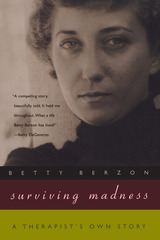 Surviving Madness: A Therapist's Own Story
Betty Berzon
University of Wisconsin Press, 2002 Betty Berzon, renowned psychotherapist and author of the bestselling book Permanent Partners, tells her own incredible story here. Berzon’s journey from psychiatric patient on suicide watch—her wrists tethered to the bed rails in a locked hospital ward—to her present role as a groundbreaking therapist and gay pioneer makes for purely compelling reading.
Berzon is recognized today as a trailblazing co-founder of a number of important lesbian and gay organizations and one of the first therapists to focus on means of developing healthy gay relationships and overcoming homophobia. Her sometimes bumpy road to success never fails to fascinate. Along the way she encounters such luminaries as Anaïs Nin, Eleanor Roosevelt, the Sitwells, Evelyn Hooker, and Paul Monette. Her recollections here provide a collective portrait of her fellow pioneers and a stirring lesson in twentieth-century history.
It is, however, the intimate story of Berzon’s own private passage toward self-discovery—from mental breakdown and suicide attempts, through hospitalization, eventual triumphant recovery, and her own coming out as an open lesbian at the age of forty—that makes this memoir an urgent, insightful, and deeply emotional testament to human survival.
SURVIVING MAE WEST
A Novel by Priscilla A. Rodd
West Virginia University Press, 2006 Tess, a West Virginian in New York City, finds herself among seedy brothels facing life as a prostitute. A number of trials test her in every way, leading to both understanding and misunderstanding among her friends and her family. Tess tells these stories of pain, joy, depression, loneliness, and endurance in her journal, and they will shock some readers and charm others. With the shadow of the Appalachians calling her back home, she desperately struggles to claim her individuality in a world of debauchery without the painful remnants of her past and fear of a fragmented future overwhelming her.
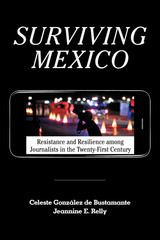 Surviving Mexico: Resistance and Resilience among Journalists in the Twenty-first Century
By Celeste González de Bustamante and Jeannine E. Relly
University of Texas Press, 2021 Mott KTA Journalism and Mass Communication Research Award, Kappa Tau Alpha
Tankard Book Award, Association for Education in Journalism and Mass Communication (AEJMC)
Knudson Latin America Prize, Association for Education in Journalism and Mass Communication (AEJMC) Since 2000, more than 150 journalists have been killed in Mexico. Today the country is one of the most dangerous in the world in which to be a reporter. In Surviving Mexico, Celeste González de Bustamante and Jeannine E. Relly examine the networks of political power, business interests, and organized crime that threaten and attack Mexican journalists, who forge ahead despite the risks. Amid the crackdown on drug cartels, overall violence in Mexico has increased, and journalists covering the conflict have grown more vulnerable. But it is not just criminal groups that want reporters out of the way. Government forces also attack journalists in order to shield corrupt authorities and the very criminals they are supposed to be fighting. Meanwhile some news organizations, enriched by their ties to corrupt government officials and criminal groups, fail to support their employees. In some cases, journalists must wait for a “green light” to publish not from their editors but from organized crime groups. Despite seemingly insurmountable constraints, journalists have turned to one another and to their communities to resist pressures and create their own networks of resilience. Drawing on a decade of rigorous research in Mexico, González de Bustamante and Relly explain how journalists have become their own activists and how they hold those in power accountable.
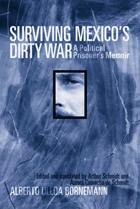 Surviving Mexico's Dirty War: A Political Prisoner's Memoir
Alberto Ulloa Bornemann, edited by Arthur Schmidt and Aurora Camacho de Schmidt
Temple University Press, 2007 This is the first major, book-length memoir of a political prisoner from Mexico's "dirty war" of the 1970s. Written with the urgency of a first-person narrative, it is a unique work, providing an inside story of guerrilla activities and a gripping tale of imprisonment and torture at the hands of the Mexican government. Alberto Ulloa Bornemann was a young idealist when he dedicated himself to clandestine resistance and to assisting Lucio Cabañas, the guerrilla leader of the "Party of the Poor." Here the author exposes readers to the day-to-day activities of revolutionary activists seeking to avoid discovery by government forces. After his capture, Ulloa Bornemann endured disappearance into a secret military jail and later abusive conditions in three civilian prisons. Although testimonios of former political prisoners from other Latin American nations have recently come into print, there are very few books about Mexico's political wars—and none as vivid and disturbing as this.
 Surviving Modern Medicine: How to Get the Best From Doctors, Family, and Friends
Clarke, Peter
Rutgers University Press, 1998 "Surviving Modern Medicine" gives consumers the practical steps they can take to navigate today's confusing medical world to improve the quality of care they receive. The authors dig through leading research for down-to-earth tips that any patient can apply to: open lines of communication with doctors; weigh the risks and benefits among treatment options; mobilize understanding and effective support from family and friends; overcome the fatigue and guilt of long-term cargiving; and control life-support situations to balance high-technology against an acceptable quality of life. Readers learn how to battle with a stubborn HMO and to select the right coverage in the first place. Patients discover how to make better use of their office visits, communicating effectively with doctors by asking the right questions and remembering crucial facts. The book features the authors' nationally-tested guide to decision making about critical care and to completing a Living Will or Healthcare Power of Attorney. Throughout, the book provides simple exercises that readers can practice. These exercises allow patients to replace frustating and perplexing encounters with the health and medical bureaucracy with successful ones.
 Surviving Sacrilege: Cultural Persistence in Jewish Antiquity
Steven Weitzman
Harvard University Press, 2005 In a world of relentless and often violent change, what does it take for a culture to survive? Steven Weitzman addresses this question by exploring the "arts of cultural persistence"--the tactics that cultures employ to sustain themselves in the face of intractable realities. Surviving Sacrilege focuses on a famously resilient culture caught between two disruptive acts of sacrilege: ancient Judaism between the destruction of the First Temple (by the Babylonians) in 586 B.C. and the destruction of the Second Temple (by the Romans) in 70 C.E..
Throughout this period Jews faced the challenge of preserving their religious traditions in a world largely out of their control--a world ruled first by the Persians, then by the Hellenistic Seleucid Kingdom, and finally by the Roman Empire. Their struggle to answer this challenge yields insight into the ingenuity, resourcefulness, and creativity of a distinctive period in Jewish history, but one with broad implications for the study of religious and cultural survival.
Detecting something tenaciously self-preserving at the core of the imagination, Weitzman argues that its expression in storytelling, fantasy, imitation, metaphor, and magic allows a culture's survival instinct to maneuver within, beyond, and even against the limits of reality.
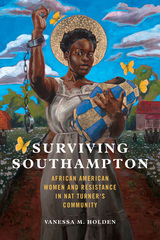 Surviving Southampton: African American Women and Resistance in Nat Turner's Community
Vanessa M. Holden
University of Illinois Press, 2021 The local community around the Nat Turner rebellion The 1831 Southampton Rebellion led by Nat Turner involved an entire community. Vanessa M. Holden rediscovers the women and children, free and enslaved, who lived in Southampton County before, during, and after the revolt. Mapping the region's multilayered human geography, Holden draws a fuller picture of the inhabitants, revealing not only their interactions with physical locations but also their social relationships in space and time. Her analysis recasts the Southampton Rebellion as one event that reveals the continuum of practices that sustained resistance and survival among local Black people. Holden follows how African Americans continued those practices through the rebellion’s immediate aftermath and into the future, showing how Black women and communities raised children who remembered and heeded the lessons absorbed during the calamitous events of 1831. A bold challenge to traditional accounts, Surviving Southampton sheds new light on the places and people surrounding Americas most famous rebellion against slavery.
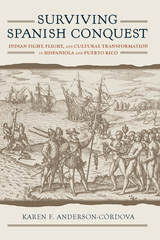 Surviving Spanish Conquest: Indian Fight, Flight, and Cultural Transformation in Hispaniola and Puerto Rico
Karen F. Anderson-Córdova
University of Alabama Press, 2017 Reveals the transformation that occurred in Indian communities during the Spanish conquest of Hispaniola and Puerto Rico from 1492 to 1550
In Surviving Spanish Conquest: Indian Fight, Flight, and Cultural Transformation in Hispaniola and Puerto Rico, Karen F. Anderson-Córdova draws on archaeological, historical, and ethnohistorical sources to elucidate the impacts of sixteenth-century Spanish conquest and colonization on indigenous peoples in the Greater Antilles. Moving beyond the conventional narratives of the quick demise of the native populations because of forced labor and the spread of Old World diseases, this book shows the complexity of the initial exchange between the Old and New Worlds and examines the myriad ways the indigenous peoples responded to Spanish colonization.
Focusing on Hispaniola and Puerto Rico, the first Caribbean islands to be conquered and colonized by the Spanish, Anderson-Córdova explains Indian sociocultural transformation within the context of two specific processes, out-migration and in-migration, highlighting how population shifts contributed to the diversification of peoples. For example, as the growing presence of “foreign” Indians from other areas of the Caribbean complicated the variety of responses by Indian groups, her investigation reveals that Indians who were subjected to slavery, or the “encomienda system,” accommodated and absorbed many Spanish customs, yet resumed their own rituals when allowed to return to their villages. Other Indians fled in response to the arrival of the Spanish.
The culmination of years of research, Surviving Spanish Conquest deftly incorporates archaeological investigations at contact sites copious use of archival materials, and anthropological assessments of the contact period in the Caribbean. Ultimately, understanding the processes of Indian-Spanish interaction in the Caribbean enhances comprehension of colonization in many other parts of the world. Anderson-Córdova concludes with a discussion regarding the resurgence of interest in the Taíno people and their culture, especially of individuals who self-identify as Taíno. This volume provides a wealth of insight to historians, anthropologists, archaeologists, and those interested in early cultures in contact.
Surviving Sudden Environmental Change: Answers From Archaeology
Jago Cooper
University Press of Colorado, 2012 Archaeologists have long encountered evidence of natural disasters through excavation and stratigraphy. In Surviving Sudden Environmental Change, case studies examine how eight different past human communities-ranging from Arctic to equatorial regi
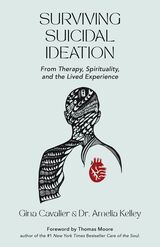 Surviving Suicidal Ideation: From Therapy to Spirituality and the Lived Experience
Gina Cavalier and Amelia Kelley
Swedenborg Foundation Publishers, 2024 A guide to help those who experience suicidal ideation heal and find peace.
Surviving Suicidal Ideation embarks on a profound journey through the underlying causes, stages, and powerful emotions that shape the experience of having suicidal thoughts. More importantly, it provides proven tools, exercises, and steps to curtail and heal this preventable condition. With sensitivity and clarity, Dr. Amelia Kelley and Gina Cavalier explore the interconnectedness of addiction, mental health, and trauma.
Using a unique combination of analytic and spiritual practices, mindfulness, cutting-edge brain therapy, and compassionate support, this book offers therapies and self-help techniques with corresponding exercises; hand-inked illustrations by Cavalier; a foreword by Thomas Moore, New York Times bestselling author of Care of the Soul; and an extensive list of resources.
As a public speaker, Cavalier focuses on memoir-style storytelling about living with suicidal ideation. Together, the authors present holistic approaches to suicide prevention and debunk prevalent myths. They also go beyond individual healing, emphasizing the importance of community and relationships. Ultimately, Surviving Suicidal Ideation provides a nonjudgmental guide that enables the reader to develop self-compassion and work toward a positive future filled with hope and resilience.
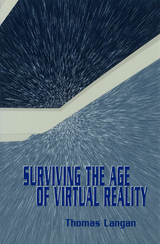 Surviving the Age of Virtual Reality
Thomas Langan
University of Missouri Press, 2000
As the technological phenomenon known as the worldwide web permeates civilization, it creates some cultures and destroys others. In this pioneering book, philosopher Thomas Langan explores "virtual reality"Can inherently contradictory phrase"and the effects of technology on our very being. In our present-day high- technology environment, making simple, everyday decisions is difficult because the virtual world we've created doesn't necessarily operate according to the old "common sense." To retain our intellectual fitness, we must, Langan argues, consider these essential questions: If virtual reality is, in fact, reality, what is this life that we are caught up in? What is being within the context of virtual reality? How can we establish a system for distinguishing truth from fiction?
Although technology minimizes distances between people and makes the information they seek more accessible, it simultaneously blurs the line dividing fact from falsehood and real from virtual. An individual's intellectual survival is threatened as technological advancement challenges our collective understanding of what reality is. Because much of the information that is presented as fact simply works to fulfill a specific agenda, we cannot accept as truth everything that appears on the internet or in the media. To survive, we must learn to manage our lives and resources despite the flood of information we are bombarded with daily.
Addressing the general educated reader, Surviving the Age of Virtual Reality expertly interweaves the worlds of technology and philosophy, pushing the analysis of this technological and human phenomenon to new depths.
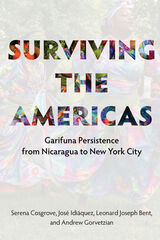 Surviving the Americas: Garifuna Persistence from Nicaragua to New York City
Serena Cosgrove, José Idiáquez, Leonard Joseph Bent, and Andrew Gorvetzian
University of Minnesota Press, 2020 The Garifuna are a Central American, Afro-Indigenous people descended from shipwrecked West Africans and local Indigenous groups on the Caribbean island of St. Vincent. For over two centuries, the Garifuna have experienced oppression, exile, and continued diaspora that has stretched their communities to Honduras, Belize, and beyond. However, little has been written about the experiences of the Garifuna in Nicaragua, a community of about 5,000 who live primarily on the Caribbean coast of the country.
In Surviving the Americas, Serena Cosgrove, José Idiáquez, Leonard Joseph Bent, and Andrew Gorvetzian shed light on what it means to be Garifuna today, particularly in Nicaragua. Their research includes over nine months of fieldwork in Garifuna communities in the Pearl Lagoon on the southern Caribbean coast of Nicaragua and in New York City. The resulting ethnography illustrates the unique social issues of the Nicaraguan Garifuna and how their culture, traditions, and reverence for their ancestors continues to persist.
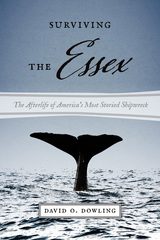 Surviving the Essex: The Afterlife of America's Most Storied Shipwreck
David O. Dowling
University Press of New England, 2016 Surviving the “Essex” tells the captivating story of a ship’s crew battered by whale attack, broken by four months at sea, and forced—out of necessity—to make meals of their fellow survivors. Exploring the Rashomon-like Essex accounts that complicate and even contradict first mate Owen Chase’s narrative, David O. Dowling examines the vital role of viewpoint in shaping how an event is remembered and delves into the ordeal’s submerged history—the survivors’ lives, ambitions, and motives, their pivotal actions during the desperate moments of the wreck itself, and their will to reconcile those actions in the short- and long-term aftermath of this storied event. Mother of all whale tales, Surviving the “Essex” acts as a sequel to Nathaniel Philbrick’s In the Heart of the Sea, while probing deeper into the nature of trauma and survival accounts, an extreme form of notoriety, and the impact that the story had on Herman Melville and the writing of Moby-Dick.
 Surviving the Holocaust: The Kovno Ghetto Diary
Avraham Tory
Harvard University Press, 1990 This remarkable chronicle of life and death in the Jewish Ghetto of Kovno, Lithuania, from June 1941 to January 1944, was written under conditions of extreme danger by a Ghetto inmate and secretary of the Jewish Council. After the war, in order to escape from Lithuania, the author was forced to entrust the diary to leaders of the Escape movement; eventually it made its way to his new home in Israel.
The diary incorporates Avraham Tory’s collections of official documents, Jewish Council reports, and original photographs and drawings made in the Ghetto. It depicts in grim detail the struggle for survival under Nazi domination, when—if not simply carted off and murdered in a random “action”—Jews were exploited as slave labor while being systematically starved and denied adequate housing and medical care. Through it all, Tory’s overriding purpose was to record the unimaginable events of these years and to memorialize the determination of the Jews to sustain their community life in the midst of the Nazi terror.
Of the surviving diaries originating in the principal European Ghettos of this period, Tory’s is the longest written by an adult, a dramatic and horrifying document that makes an invaluable contribution to contemporary history. Tory provides an insider’s view of the desperate efforts of Ghetto leaders to protect Jews. Martin Gilbert’s masterly introduction establishes the authenticity of the diary, presents its events against the backdrop of the war in Europe, and considers the crucial questions of collaboration and resistance.
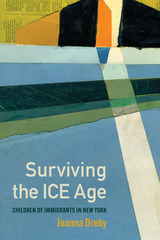 Surviving the ICE Age: Children of Immigrants in New York
Joanna Dreby
Russell Sage Foundation, 2025 For the past three decades, U.S. immigration policy has become increasingly restrictive, focused on enforcement both at the southern border and across the country. A shift in emphasis from status regularization to criminalization has had rippling effects for families and communities. While we know much about how immigration enforcement impacts the undocumented, we know less about longstanding effects on U.S. citizens. In Surviving the ICE Age, sociologist Joanna Dreby draws on interviews with young adults with foreign-born parents to better understand what it was like to grow up during a time of heightened U.S. migratory control.
Dreby shows that a restrictive approach to immigration creates problems over time and across generations. These issues occur regardless of one’s citizenship status and go beyond deportations. Despite having pride in their heritage, her interviewees did not talk much about immigration. She refers to this unwillingness—and at times, inability—to speak about immigration as silencing. Silencing in a community or family is often intended to protect children, but this can leave them with little information about their backgrounds and status, leading to fear and anxiety instead. Self-silencing often resulted from traumatic experiences tied to enforcement episodes, which sometimes took the form of memory loss or emotional withholding. Dreby finds that experiences with the immigration system that disrupted relationships in a child’s household arising from family separations, moves, or changing roles in the family had especially long-term effects, causing, at times, ongoing mental health issues. Even the risk of immigration involvement left some young adults feeling vulnerable and undermined their sense of safety and security as U.S. citizens.
Dreby also highlights stories that offer hope. Young adults developed strategies to persevere, and children who grew up in communities and families that openly talked about migration felt empowered and fared much better, especially when they had access to resources, such as adequate food and shelter, mental health services, and community support. Dreby calls for policies and practices to mitigate the harms of restrictive migratory control on children’s wellbeing, such avoiding the arrest of parents in front of children and ensuring that U.S. citizen children’s interests are considered in immigration court without their direct involvement.
Surviving the ICE Age details the generational harms caused by U.S. immigration policy and offers suggestions for a better way forward.
Surviving the Peace: The Struggle for Postwar Recovery in Bosnia-Herzegovina
Peter Lippman
Vanderbilt University Press Surviving the Peace is a monumental feat of ground-level reporting describing two decades of postwar life in Bosnia, specifically among those fighting for refugee rights of return. Unique in its breadth and profoundly humanitarian in its focus, Surviving the Peace situates digestible explanations of the region's bewilderingly complex recent history among interviews, conversations, and tableaus from the lives of everyday Bosnians attempting to make sense of what passes for normal in a postwar society. Essential reading for students of the former Yugoslavia and anyone interested in postwar or post-genocide studies, Surviving the Peace is an instant classic of long-form reporting, an impossible accomplishment without a lifetime of dedication to a place and people. Peter Lippman's website is http://survivingthepeace.org/.
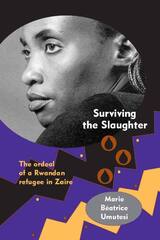 Surviving the Slaughter: The Ordeal of a Rwandan Refugee in Zaire
Marie Beatrice Umutesi; Foreword by Catharine Newbury
University of Wisconsin Press, 2004 Though the world was stunned by the horrific massacres of Tutsi by the Hutu majority in Rwanda beginning in April 1994, there has been little coverage of the reprisals that occurred after the Tutsi gained political power. During this time hundreds of thousands of Hutu were systematically hunted and killed.
Surviving the Slaughter: The Ordeal of a Rwandan Refugee in Zaire is the eyewitness account of Marie Béatrice Umutesi. She tells of life in the refugee camps in Zaire and her flight across 2000 kilometers on foot. During this forced march, far from the world’s cameras, many Hutu refugees were trampled and murdered. Others died from hunger, exhaustion, and sickness, or simply vanished, ignored by the international community and betrayed by humanitarian organizations. Amidst this brutality, day-to-day suffering, and desperate survival, Umutesi managed to organize the camps to improve the quality of life for women and children.
In this first-hand account of inexplicable brutality, day-to-day suffering, and survival, Marie Béatrice Umutesi sheds light on a backlash of violence that targeted the Hutu refugees of Rwanda after the victory of the Rwandan Patriotic Front in 1994. Umutesi’s documentation of the flight and terror of these years provides the world a veritable account of a history that is still widely unknown. After translations from its original French into three other languages, this important book is available in English for the first time. It is more than a testimony to the lives and humanity lost; it is a call for those politicians, military personnel, and humanitarian organizations responsible for the atrocious crimes—and the devastating silence—to be held accountable.
“Umutesi’s tale, told with honesty and eloquence, is a tribute to the human spirit, a searing indictment of the agents who perpetrated these horrors, and a reproach to those who turned away.”—Catharine Newbury, African Studies Review
“Restores a human dimension that has been lacking in the history of the genocide and massacres in Rwanda.”—Danielle de Lame, African Studies Review
“A vivid account of the grueling nightmare experienced by tens of thousands of Rwandan civilians whom the world had deliberately forsaken. . . . An outstanding call for justice.”—Aloys Habimama, African Studies Review
“A towering work. . . . An epic for our times, a tale to ponder for the lessons it conveys, testimony so powerful and moving that it reaches an unintended literary greatness.”—Jan Vansina, African Studies Review
“Of all the current books and films ten years after the Rwandan genocide, none is more effective than Surviving the Slaughter . . . . This book carries one along, often as if running with the refugees.”—Anne Serafin, Multicultural Review
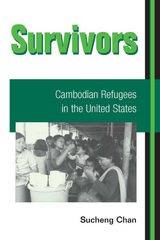 Survivors: CAMBODIAN REFUGEES IN THE UNITED STATES
Sucheng Chan
University of Illinois Press, 2004 In this clear, comprehensive, and unflinching study, Sucheng Chan invites us to follow the saga of Cambodian refugees striving to distance themselves from a series of cataclysmic events in their homeland. Survivors tracks not only the Cambodians' fight for life lives but also their battle for self-definition in new American surroundings.
Unparalleled in scope, Survivors begins with the Cambodians' experiences under the brutal Khmer Rouge regime, following them through escape to refugee camps in Thailand and finally to the United States, where they try to build new lives in the wake of massive trauma. Their struggle becomes primarily economic as they continue to negotiate new cultures and deal with rapidly changing gender and intergenerational relations within their own families. Poverty, crime, and racial discrimination all have an impact on their experiences in America, and each is examined in depth.
Although written as a history, this is a thoroughly multidisciplinary study, and Chan makes use of research from anthropology, sociology, psychology, medicine, social work, linguistics and education. She also captures the perspective of individual Cambodians. Drawing on interviews with more than fifty community leaders, a hundred government officials, and staff members in volunteer agencies, Survivors synthesizes the literature on Cambodian refugees, many of whom come from varying socioeconomic backgrounds.
A major scholarly achievement, Survivors is unique in the Asian American canon for its memorable presentation of cutting-edge research and its interpretation of both sides of the immigration process.
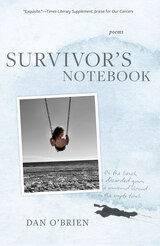 Survivor's Notebook: Poems
Dan O'Brien
Acre Books, 2023 A collection of prose poems that chronicles the family life of two cancer survivors.
Dan O’Brien’s powerful companion to Our Cancers catalogs the recovery of a cancer survivor, whose wife has recently survived her own cancer, as he returns to his daily life while raising a young daughter. This prose-poem sequence is a true survivor’s notebook, using photos and the tools of memoir to evoke how disaster can constellate our past, present, and future.
In his poems, plays, and nonfiction, Dan O’Brien has explored, as he says in a 2023 interview, “how trauma shatters identity, and in its aftermath we reconfigure and rewrite, as it were, the story of who we were and are and maybe will be.” In highly personal poems reminiscent of dramatic monologues, as well as shorter lyric fragments, the protagonist reconsiders the people and places he knew before his illness, including his estranged family and others with cancer. While looking back he moves forward again, resuming his career as a writer and teacher, revisiting Ireland, and making a kind of pilgrimage to the Holy Land. There is a confiding and at times comical tone in these poems as O’Brien awakens to the delights, absurdities, and wonders of existence, and as he and his wife work through the aftershocks of their trauma toward a deeper love.
With text and image, Survivor’s Notebook shows how we go on, with resilience, gratitude, and joy, when “the emergency’s elsewhere” now.
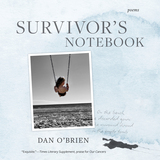 Survivor's Notebook: Poems
Dan O’Brien
Acre Books, 2023 This powerful companion to 2021’s Our Cancers catalogs the recovery of a cancer survivor, whose wife has recently survived her own cancer, as he returns to his daily life while raising a young daughter. This prose-poem sequence is truly a survivor’s notebook, using the tools of memoir to evoke the ways in which disaster can constellate our past, present, and future.
In his poems, plays, and nonfiction, Dan O’Brien has explored, as he says in a 2023 interview, “how trauma shatters identity, and in its aftermath we reconfigure and rewrite, as it were, the story of who we were and are and maybe will be.” In highly personal poems reminiscent of dramatic monologues, as well as shorter lyric fragments, the protagonist reconsiders the people and places he knew before his illness, including his estranged family and others with cancer. While looking back he moves forward again, revisiting Ireland, resuming his career as a writer and teacher, and making a kind of pilgrimage to the Holy Land. There is a confiding and at times comical tone in these poems, as he awakens to the delights, absurdities, and wonders of existence, and as he and his wife work through the aftershocks of their trauma toward a deeper love.
Survivor’s Notebook shows how we go on, with resilience, gratitude, and joy, when “the emergency’s elsewhere” now.
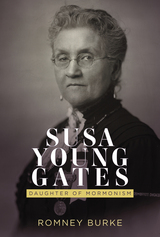 Susa Young Gates: Daughter of Mormonism
Romney Burke
Signature Books, 2022 Brigham Young had dozens of wives and numerous children, but none have better name recognition than Susa Young Gates. Yet she, like so many women of Mormonism’s past, has remained a mystery to most church members. In Susa Young Gates, Romney Burke paints a portrait of a strong woman who rose to prominence within the church, fought for the rights of women throughout the country, yet dealt with personal trials and her share of heartbreak.
After divorcing her first husband, Alma Dunford, the trauma associated with that union was such that she steadfastly refused to mention it ever again. She also lost some of her children over the course of her life and was unable to reconcile her older sister’s departure from the LDS Church and conversion to Catholicism. Yet despite her trials, Susa found fulfillment in her faith through service, as a prolific writer—co-authoring with her daughter Leah Dunford Widtsoe the 1930 biography of her father, Life Story of Brigham Young, founding the Young Women’s Journal in 1889, the Relief Society Magazine in 1915, and in her associations with such prominent women’s advocates such as Susan B. Anthony.
Susan Glaspell in Context: American Theater, Culture, and Politics, 1915-48
J. Ellen Gainor
University of Michigan Press, 2003
Susan Glaspell in Context not only discusses the dramatic work of this key American author -- perhaps best known for her short story "A Jury of Her Peers" and its dramatic counterpart, Trifles -- but also places it within the theatrical, cultural, political, social, historical, and biographical climates in which Glaspell's dramas were created: the worlds of Greenwich Village and Provincetown bohemia, of the American frontier, and of American modernism.
J. Ellen Gainor is Professor of Theatre, Women's Studies, and American Studies, Cornell University. Her other books include Performing America: Cultural Nationalism in American Theater (co-edited with Jeffrey D. Mason) from the University of Michigan Press.
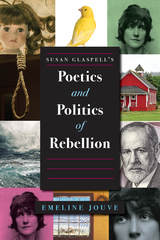 Susan Glaspell's Poetics and Politics of Rebellion
Emeline Jouve
University of Iowa Press, 2017 A pioneer of American modern drama and founding member of the Provincetown Players, Susan Glaspell (1876–1948) wrote plays of a kind that Robert Brustein defines as a “drama of revolt,” an expression of the dramatists’ discontent with the prevailing social, political, and artistic order. Her works display her determination to put an end to the alienating norms that, in her eyes and those of her bohemian peers, were stifling American society. This determination both to denounce infringements on individual rights and to reform American life through the theatre shapes the political dimension of her drama of revolt.
Analyzing plays from the early Trifles (1916) through Springs Eternal (1943) and the undated, incomplete Wings, author Emeline Jouve illustrates the way that Glaspell’s dramas addressed issues of sexism, the impact of World War I on American values, and the relationship between individuals and their communities, among other concerns. Jouve argues that Glaspell turns the playhouse into a courthouse, putting the hypocrisy of American democracy on trial. In staging rebels fighting for their rights in fictional worlds that reflect her audience’s extradiegetic reality, she explores the strategies available to individuals to free themselves from oppression. Her works envisage a better future for both her fictive insurgents and her spectators, whom she encourages to consider which modes of revolt are appropriate and effective for improving the society they live in. The playwright defines social reform in terms of collaboration, which she views as an alternative to the dominant, alienating social and political structures. Not simply accusing but proposing solutions in her plays, she wrote dramas that enacted a positive revolt.
A must for students of Glaspell and her contemporaries, as well as scholars of American theatre and literature of the first half of the twentieth century.
Susan Sontag: A Biography
Daniel Schreiber; Translated from the German by David Dollenmayer
Northwestern University Press, 2014 While known primarily as a cultural critic and novelist, Sontag was also a filmmaker, stage director, and dramatist. It was her status as a pop icon that was unusual for an American intellectual: she was filmed by Andy Warhol and Woody Allen, photographed by Annie Leibovitz and Diane Arbus, and her likeness adorned advertisements for Absolut vodka. Drawing on newly available sources, including interviews with Nadine Gordimer, Robert Wilson, and Sontag’s son, David Rieff, as well as on myriad interviews given by Sontag and her extensive correspondence with her friend and publisher Roger Straus, Schreiber explores the roles that Sontag played in influencing American public cultural and political conversations.
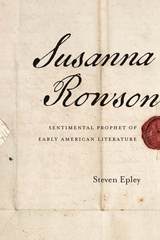 Susanna Rowson: Sentimental Prophet of Early American Literature
Steven Epley
Northwestern University Press, 2016 Susanna Rowson: Sentimental Prophet of Early American Literature opens the early American writer’s works to new, provocative interpretations based on the theory that her responses to social issues incorporate notions of righteousness, justice, accountability, and loyalty drawn from prophets in the Hebrew Bible. Steven Epley argues that Rowson’s sentimentalism—a literary mode that portrays characters undergoing strong emotions and evokes similar responses from readers—reflects the rhetorical style of the Bible’s first prophet, Moses, and its understanding of the “heart” not just as a metaphor for human kindness and tenderness but also as a source of wickedness. Epley relocates the widespread introduction of Jewish values into American discourse from the height of Jewish immigration (roughly 1890 to 1940) to the early republic, given Rowson’s vast audience and influence on American letters. Her novel Charlotte Temple outsold every other American work of fiction until Harriet Beecher Stowe’s Uncle Tom’s Cabin in the 1850s.
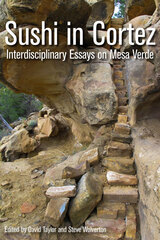 Sushi in Cortez: Interdisciplinary Essays on Mesa Verde
David Taylor and Steve Wolverton
University of Utah Press, 2015 The Mesa Verde region is one of the most popular tourist destinations in the world and is an area fraught with complexities, anomalies, and layers of histories. Sushi in Cortez is a collection of essays by an interdisciplinary group of academics, artists, and cultural observers that explores this diverse landscape and heritage by combining and sharing the differing perspectives provided by various disciplines. Poetry, film, environmental philosophy, nature photography, native Pueblo perspectives, and archaeology are used to touch on the common questions people ask about the value of their work and lives as well as the value of visiting ancient sites such as Mesa Verde. The authors share personal stories about the difficulties, joys, confusions, and epiphanies they experienced as they crossed the boundaries of their professional lives, coming to understand how incomplete any single rendition of place can be. Find additional images on our website www.uofupress.com.
Take a look inside the authors’ Mesa Verde experience in this short film,“Location Fracture” by Melinda Levin.
 Suspect Citizens: Women, Virtue, and Vice in Backlash Politics
Jocelyn Boryczka
Temple University Press, 2012 What drives the cycle of backlashes against women’s ongoing struggle for equality, freedom, and inclusion in American politics? In her innovative and provocative book, Suspect Citizens, Jocelyn Boryczka presents a feminist conceptual history that shows how American politics have largely defined women in terms of their reproductive and socializing functions. This framework not only denies women full citizenship, but also devalues the active political engagement of all citizens who place each other and their government under suspicion. Developing the gendered dynamics of virtue and vice, Boryczka exposes the paradox of how women are perceived as both virtuous moral guardians and vice-ridden suspect citizens capable of jeopardizing the entire nation’s exceptional future. She uses wide-ranging examples from the Puritans and contemporary debates over sex education to S&M lesbian feminists and the ethics of care to show how to move beyond virtue and vice to a democratic feminist ethics. Suspect Citizens advances a politics of collective responsibility and belonging.
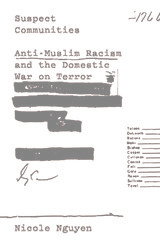 Suspect Communities: Anti-Muslim Racism and the Domestic War on Terror
Nicole Nguyen
University of Minnesota Press, 2019 The first major qualitative study of “countering violent extremism” in key U.S. cities
Suspect Communities is a powerful reassessment of the U.S. government’s “countering violent extremism” (CVE) program that has arisen in major cities across the United States since 2011. Drawing on an interpretive qualitative study, it examines how the concept behind CVEaimed at combating homegrown terrorism by engaging Muslim community members, teachers, and religious leaders in monitoring and reporting on young peoplehas been operationalized through the everyday work of CVE actors, from high-level national security workers to local community members, with significant penalties for the communities themselves. Nicole Nguyen argues that studying CVE provides insight into how the drive to bring liberal reforms to contemporary security regimes through “community-driven” and “ideologically ecumenical” programming has in fact further institutionalized anti-Muslim racism in the United States. She forcefully contends that the U.S. security state has designed CVE to legitimize and shore up support for the very institutions that historically have criminalized, demonized, and dehumanized communities of color, while appearing to learn from and attenuate past practices of coercive policing, racial profiling, and political exclusion. By undertaking this analysis, Suspect Communities offers a vital window into the inner workings of the U.S. security state and the devastating impact of CVE on local communities.
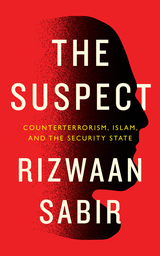 The Suspect: Counterterrorism, Islam, and the Security State
Rizwaan Sabir
Pluto Press, 2021 'An instant classic. Sabir is an inspiration' Arun Kundnani, author of The Muslims are Coming!
What impact has two decades' worth of policing and counterterrorism had on the state of mind of Muslims in Britain? The Suspect draws on the author's lived experiences of being suspected of terrorism to take the reader on a journey through British counterterrorism practices and the policing of Muslims.
Rizwaan Sabir describes what led to his arrest for suspected terrorism, his time in detention, and the surveillance he was subjected to on release from custody, including stop and frisk on the roadside, detentions at the border, and monitoring by police and government departments throughout his research.
Writing publicly for the first time about the traumatizing mental health effects of these experiences, he argues that these harmful outcomes are not the result of errors in government planning, but the consequences of using a counterinsurgency warfare approach to surveillance. If we are to break this injustice, we need to resist counterterrorism policy and practice.
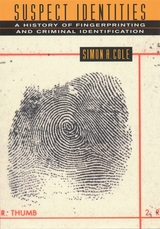 Suspect Identities: A History of Fingerprinting and Criminal Identification
Simon A. Cole
Harvard University Press, 2001 “No two fingerprints are alike,” or so it goes. For nearly a hundred years fingerprints have represented definitive proof of individual identity in our society. We trust them to tell us who committed a crime, whether a criminal record exists, and how to resolve questions of disputed identity.
But in Suspect Identities, Simon Cole reveals that the history of criminal identification is far murkier than we have been led to believe. Cole traces the modern system of fingerprint identification to the nineteenth-century bureaucratic state, and its desire to track and control increasingly mobile, diverse populations whose race or ethnicity made them suspect in the eyes of authorities. In an intriguing history that traverses the globe, taking us to India, Argentina, France, England, and the United States, Cole excavates the forgotten history of criminal identification—from photography to exotic anthropometric systems based on measuring body parts, from fingerprinting to DNA typing. He reveals how fingerprinting ultimately won the trust of the public and the law only after a long battle against rival identification systems.
As we rush headlong into the era of genetic identification, and as fingerprint errors are being exposed, this history uncovers the fascinating interplay of our elusive individuality, police and state power, and the quest for scientific certainty. Suspect Identities offers a necessary corrective to blind faith in the infallibility of technology, and a compelling look at its role in defining each of us.
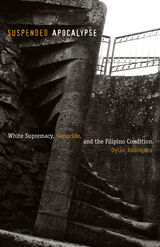 Suspended Apocalypse: White Supremacy, Genocide, and the Filipino Condition
Dylan Rodríguez
University of Minnesota Press, 2009 Suspended Apocalypse is a rich and provocative meditation on the emergence of the Filipino American as a subject of history. Culling from historical, popular, and ethnographic archives, Dylan Rodríguez provides a sophisticated analysis of the Filipino presence in the American imaginary. Radically critiquing current conceptions of Filipino American identity, community, and history, he puts forth a genealogy of Filipino genocide, rooted in the early twentieth-century military, political, and cultural subjugation of the Philippines by the United States. Suspended Apocalypse critically addresses what Rodríguez calls "Filipino American communion," interrogating redemptive and romantic notions of Filipino migration and settlement in the United States in relation to larger histories of race, colonial conquest, and white supremacy. Contemporary popular and scholarly discussions of the Filipino American are, he asserts, inseparable from their origins in the violent racist regimes of the United States and its historical successor, liberal multiculturalism. Rodríguez deftly contrasts the colonization of the Philippines with present-day disasters such as Hurricane Katrina and Mount Pinatubo to show how the global subjection of Philippine, black, and indigenous peoples create a linked history of genocide. But in these juxtapositions, Rodríguez finds moments and spaces of radical opportunity. Engaging the violence and disruption of the Filipino condition sets the stage, he argues, for the possibility of a transformation of the political lens through which contemporary empire might be analyzed, understood, and perhaps even overcome.
 The Suspended Passion: Interviews
Marguerite Duras
Seagull Books, 2016 A controversial figure of the postwar French literary and cultural scene, Marguerite Duras has exerted a powerful hold on readers around the world. This volume of interviews—hailed on its French publication as Duras’s “secret confession”—offers readers a rich vein of new insight into her work, opinions, life, and relationships.
The interviews that make up the book were conducted in 1987, when Italian journalist Leopoldina Pallotta della Torre met the seventy-three-year-old Duras at her Paris flat and convinced her to sit for a series of conversations. The resulting book was published in Italian in 1989, but it somehow failed to attract a French publisher, and it was quickly forgotten. Nearly a quarter of a century later, however, the book was rediscovered and translated into French, and, it has now become a sensation. In its revealing pages, Duras speaks with extraordinary freedom about her life as a writer, her relationship to cinema, her friendship with Mitterand , her love of Chekhov and football, and, perhaps most significantly, her childhood in pre-war Vietnam, the experiences that propelled her most famous novel, The Lover.
A true literary event, finally available in English, The Suspended Passion is a remarkable document of an extraordinary literary life.
Suspense in the Formula Story
George N. Dove
University of Wisconsin Press, 1989 Dove states that the purpose of this book is "to develop a theoretical base for a critical approach to the interpretation of the formula story." Such an approach should take into account the relationship between author and reader that determines such tacit agreements as the two axioms of formula fiction, the reader-knowledge convention, and the signals that pass between author and reader. Specifically, the chief concern of this book will be the criticism/interpretation of the mystery.
 Suspicion: A Novel
Laura Grimaldi
University of Wisconsin Press, 2003 In the shadow of the "Monster of Florence," a serial murderer who has terrorized Italy for seventeen years, Laura Grimaldi sets her tense psychological thriller Suspicion—a noir mystery of a city transformed by fear, and of friendships and family ties twisted by uncertainty and dark speculation. Grimaldi, whose hardboiled mysteries of the 1950s earned her the title "Italy’s queen of crime," turns here to the deeper, more elusive and disturbing questions that haunt human affairs.
For years Matilde, the widow of a prominent Florentine doctor, has lived alone with her eccentric middle-aged son, Enea. When the police pay a call, the balance between mother and son is shifted just subtly enough to make Matilde prey to suspicions and doubts that grow ever more corrosive, ever harder to conceal and more dangerous to reveal. In the literary tradition of such mystery writers as Patricia Highsmith and Ruth Rendell, Grimaldi creates an atmosphere charged with suspense as the daily lives and routines of her characters, infected with suspicion, begin to rearrange themselves around a few frightening facts and infinite monstrous possibilities.
Matilde’s efforts to decipher Enea’s secretive movements and occupations appear perfectly sensible and defensible through Grimaldi’s deft shifts between mother and son—and another, chillingly detached perspective on the gruesome murders. Grimaldi’s readers will find themselves as subject to misinterpretation and doubt, to sympathies and suspicions as her Florentine characters, and spellbound until the book’s final page.
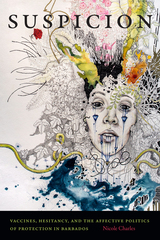 Suspicion: Vaccines, Hesitancy, and the Affective Politics of Protection in Barbados
Nicole Charles
Duke University Press, 2021 In 2014 Barbados introduced a vaccine to prevent certain strains of the human papillomavirus (HPV) and reduce the risk of cervical cancer in young women. Despite the disproportionate burden of cervical cancer in the Caribbean, many Afro-Barbadians chose not to immunize their daughters. In Suspicion, Nicole Charles reframes Afro-Barbadian vaccine refusal from a question of hesitancy to one of suspicion. Drawing on ethnographic fieldwork, black feminist theory, transnational feminist studies and science and technology studies, Charles foregrounds Afro-Barbadians' gut feelings and emotions and the lingering trauma of colonial and biopolitical violence. She shows that suspicion, far from being irrational, is a fraught and generative affective orientation grounded in concrete histories of mistrust of government and coercive medical practices foisted on colonized peoples. By contextualizing suspicion within these longer cultural and political histories, Charles troubles traditional narratives of vaccine hesitancy while offering new entry points into discussions on racialized biopolitics, neocolonialism, care, affect, and biomedicine across the Black diaspora.
Duke University Press Scholars of Color First Book Award recipient
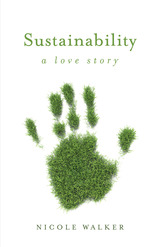 Sustainability: A Love Story
Nicole Walker
Ohio State University Press, 2018 In Sustainability: A Love Story, Nicole Walker questions what it means to live sustainably while still being able to have Internet and eat bacon. After all, who wants to listen to a short, blond woman who is mostly a hypocrite anyway—who eats cows, drives a gasoline-powered car, who owns no solar panels—tsk-tsking them? Armed with research and a bright irony that playfully addresses the devastation of the world around us, Walker delves deep into scarcity and abundance, reflecting on matters that range from her uneasy relationship with bats to the fragility of human life, from adolescent lies to what recycling can reveal about our not so moderate drinking habits. With laugh-out-loud sad-funny moments, and a stark humor, Walker appeals to our innate sense of personal commitment to sustaining our world, and our commitment to sustaining our marriages, our families, our lives, ourselves.
This book is for the burnt-out environmentalist, the lazy environmentalist, the would-be environmentalist. It’s for those who believe the planet is dying. For those who believe they are dying. And for those who question what it means to live and love sustainably, and maybe even with hope.
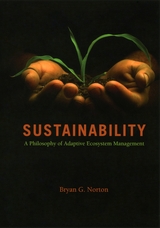 Sustainability: A Philosophy of Adaptive Ecosystem Management
Bryan G. Norton
University of Chicago Press, 2005 While many disciplines contribute to environmental conservation, there is little successful integration of science and social values. Arguing that the central problem in conservation is a lack of effective communication, Bryan Norton shows in Sustainability how current linguistic resources discourage any shared, multidisciplinary public deliberation over environmental goals and policy. In response, Norton develops a new, interdisciplinary approach to defining sustainability—the cornerstone of environmental policy—using philosophical and linguistic analyses to create a nonideological vocabulary that can accommodate scientific and evaluative environmental discourse.
Emphasizing cooperation and adaptation through social learning, Norton provides a practical framework that encourages an experimental approach to language clarification and problem formulation, as well as an interdisciplinary approach to creating solutions. By moving beyond the scientific arena to acknowledge the importance of public discourse, Sustainability offers an entirely novel approach to environmentalism.
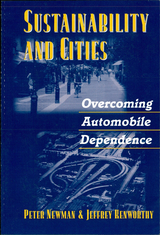 Sustainability and Cities: Overcoming Automobile Dependence
Peter Newman and Jeffrey Kenworthy
Island Press, 1999 Sustainability and Cities examines the urban aspect of sustainability issues, arguing that cities are a necessary focus for that global agenda. The authors make the case that the essential character of a city's land use results from how it manages its transportation, and that only by reducing our automobile dependence will we be able to successfully accommodate all elements of the sustainability agenda.
The book begins with chapters that set forth the notion of sustainability and how it applies to cities and automobile dependence. The authors consider the changing urban economy in the information age, and describe the extent of automobile dependence worldwide. They provide an updated survey of global cities that examines a range of sustainability factors and indicators, and, using a series of case studies, demonstrate how cities around the world are overcoming the problem of automobile dependence. They also examine the connections among transportation and other issues—including water use and cycling, waste management, and greening the urban landscape—and explain how all elements of sustainability can be managed simultaneously.
The authors end with a consideration of how professional planners can promote the sustainability agenda, and the ethical base needed to ensure that this critical set of issues is taken seriously in the world's cities.
Sustainability and Cities will serve as a source of both learning and inspiration for those seeking to create more sustainable cities, and is an important book for practitioners, researchers, and students in the fields of planning, geography, and public policy.
 Sustainability and Water Management in the Maya World and Beyond
Jean T. Larmon
University Press of Colorado, 2021 Sustainability and Water Management in the Maya World and Beyond investigates climate change and sustainability through time, exploring how political control of water sources, maintenance of sustainable systems, ideological relationships with water, and fluctuations in water availability have affected and been affected by social change. Contributors focus on and build upon earlier investigations of the global diversity of water management systems and the successes and failures of their employment, while applying a multitude of perspectives on sustainability.
The volume focuses primarily on the Precolumbian Maya but offers several analogous case studies outside the ancient Maya world that illustrate the pervasiveness of water’s role in sustainability, including an ethnographic study of the sustainability of small-scale, farmer-managed irrigation systems in contemporary New Mexico and the environmental consequences of Angkor’s growth into the world’s most extensive preindustrial settlement. The archaeological record offers rich data on past politics of climate change, while epigraphic and ethnographic data show how integrated the ideological, political, and environmental worlds of the Maya were.
While Sustainability and Water Management in the Maya World and Beyond stresses how lessons from the past offer invaluable insight into current approaches of adaptation, it also advances our understanding of those adaptations by making the inevitable discrepancies between past and present climate change less daunting and emphasizing the sustainable negotiations between humans and their surroundings that have been mediated by the changing climate for millennia. It will appeal to students and scholars interested in climate change, sustainability, and water management in the archaeological record.
Contributors: Mary Jane Acuña, Wendy Ashmore, Timothy Beach, Jeffrey Brewer, Christopher Carr, Adrian S. Z. Chase, Arlen F. Chase, Diane Z. Chase, Carlos R. Chiriboga, Jennifer Chmilar, Nicholas Dunning, Maurits W. Ertsen, Roland Fletcher, David Friedel, Robert Griffin, Joel D. Gunn, Armando Anaya Hernández, Christian Isendahl, David Lentz, Sheryl Luzzadder-Beach, Dan Penny, Kathryn Reese-Taylor, Michelle Rich, Cynthia Robin, Sylvia Rodríguez, William Saturno, Vernon Scarborough, Payson Sheets, Liwy Grazioso Sierra, Michael Smyth, Sander van der Leeuw, Andrew Wyatt
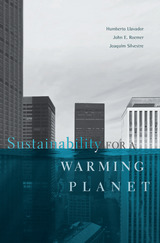 Sustainability for a Warming Planet
Humberto Llavador, John E. Roemer, and Joaquim Silvestre
Harvard University Press, 2015 Human-generated greenhouse gas emissions imperil a global resource: a biosphere capable of supporting life as we know it. What is the fair way to share this scarce resource across present and future generations, and across regions of the world? This study offers a new perspective based on the guiding ethics of sustainability and egalitarianism.
Sustainability is understood as a pattern of economic activity over time that sustains a given rate of growth of human welfare indefinitely. To achieve this, the atmospheric concentration of carbon must be capped at some level not much higher than exists today, and investments in education and research should be higher than they currently are. International cooperation between developing and developed nations is also vital, because economic growth and the climate problem are intertwined.
The authors propose that the guiding principle of bargaining should be that the dates at which developing countries’ living standards catch up with those of developed countries should not be altered by the agreement. They conclude that developed economies would have to agree not to exceed 1 percent growth in per capita GDP annually, while developing nations should grow at a faster rate, but still lower than current projections, until they converge. The authors acknowledge that achieving such a dramatic slowdown would carry political and economic challenges.
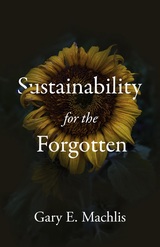 Sustainability for the Forgotten
Gary E. Machlis
University of Utah Press, 2024 Opening with the extraordinary story of a young French priest working in 1968 amongst impoverished villages of northeast Brazil, struggling to bring sustenance, sustainability, and hope to these disregarded and willfully ignored communities, this book asks a broad and far-reaching question that challenges the contemporary sustainability movement: What about sustainability for the forgotten?
Sustainability for the Forgotten is an incendiary book that confronts the history, policies, and practices of sustainability. It interrogates the usefulness of current sustainability approaches for the poorest of the poor, the chronic underclass, victims of natural disasters, refugees, the oppressed, and asks, how can we do better? With examples that range from the coffeelands of El Salvador to the coal country of American Appalachia, from the streets of Detroit to refugee camps in Greece and the upscale metro centers of the affluent, sustainability is examined with a critical eye and with an emphasis on insuring that the forgotten are heard.
At once well-researched and passionate, wide-ranging and sharply focused, Sustainability for the Forgotten is unlike any other book on the sustainability movement. Written with a distinctive voice that is reasoned, unflinching, and often poetic, the book challenges the sustainability movement to follow "a just and necessary path." The result is a provocative statement on the future of sustainability and a call to action that is ultimately hopeful.
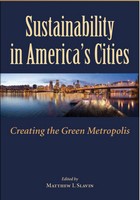 Sustainability in America's Cities: Creating the Green Metropolis
Edited by Matthew I. Slavin
Island Press, 2011 "Sustainability" is more than the latest "green" buzzword. It represents a new way of viewing the interactions of human society and the natural world. Sustainability in America's Cities highlights how America's largest cities are acting to develop sustainable solutions to conflicts between development and environment.
As sustainability rises to the top of public policy agendas in American cities, it is also emerging as a new discipline in colleges and universities. Specifically designed for these educational programs, this is the first book to provide empirically based, multi-disciplinary case studies of sustainability policy, planning, and practice in action. It is also valuable for everyone who designs and implements sustainability initiatives, including policy makers, public sector and non-profit practitioners, and consultants.
Sustainability in America's Cities brings together academic and practicing professionals to offer firsthand insight into innovative strategies that cities have adopted in renewable energy and energy efficiency, climate change, green building, clean-tech and green jobs, transportation and infrastructure, urban forestry and sustainable food production. Case studies examine sustainability initiatives in a wide range of American cities, including San Francisco, Honolulu, Philadelphia, Phoenix, Milwaukee, New York City, Portland, Oregon and Washington D.C. The concluding chapter ties together the empirical evidence and recounts lessons learned for sustainability planning and policy.
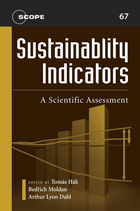 Sustainability Indicators: A Scientific Assessment
Edited by Tomas Hak, Bedrich Moldan, and Arthur Lyon Dahl; SCOPE
Island Press, 2007 While the concept of sustainability has been widely embraced, it has been only vaguely defined and is exceedingly difficult to measure. Sustainability indicators are critical to making the broad concept of sustainability operational by providing specific measures by which decision makers and the public can judge progress. Sustainability Indicators defines the present state of the art in indicator development. It presents a comprehensive assessment of the science behind various indicators, while placing special emphasis on their use as communications tools. The contributors draw on their experience as academics and practitioners to describe the conceptual challenges to measuring something as complex as sustainability at local, regional, national, and global scales. The book also reviews existing indicators to assess how they could be better employed, considering which indicators are overused and which have been underutilized. Sustainability Indicators will help planners and policy makers find indicators that are ready for application and relevant to their needs, and will help researchers identify the unresolved issues where progress is most urgently needed. All readers will find advice as to the most effective ways to use indicators to support decision making.
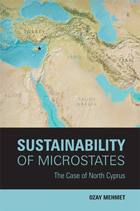 Sustainability of Microstates: The Case of North Cyprus
Ozay Mehmet
University of Utah Press, 2009 Utah Series in Middle East Studies
This interdisciplinary study discusses the development, economics, and politics of North Cyprus, a divided state since 1960 when sovereignty was surrendered by the British to both Greek and Turkish Cypriots. Mehmet works to demonstrate that, as a microstate with an area of just 3,442 square kilometers, North Cyprus possesses certain inherent comparative economic advantages in the service sectors that enable it to be sustainable in today's rapidly globalizing and competitive economic world. Mehmet bases his arguments for the potential sustainability of North Cyprus on the concept of economic rationalism, in which participating parties work to optimize their own self-interest. In an ethnic conflict like that of North Cyprus, the logic of optimization demands a rational, free, and objective balancing of competing interests to reach an agreed solution. The economic rationalist approach sharply contrasts with the highly emotional political, historical, cultural, and legal approaches that have thus far dominated the study and discussion of the Cyprus problem, approaches that have largely resulted in a protracted conflict. While recognizing the negative forces of ethnic tension and the very real possibility of a continued divided Cyprus state, Sustainability of Microstates nevertheless remains hopeful, designed to unleash the forces of convergence that may be deduced from economic rationalism, and unwavering in its conviction of the ultimate sustainability of North Cyprus.
Sustainability, Participation and Culture in Communication
Edited by Jan Servaes
Intellect Books, 2013 At a time when sustainability is on everyone’s lips, this volume is one of the first to offer an overview of sustainability and communication issues—including community mobilization, information technologies, gender and social norms, mass media, interpersonal communication, and integrated communication approaches—from a development and social change perspective. Drawing on contemporary theories of communication as well as real-world examples from development projects around the world, the contributors showcase the increasing richness and versatility of communication research and practice. Together, they make a case for adopting a more comprehensive perspective on communication in the areas of development and social change.
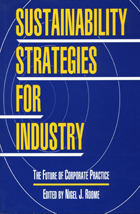 Sustainability Strategies for Industry: The Future Of Corporate Practice
Edited by Nigel J. Roome
Island Press, 1998 Sustainability Strategies for Industry contains essays by members of the Greening of Industry Network that examine the emerging picture of sustainability and its implications for industry and for the relationship between industry and other social actors -- consumers, employees, and the community at large. The book seeks to define sustainability in an industrial context, and addresses how the shift to sustainaibility will affect the role of industry in society, its managerial functions, and its relationships with stakeholders and the environment. An introductory chapter establishes the scope of the book and its contents, sets out the historical context, and explores the unifying concepts and themes running through the text. Chapters examine. the meaning of sustainability for industry from a theoretical stance corporate environmentalism company paradigms technology reporting and management systems the role of networks and systems developing country perspectives implications for business research and management educatio. Contributors -- including Thomas Gladwin, Richard Welford, Andrew Hoffman, John Ehrenfeld, and David Pearce -- offer a bold vision of the sustainable industrial organization of the future and the role and approach that managers in sustainable organizations will assume. Sustainability Strategies for Industry represents an important work for those interested in the relationship between sustainability and environmental management and protection, and for those interested in the future direction of industrial organization. It will be a valuable text for advanced undergraduate and graduate students in business and economics, as well as in environmental studies programs, and for researchers interested in business strategy and interactions between business practice and the environment.
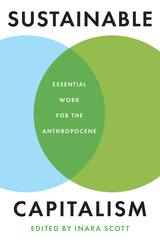 Sustainable Capitalism: Essential Work for the Anthropocene
Edited by Inara Scott
University of Utah Press, 2024 Capitalism has been linked to climate change, racism and slavery, wealth inequality, and the decline of democracy. At the same time, capitalism may have been instrumental in lifting hundreds of millions of people out of poverty, facilitating vast technological innovations, and improving standards of living across the globe. As climate change accelerates and the world is threatened with existential crises, we must ask: Is capitalism incompatible with sustainability? While this question is as complex and urgent as it is resistant to simple answers, the contributors to this volume make the case that a more sustainable capitalism is within our reach.
Sustainable Capitalism takes on the challenge of sustainability from a uniquely interdisciplinary and diverse perspective, offering both theory and tools for action. Topics range from an analysis of the foundations and definition of capitalism to the specific regulatory mechanisms that may be necessary to rein in its current, unsustainable trajectory. Readers will find nuanced and important analyses of options and potential outcomes that are not available in any other work. This book is essential reading for anyone concerned about the path we are on and how we might improve the lives of people around the globe.
https://www.sustainablecapitalismbook.com/
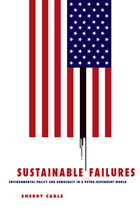 Sustainable Failures: Environmental Policy and Democracy in a Petro-dependent World
Sherry Cable
Temple University Press, 2012 Environmental policies fail in conspicuous and egregious ways to sustain the natural resource base and protect citizens from production-generated risky exposures. In her engaging study, Sustainable Failures, Sherry Cable asks, why does environmental policy seem to be a contributing cause rather than a partial solution to environmental problems? Melding a biophysical science perspective of environmental processes with sociological insights into human behavior, Cable examines the people, policies, and issues of petrochemical dependence and broader environment questions. She insists that our present policies around the manufacture and use of petroleum products violate rudimentary ecological principles—and do so in complicated ways. Sustainable Failures is a blistering wake-up call to what is at stake not only regarding the failure of policy outcomes and grievous natural resource depletion and pollution, but also concerning democracy and ecological survival, and eventually, potentially, the existence of our species.
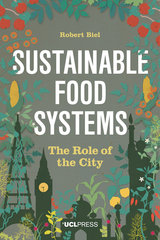 Sustainable Food Systems: The Role of the City
Robert Biel
University College London, 2016 Faced with a global threat to food security, it is perfectly possible that society will respond, not by a dystopian disintegration, but rather by reasserting co-operative traditions. This book, by a leading expert in urban agriculture, offers a genuine solution to today’s global food crisis. By contributing more to feeding themselves, cities can allow breathing space for the rural sector to convert to more organic sustainable approaches. Biel’s approach connects with current debates about agroecology and food sovereignty, asks key questions, and proposes lines of future research. He suggests that today’s food insecurity – manifested in a regime of wildly fluctuating prices – reflects not just temporary stresses in the existing mode of production, but more profoundly the troubled process of generating a new one. He argues that the solution cannot be implemented at a merely technical or political level: the force of change can only be driven by the kind of social movements which are now daring to challenge the existing unsustainable order. Drawing on both his academic research and teaching, and 15 years’ experience as a practicing urban farmer, Biel brings a unique interdisciplinary approach to this key global issue, creating a dialogue between the physical and social sciences
A Sustainable Future: 12 Key Areas of Global Concern
Edited by Klaus Wiegandt
Haus Publishing, 2017 Considering subjects as diverse yet interrelated as the earth’s water resources, renewable energy sources, climate change, the demise of natural diversity, overpopulation, and malnutrition, this book collects and accessibly presents the most up-to-date research on subjects of major global concern from twelve leading scientists.
Sustainable Harvest and Marketing of Rain Forest Products
Edited by Mark Plotkin and Lisa Famolare
Island Press, 1992 Based on a Conservation International conference in Panama, Sustainable Harvest and Marketing of Rain Forest Products brings together the world's leading experts on rain forest development and sustainability.
Sustainable High-Rise Buildings: Design, technology, and innovation
Kheir Al-Kodmany
The Institution of Engineering and Technology, 2022 The rapid increase in urban population, land prices and land preservation, urban regeneration, as well as globalization and climate change have been forcing cities to build upward. High-rises can be part of a more sustainable solution if the construction and engineering challenges are addressed before construction starts. Smart technologies are being integrated in the digital environment to allow for better energy efficiency, safety and security, and to maximize the health and well-being of the occupants.
|
|

